 USN Fleet Destroyers (1917-1947): 111 destroyers (DD-75 to DD-185)
USN Fleet Destroyers (1917-1947): 111 destroyers (DD-75 to DD-185)The Wickes-class were 111 destroyers built for the US Navy between 1917 and 1921. First of the two wartime mass-produced classes of “flush deck” hull destroyers (“four-pipers”), and improved version of the Caldwell design but faster. Seeing little from WWI for most, they served in the interwar, and met different fates: There were many reconversions, as fast minesweepers and minelayers at first, and in 1942-44 as fast assault transports (APD), where the “green dragons” won most of the awarded battlestars, landing Marine Raiders. There were also the 50 leivered to the hard-pressed RN in 1940, also used by RCN, Royal Norwegian Navy and later even the Soviet Navy. In all, 16 were lost in action. #ww2 #usn #usnavy #royalnavy #usdestroyer #caldwell #flushdecker
A new massive destroyer class
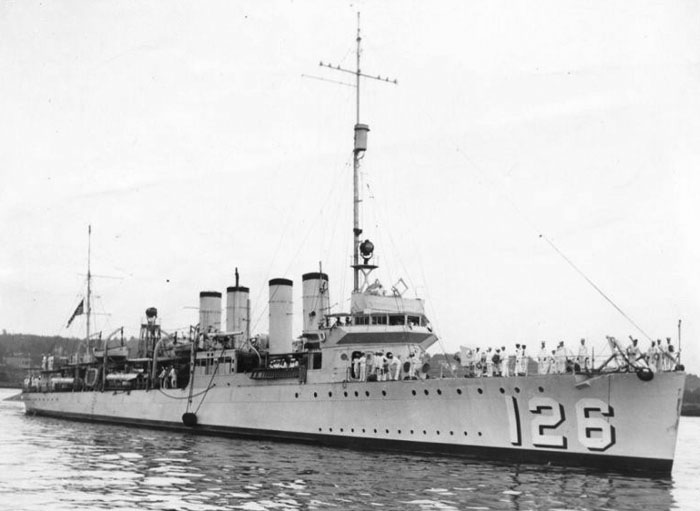
The Wickes class were built en masse in emergency, using all the combined might of US yards, specialized or not, to answer the needs of the USN committed into the Great War from April 1917.
To gain time, the previous Caldwell class was retook, even before the latter were operational or trialled, showing the great trust the admiralty placed on its new flush deck design. The initial plan of 200 destroyers was however later cancelled and curtailed to effectively 111 completed, as compared to the parrallel Clemson class, an evolution, more tailored towards the anti-submarine role, and with greater range among other. The second serie built 1918-1922 was also stopped by the Washington Treaty, and even larger than the Wickes with 162 planned, 153 completed, with a sum of improvements that went after the trials and early service acceptance of the Caldwell class.
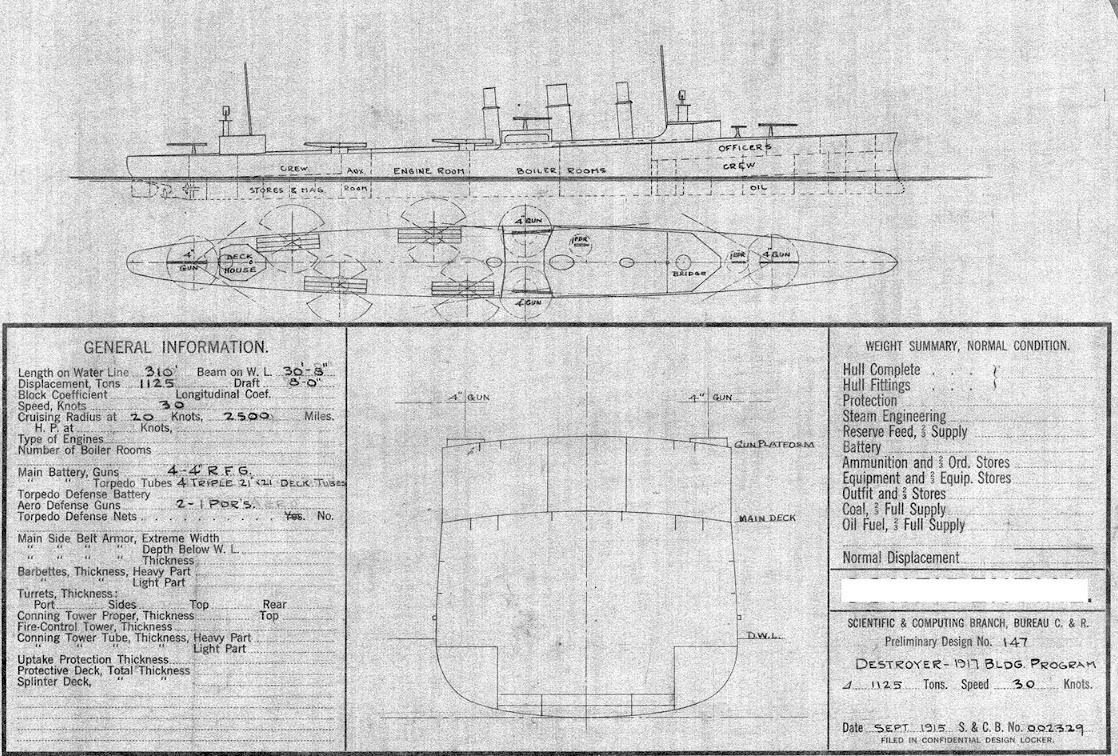
Preliminary design for the Wickes class, BuC&R 1917 program.
The US repeated this industrial feat by producing no less than 171 Fletcher-class destroyer, which, size, speed, range, armament and capabilities highlighted this 20-years gap. Neither the following Gleaves or Gearing arrived in numbers to the WWI records, but they displaced more than twice as much and had fairly long carrer for some, until the end of the cold war, whereas the Wickes/Clemsons were scrapped in 1946, after 20 years of service at best. The first were an expedient and in WW2 showed their age, whereas the second were large and capable enough to be indefinitely upgraded.
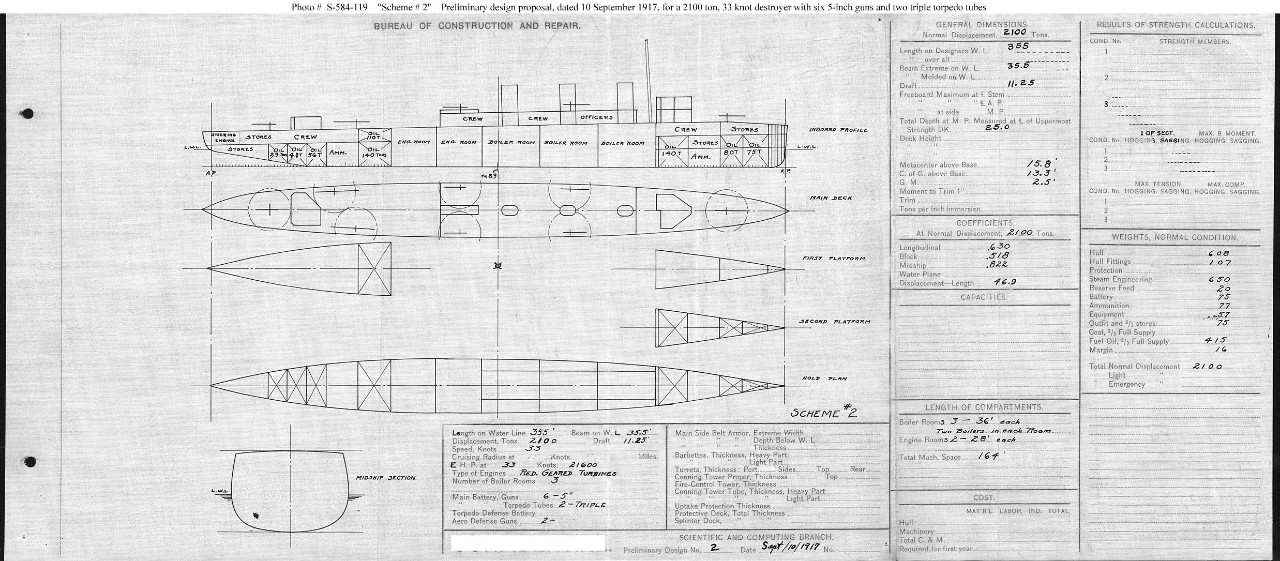
S-584-119 Large Destroyer — “Scheme # 2 … Sept. 10, 1917”, another preliminary design, second of three by Bu C&R – Initial, comparative preliminary designs prepared by the Bureau of Construction and Repair’s preliminary design staff, under the heading Preliminary Design No.192, intended to suggest the issues involved in producing much larger destroyers than those previously built for the U.S. Navy. This particular design was based on a machinery plant 50 per cent larger than that employed in the Wickes (Destroyer # 75) class destroyers then building. This plan provides six 5-inch guns and a speed of 33 knots in a ship 355 feet long on the load water line (L.W.L.), 35 feet 6 inches in beam, with a normal displacement of 2,100 tons. The original document was ink on linen (black on white). The original plan is in the 1911-1925 Spring Styles Book. U.S. Naval History and Heritage Command Photograph. src
But aside this formidable industrial effort where the US showed it muscle to the world and started to forge the century-long “pax americana”, the Wickes class were a product of their time. They were superior to most navies’ own destroyers by their speed and armament, but their simplified construction and spartan accomodations, combined to their propention to be extremely “wet” in heavy weather (in the North Atlantic in particular where they were tailored to serve) made them unpopular, especially compared from 1935 to the new generation of “gold platters”.
Of course, in the context of post-war restrictions, they were mothballed often only after a few years of service, being surplus to peacetime requirements and later to Washington’s treaty drastic tonnage revision for all categories. Worst still, many were indeed sold in 1936-39, between their general condition and age. The question of their use in WW2 trigerred quite some debate in the Admiralty even before WW2.
So this long post would be divided basically in two parts:
-WW1 design, construction and use
-Interwar experiments, WW2 conversions designs and use
But the shortened 111 career records (for the sake of time and space !) would tackle in great lines both their WW1 and WW2 records (for the few which saw service in 1918).
Design of the class
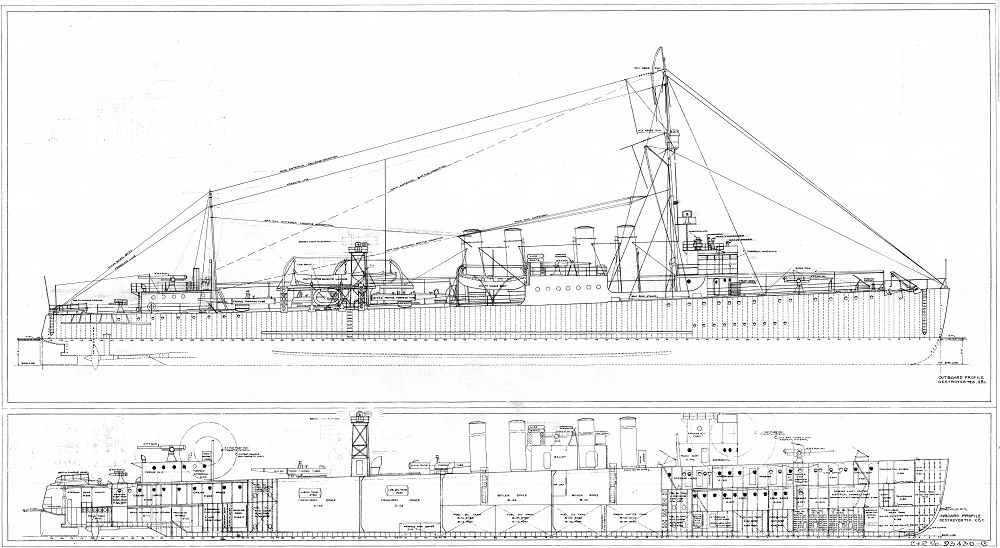
Clemson class plan: USS Doyen, DD-280
Hull and general design
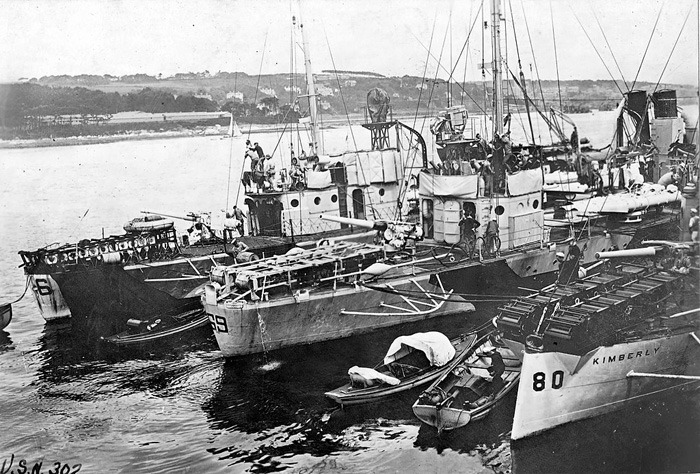
The Wickes Class Destroyer USS Kimberly DD-80 (foreground), next to USS Caldwell DD-69 and USS Allen DD-66 at Queenstown, Ireland showing their different stern. Her fine lines is clearly different than the classic “V-shaped” stern of the Caldwell class.
Displacement was established to 1,154 tons (normal) and 1,247 tons fully loaded. They had a length of 314 ft 4.5 in (95.82 m), a beam of 30 ft 11.25 in (9.43 m) and draft of 9 ft (2.74 m).
The general design was overall a repeat of the previous Caldwell, with requirements for high speed and simplifications for mass production. Clearly submarine warfare created a set of of specific requirements for numbers not envisioned before the war. The setup speed, 35 knots (65 km/h) was intended to be on par with the new Lexington battlecruisers as well as thed Omaha cruisers in construction.
The final design married the same flush deck as the Caldwell class, but also four smokestacks as standard. The fuller hull, greater beam and flush deck also added to the hull strength, but they appeared to be “wet” in heavy weather.
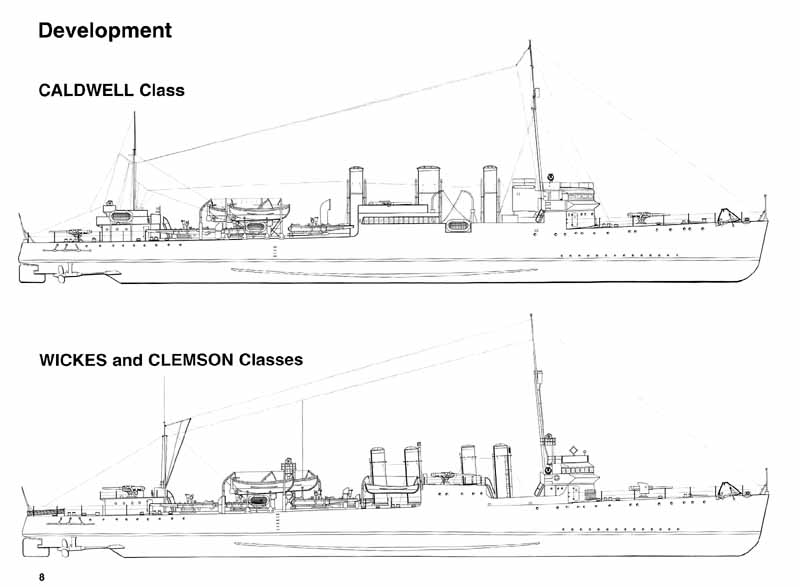
Differences between the Caldwell and Wickes class
Powerplant
The Wickes class had two propellers, driven by two Parsons geared steam turbines, rated for 24,610 hp (18,350 kW), fed in turn by four boilers, 300 psi (2,100 kPa) saturated steam.
Their powerplant was rated up to 26,000 horsepower (19,000 kW) when forcing heat, which was 6,000 horsepower (4,500 kW) more than the Caldwell class. It also provided an extra 5 knots (9.3 km/h; 5.8 mph) which was quite a leap compared to the latter. This became the new standard top (combat) speed for its fast squadrons based around the planed four battlecruisers, and to be led by the Omahas for screening the 21-knot main battlefeet.
The machinery arrangement retook part of the Caldwell ships, using two geared steam turbines, one for each shaft. The bronze propellers were kept the same, modern three-bladed broad leaf style.
Extra power needed required also approx. 100 tons more for the engine and reduction gears and so the propeller shafts were made nearly horizontal to minimize weight (instead of pointing downards). The shaft was a solid piece, extremely heavy. Differences between powerplants can be resumed here:
DD75 to 78, 131 to 134: Two Parsons geared steam turbines, four Normand boilers
DD79 to 86, 95 to 102, 161 to 170: Two Curtis steam turbines and one geared steam turbine for cruising, four Yarrow boilers
DD87 to 92, 103 to 112, 171 to 180: Two General Electric Curtis geared steam turbines, four Yarrow boilers
DD93, 94, 135 to 141: Two Parsons geared steam turbines, four Normand boilers
DD113 to 118, 125 to 130, 142 to 160: Two Parsons geared steam turbines, four White-Forster boilers
DD119 to 124, 181 to 185: Two General Electric Curtis geared steam turbines, four Thornycroft boilers
On trials, they all nominally reached 27,000 shp, but there were exceptions, like DD125 to 130 which averages 24,900 shp and DD157 to 160, 26,000 shp/
As for performances, the goal was reached. Their top speed averaged 35.3 knots (65.4 km/h; 40.6 mph).
However they proved to be very short-ranged. To compensate later 100 tons of fuel tankage was managed when practicable in the interwar. In WW2 this was no longer an issue as they were supplied at sea, by fellow battleships or dedicated tankers of the support fleet, notably in the Pacific. In heavy weather, they were noted to plough heavily and had the bridge and gun positions always wet, which was frequent in the north Atlantic. Also their new tapered stern made for depth charge dropping was a nice and innovative feature, but it dug deep into the water and increased the turning radius.
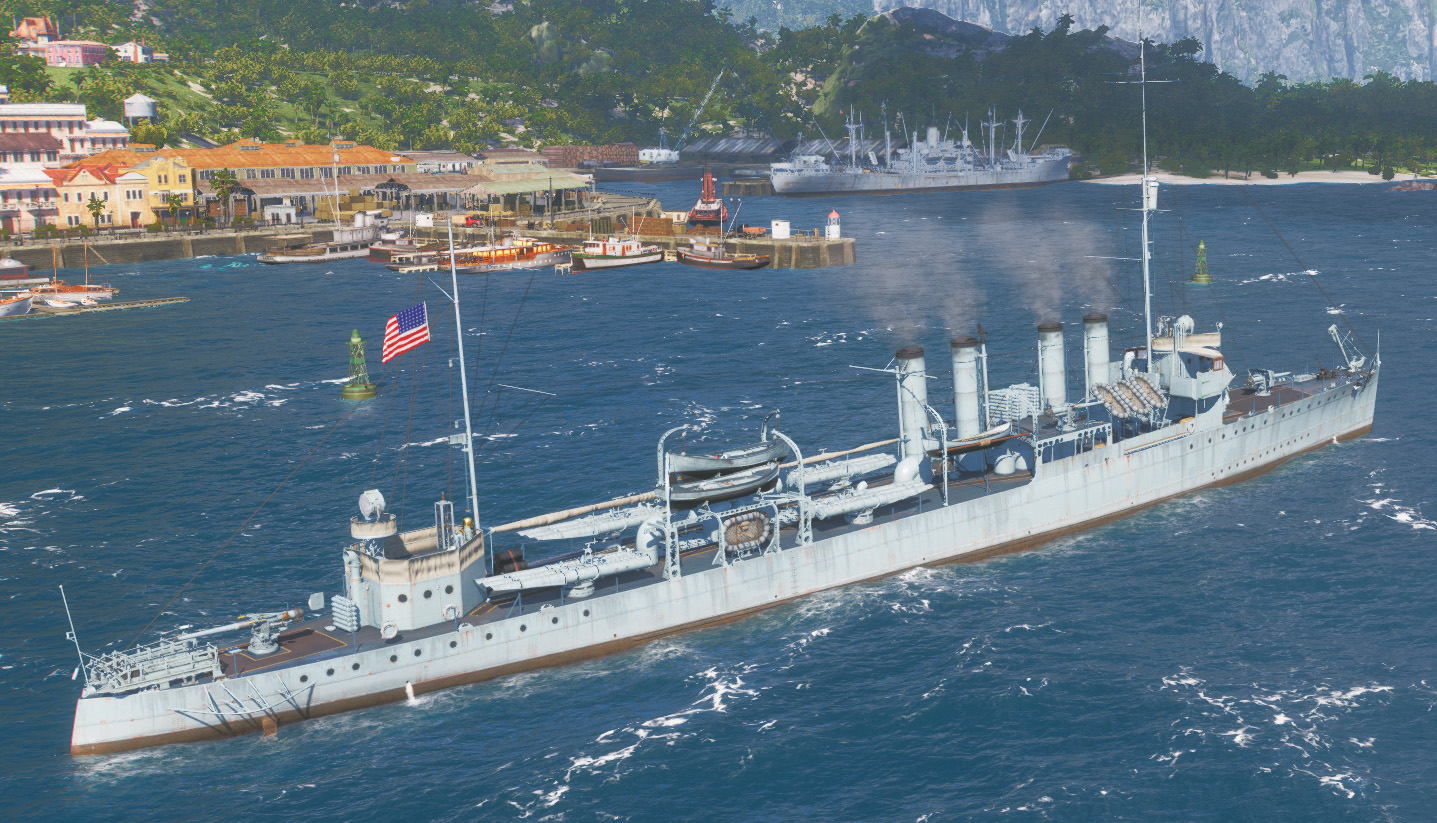
Full view, WoW 3d rendition of the ship (in Cavite)
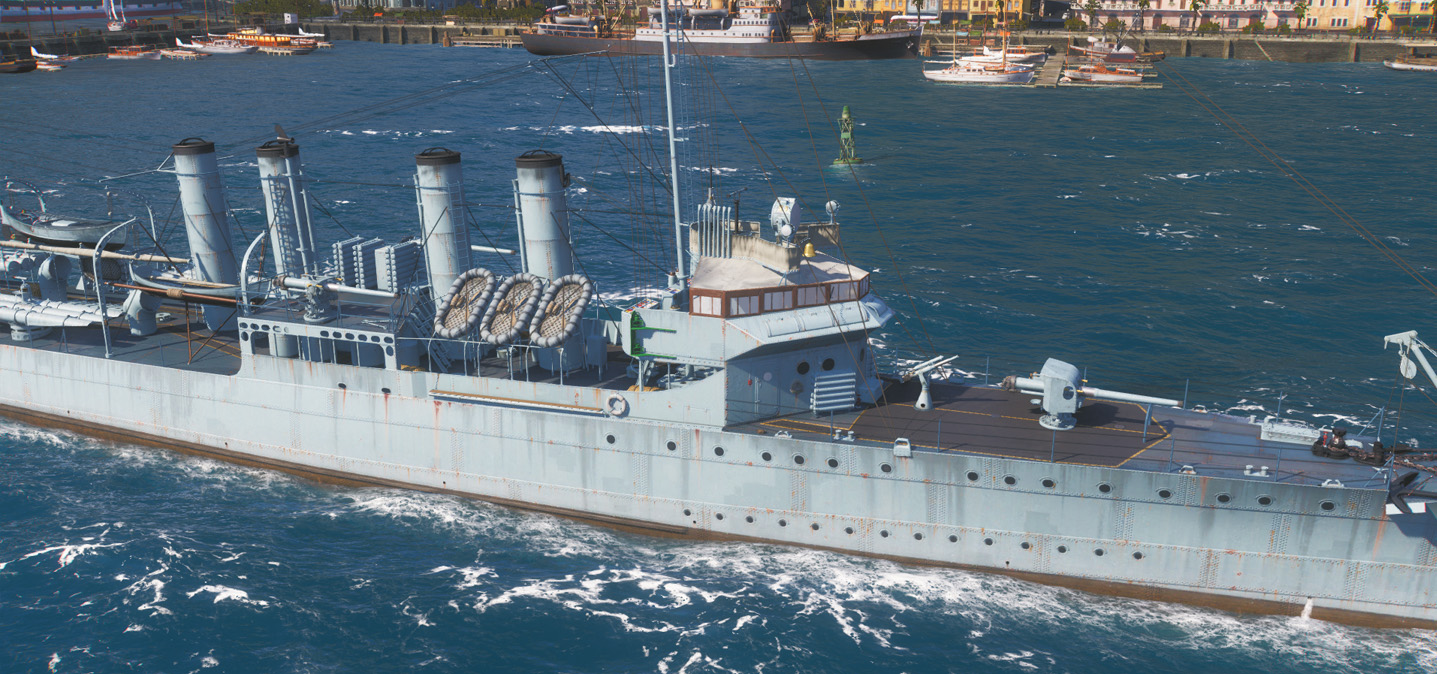
Same, Forward section. Note the initial 37 mm AA gun behind the main gun and wooden bridge windows frames.
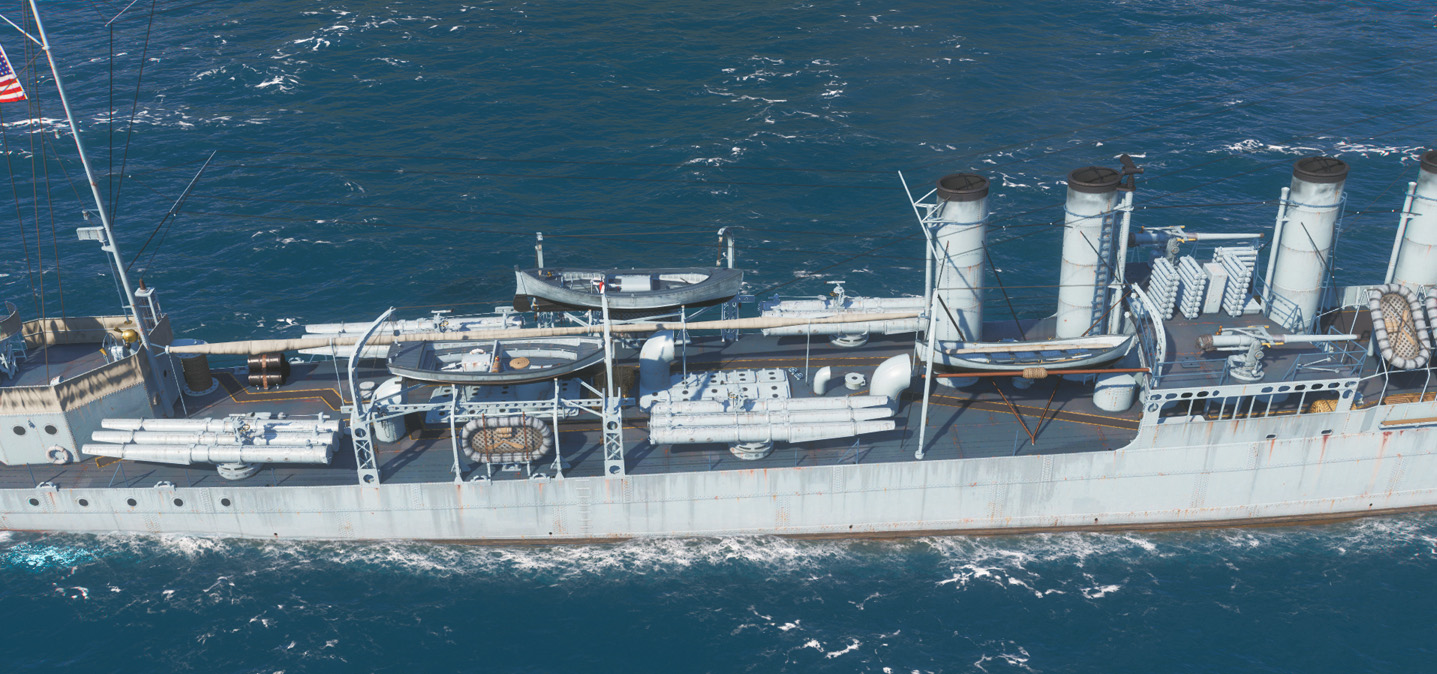
Mid-section. Note the mid-ship guns and shell casings stacked between them.
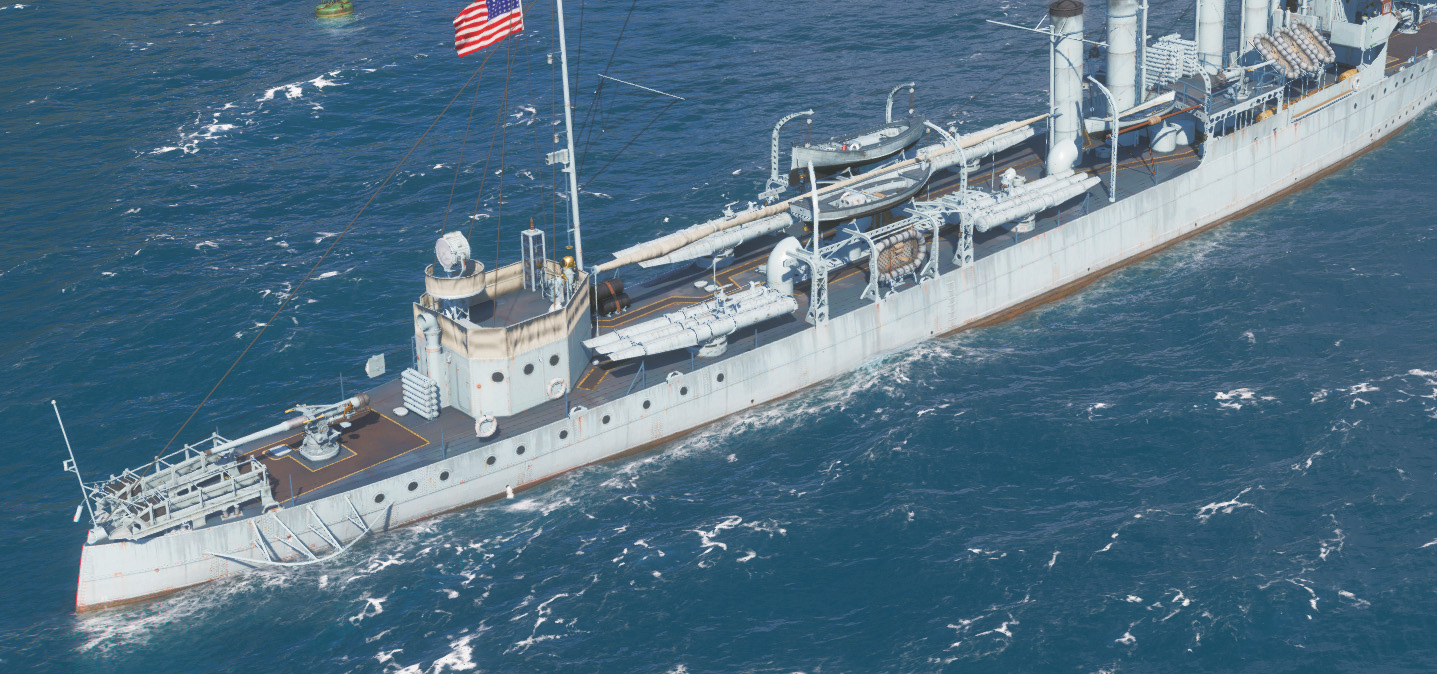
View of the stern. Note the depht charge racks at the stern, and alternated torpedo tubes banks.
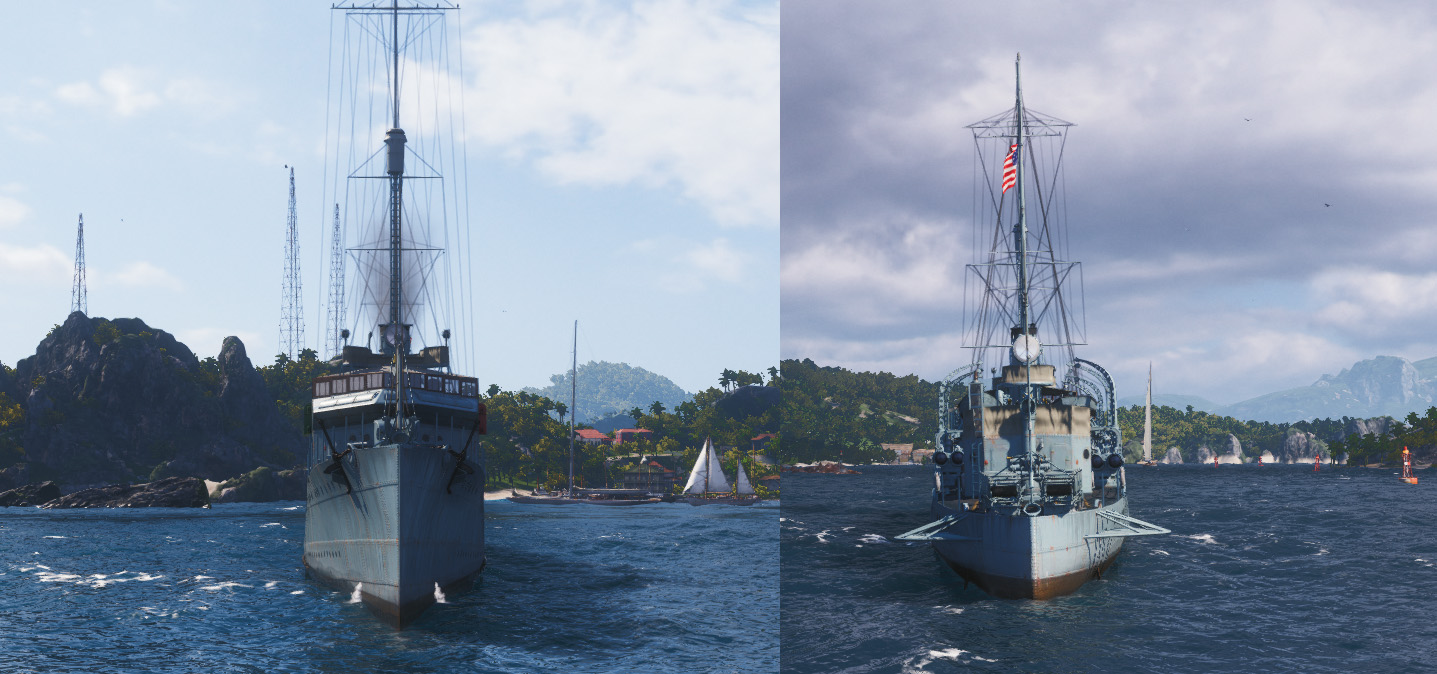
Forward and aft views, prow and stern.
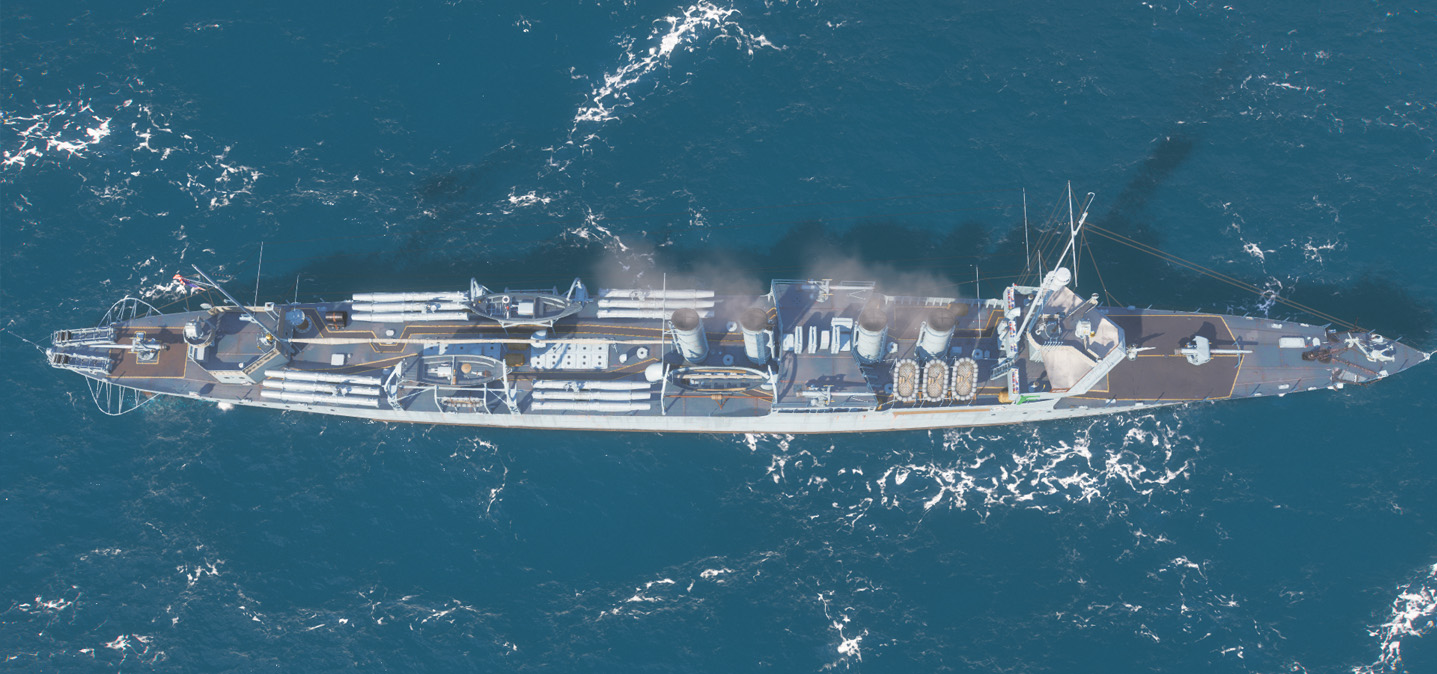
Overview, showing there was not “flat” side section, it was a continuous ellipse from the narrow bow section to the stern, despite the need fo building simplification.
Armament
Main armament followed the Caldwell scheme with four 4-inch (102 mm)/50, twelve 21-inch (533 mm) torpedo tubes, which was probably the largest torpedo load of any destroyer at the time, but perhaps the Russian Novik-derived destroyers. Gun armament was like the Caldwell placed in a lozenge pattern, one at the bow (wet as said above), one at the stern, two on an upper position amidship. The triple torpedo tubes banks were staggered, on the broadside: In accordance with American practice at the time it was feared that a captain would “spend” all his torpedoes at ones, so the twin broadside ensure a second chance.
At the time also it was not yet figure out how to set the torpedo course in advance to reach a circular pattern, which would have allowed the torpedo boat to fire all these in quick sucession under little angle change, forward. This was done on similar broadside configurations of “gold platters” such as the Gridley–Bagley of the late 1930s, albeit with quad torpedo banks. There is a certain constancy in excess here… The General Board at the time wanted broadsides rather than centerline banks to maintain torpedoes after an attack for another, and this also explains the lack of spares. There has been also an history of centerline mounts striking gunwales while firing, a serious hazard.
Main Guns
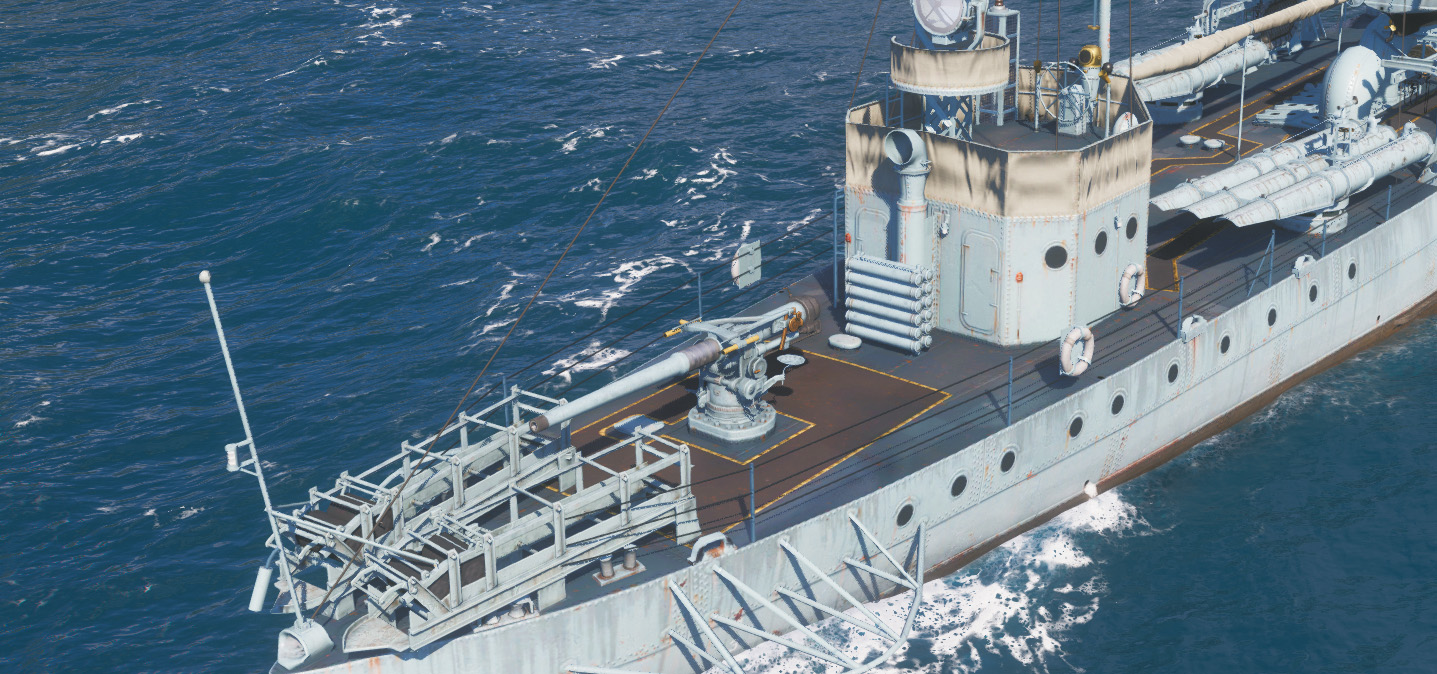
close view of the main aft gun, showing also the stern depth charge racks. Note the 12 read-rounds stored just behind (WoW)
The 4-inch (102 mm)/50 Mark 9 guns was a reliable model, retook from previous class. The lozenge configuration meant that the amidship guns on bandstands aft of the bridge making them insensitive to water spray, and the upper position also gave them a greater arc of fire. The former position was in a triangle pattern, located on aft deck lever behind bulkwarks, firing though the forecastle’s recesses.
Specs: Mount/Barrel Weight 6,100 pounds (2,800 kg), 33-pound (15 kg) armor-piercing shells (2,900 feet per second or 880 m/s) range 15,920 yards (14,560 m) at 20°.
As said above the forward gun on the forecastle was “wet” most of the time while in heavy weather, which was a dialy occurence in the Atlantic.
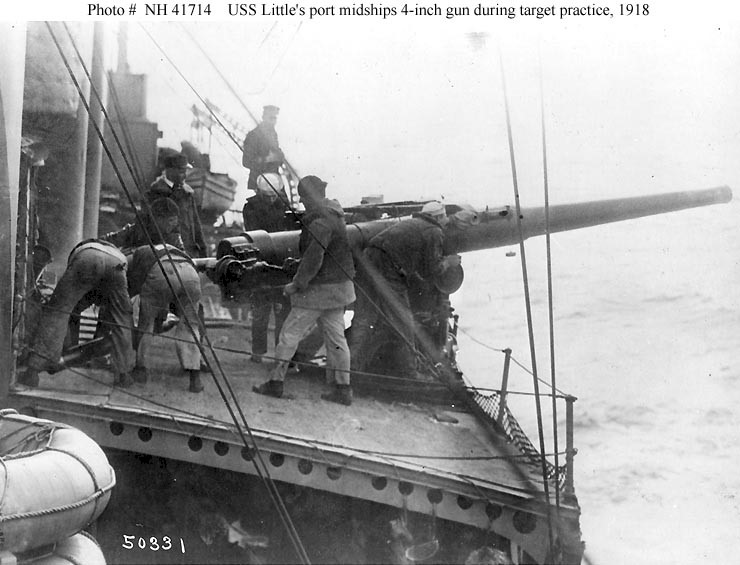
Banstand gun, USS Little (navsource)
More on navweaps.com
Torpedoes
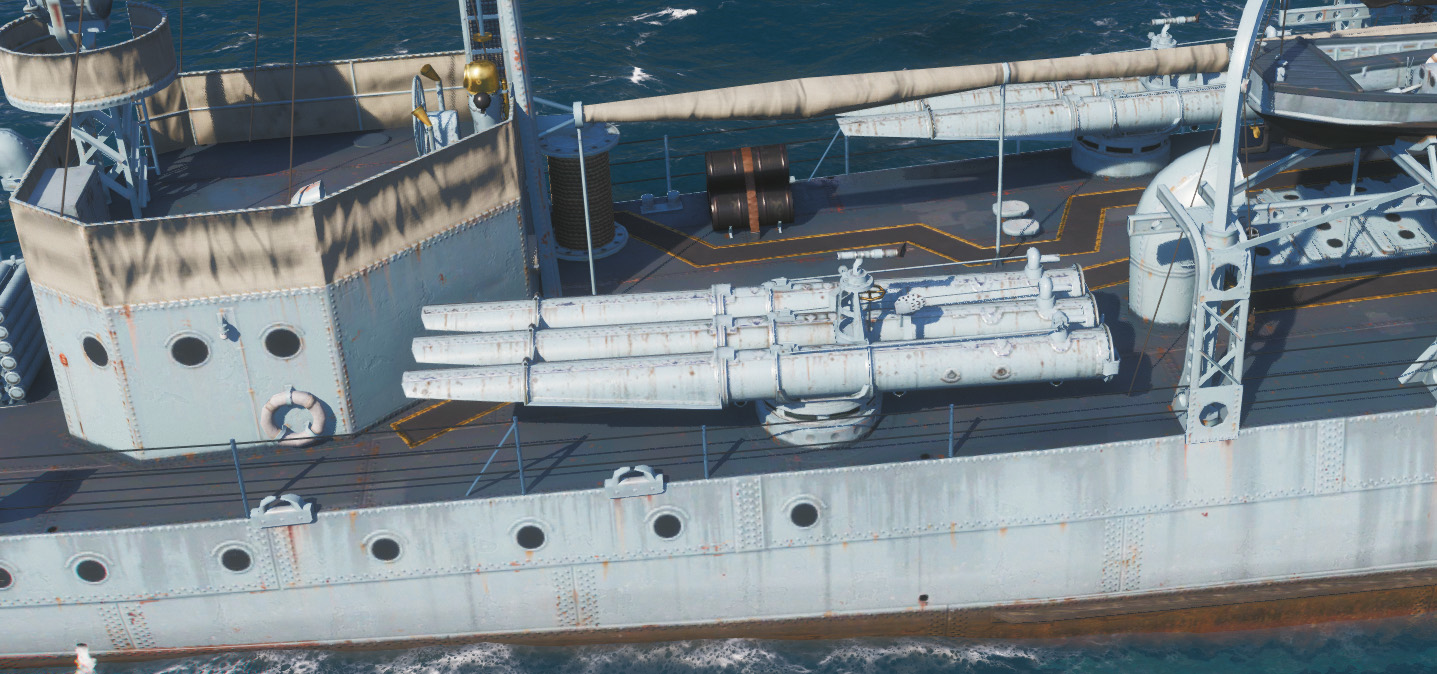
Close view of the aftmost port bank. The aftmost starboard is 50% futher back inrelation, and it was the same for the two others (wow)
These staggered torpedo tubes banks were located with the two starboard ones closer to the forecastle, and port one further aft, amidships, between the aft funnels and quartedeck house. They were loaded with Bliss-leavitt 21-inches Mark 8 Torpedoes (1915). It seems they stayed in service in the interwar as well as even 1940 lend-lease boats issued to the Royal Navy still operated them.
As said above, no reloads due to space, and weight(stabilty) issues. WW2 saw the removal of at least two of these banks, or even all depending on their roles.
Characteristics:
The Mods 2A was probably the model used in 1918-21, which weighted 2,761 lbs. (1,252 kg), 248 in (6.299 m) long, 321 lbs. (146 kg) TNT charge, settings 10,000 or 12,500 yards (9,140 or 11,430 m) at 27 knots. Powered by Wet-heater and guided by a Mark 8 Mod 1 gyro.
AA guns: Two 2-in (1-pdr) Mk.7
A common featured shared by the Caldwell and previous Sampsons. To ensure their anti-aircraft defense she ships were given initially when planned two 2-pdr autocannons, one behind the forward gun, the other on the quaterdeck house, a better position compared the the previous Caldwells, of the Maxim-Nordenfelt 37 mm 1-pounder Mark 6/7 type.
However at the time a new dual purpose gun just entered USN service, and this was modified for a single 3 in (76 mm)/23 caliber AA gun placed on the forecastle, behind the main gun.
This 3-inch (76 mm)/23 caliber anti-aircraft (AA) gun had the following specs:
Automatic fire with recoil, ~300 rpm cyclic, belt-fed, mv 1,800 ft/s (550 m/s) range c4,000 yards.
In the 1930s two Browning 12.7mm/90 HMGs were added for close AA defence as the 3-in guns was seen as a bit slow.
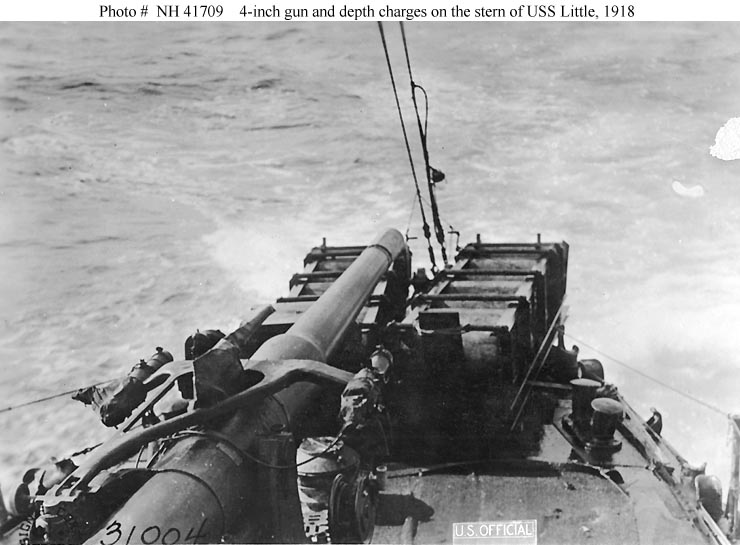
Anti-submarine (ASW) armament was added at completion, comprising two depth charge tracks aft, along with a Y-gun depth charge projector forward of the aft deckhouse for some ships. Eventually the particular stern’s new shape proved detrimental to the use of depht charges unlike what was expected, while diminishing agility.
Interwar Upgrades
In 1918-1919, all ships completed had either a single 3-in/23 alternative to two 2-pdr/43, and the latter were replaced by two 3-in/23 Mk XIV, which were a more advanced version of the same.
In 1920, the DM Type (Minelayer conversions), thus, USS Stribling, Murray, Israel, Luce, Maury, Lansdale, Mahan, Hart, Ingraham, Ludlow, Burns, Anthony, Sproston, Rizal(1930) and Gamble (1931), Montgomery, Breese, Ramsay saw the removal of their 3-in/23 guns, their aft DC racks, and four triple 21-in TT banks all removed to free their deck to install rails for 80 mines.
The ships recommissioned in the 1930s saw the installation of two 0.5-in cal./90 AA (Browning 12.7 mm M1921 HMG) and kept only a single 3-in/23 gun aboard, all their TTs and main guns.
⚙ specifications |
|
| Displacement | 1,154 tons (normal), 1,247 tons (full load) |
| Dimensions | 314 ft 4.5 in x 30 ft 11.25 in x 9 ft (95.82 x 9.43 x 2.74 m) |
| Propulsion | 2 shafts Parsons GST, 4 boilers @300 psi (2,100 kPa), 24,610 hp (18,350 kW) |
| Speed | 35.3 kn (65.4 km/h; 40.6 mph) |
| Range | 225 tons oil, 3800 nm @ 15 kts |
| Armament | 4× 4 in/50, 1× 3 in/23 AA, 4×3 21 in TTs, 2x DCT, 2x DCR, see notes |
| Sensors (ww2) | SC radar 1940+, see notes |
| Crew | 100 officers and enlisted men |
Construction
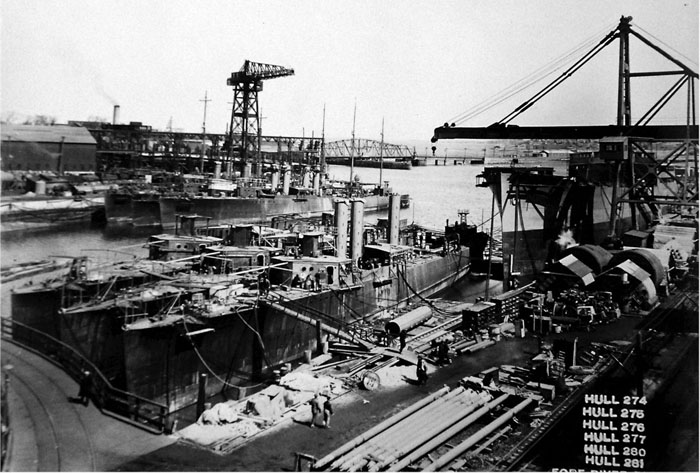
Completion of several Wickes class at Bethlehem Shipbuilding Corporation, Fore River Shipyard, Quincy, Massachusetts in 1918: Hull 274 (USS Little), Hull 275 (USS Kimberley), Hull 276 (USS Sigourney), Hull 277 (USS Gregory), Hull 280 (USS Colhoun), Hull 281 (USS Stevens). Secretary of the Navy Josephus Daniels Collection. Courtesy of the Library of Congress.
Construction was an unprecedented effort for any warship of the USN. It was undertaken by ten different builders, creating considerable variation in boilers and turbines types, albeit based on the very same plans “own” by the admiralty as it was customary in time sof war. Thus, these arrangements led to differences of power and range, albeit they were all obliged under contract to meet the Navy stringent’s speed requirement. Essentially thise led to two basic designs, from Bethlehem Steel yards and that included Union Iron Works and on the other hand, all remaining shipyards, with plans prepared by Bath Iron Works, essentially the initial creator of the Wickes class.
The United States Congress authorized 50 destroyers as per the 1916 Act for a start. It’s the brutal extension of the U-boat campaign that resulted in rapid increases and further orders followed, until 111 were built, on 190 ordered. The yards chosen had of course experience in warship construction, and destroyers are not among the most complicated vessels around. These yards were:
-Bath Iron Works (Maine)
-Bethlehem Steel Corporation’s Fore River Shipbuilding Company
-Union Iron Works
-Mare Island Navy Yard
-Newport News Shipbuilding
-New York Shipbuilding
-William Cramp & Sons.
Not only they delivered the Wickes, but also the follow-up Clemson-class for a grand total of 267 destroyers of a very similar general design.
This program was looked at after the war, by all nations, like a major industrial achievement. In fact, it also was given full priority on any other construction: New cruisers of the Omaha class and the Lexington class Battlecruisers, Soth Dakota class battleships were all delayed to allow the achievement of the program, as it was seen vital to wing the war in the Atlantic.
The first Wickes-class ship was launched on 11 November 1917, at the time the US were effectively at war since several months now and the expeditionary corps under Gen. Preshing completed training. with four more followed until the end of the year, but the bulk were launched in 1918, peaking in July 1918 with 17 launched, notably -symbolically- 15 on 4 July.
The program was not stopp as the war inded in November. Indeed, 21 were launched after the armistice and the last ones on 24 July 1919. There were several reasons for this:
-Not loosing ship that were launched and close to completion. It was decided to complete them rather to have them scrapped, as completion was a fast process, in average 2-3 months.
-Maintaining orders for the Yards, especially after it was decided to cancel the six 43,200 South Dakota class (BB-49 to 54) and suspend the Lexington class, much longer and costier to complete in comparison.
-Social reasons, congress members wanted to maintain jobs running in their circumscriptions until 1921, notably for demobilized soldiers.
The Navy however was not please with this decisions, as there not have been enough time to really judge the quality of the Caldwell class design they were based on.
Also, this left the U.S. Navy with so many destroyers that they far outweighted its needs in peacetime: They had been designed to cover both fleet escort tasks and escort duties in the Atlantic as well, unlike in WW2, where this task was reserved to dedicated escort destroyers and sub-hunters.
Indeed, they proved to have serious drawbacks (see later).
In fact, so much destoyers were available in 1920 that, even after replacing all the “flivvers” and following pre-flush deck era classes, they saw limited service for those completed postwar, joining the mothballed quickly, seeing a few extra extra service in the interwar when needed (the base rule was ten years of service as a minima), and in the end, WW2 service. In fact the still constituted the bulk of the USN when war broke out in 1939, as “only” about 60 “gold platters” had been built from the mid-1930s, leaving time to explore designs in short series and bring incremental improvements and innovations. Part were converted as convoy escorts, 50 were sent to the RN, others were converted as assault ships and for others roles. Many also had been scrapped after achieving about six to ten years service depending on their conditions.
Sub-classes:
Some ships were sub-divided as the Little class (52 ships), Lamberton class (11 ships), or Tattnall class (10 ships) based on their yard’s choices in design and encompassing the slight design differences from the Bath Iron Works design ships. The units of the alternative design were commissioned often before the lead ship, USS Wickes as a paradox.
The 111 Wickes-class coming from eight yards were reparted as followed for Bauer and Roberts:
-38 ships from Bath, Cramp, Mare Island, Charleston: Proper Wickes class
-26 ships from Bethlehem’s Fore River, 26 from Union Iron Works (Little class)
-11 ships from Newport News (Lamberton class)
-10 from New York Shipbuilding (Tattnall class)
General Assessment of the Wickes class
As built, the ships were generally seemed as satisfactory over the previous 1000-tonners. But three major shortcomings were reported, which explained in part their short service:
Limited Endurance
They showed as seen above limited endurance, as WWI obliged them, either to escort convoys across the Atlantic and accompany the fleet far from home.
Bath-designed Wickes-class ships were the only ones to exceed their design cruising radius, whereas those from Bethlehem were below. This led to redesign the ships throughly, leading to the next Clemson class, having 100 tons (35%) greater fuel capacity overall thanks to many internal rework. Even this was insufficient and still in 1919, these flush-deckers crossed the Atlantic with great difficulty. Only as low speed and avoiding “diversions” (meaning sally forth at high speed for a rescue to chasing submarines).
Additional solutions were considered by the admiralty after consultation of the Bureau of Construction & Repair:
-Replacing boilers or magazines with fuel tanks, reworking again the internals, notably to free more space, making a double hull.
The Navy however by budget-constrained after the war and another more practical and flexible solution was found: Underway replenishment, or RAS (Resplenishment at Sea).
Initial attempts has been made indeed after the US went at war in April-May 1917 to ensure the short-legged 1,000 tonners could reach Ireland. There was a gradually routine tanker-to-destroyer fuel transfer developed and perfected after the war.
Poor Agility
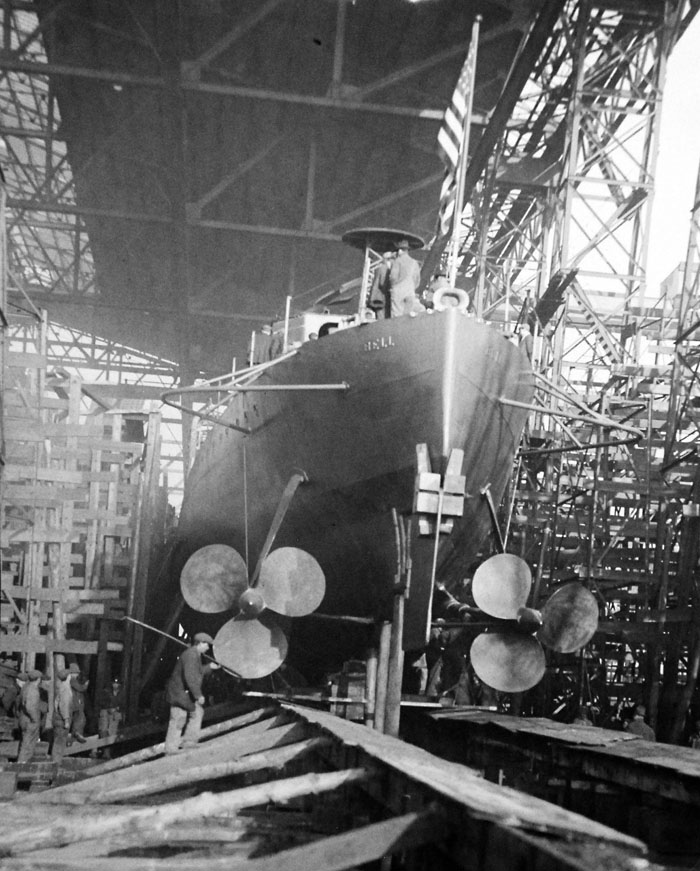
USS Bell’s stern view – Propellers. Navsource
Unlike the preceding Caldwell, all these flush decker had redesigned sterns, still V-shaped but munch more narrower as it was believed it was better for depht charge chute. However this caused sterns to “squat” at speed, and eventually caused them to have a greater turning radius. They turned out less maneuverable, bleeing speed at high speed as these sterns acted a “brakes” in hard turns. This design modification caused by the new depth-charges and dictated by their priority at the time, anti-submarine warfare and not surface combat, was detrimental to their postwar career. There was no time to evaluate a new stern design and the Clemsons were built the same, leaving 267 destroyers not ideal for all missions. Larger rudders however were installed on the Clemson-class ships to try to alleviate the problem after sea trials results of early Wickes ships were known, but the problem was only solved by the 1930s “gold platters” and the Farragut class.
Wet and Unreliable
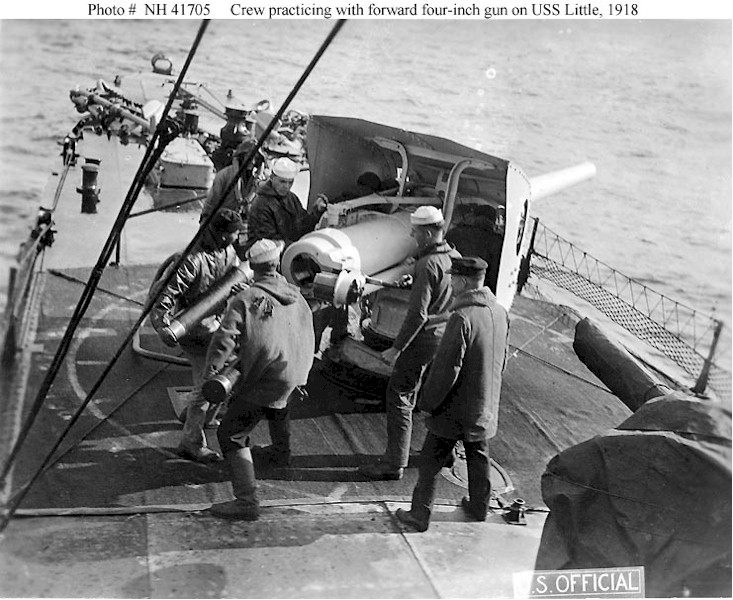
The “always wet” forward gun, here on USS Little
As said already the ships were also infamous for being very wet forward, a problem which became a priority and also solved with the Farragut class and their raised-forecastle hull, a return to a classic formula. This did not proved the flush deckers were a bad concept, as it presented advantages notably for mass construction: This was in fact repeated on the WW2 Fletcher, Sumner/Gearing class for the very seam reasons. But in between the ships were perfected and beamier, with a redesigned prow to alleviate the issue of water spray in heavy seas. The ships were also larger, bulkier than the flimsier, 50% smaller “four piper” of WWI.
The other point was in part expected; The haste with which they were built, like at Mare Island with advance planning, launching Ward in just 17 days, looked like a comprition between yars and a question of prestige (like in WW2), but as the same, workmanship was inconsistent between yards. As it was decided not to halt construction when hostilities ceased, all ships ordered were completed, and fast to be paid earlier, especially in peacetime context. As they were mostly surplus, unusual measures were taken to keep them serviceable on the longer run, causing some surprises.
The Yarrow water-tube boilers on some sixty 60 Bethlehem-built ships wore out quicker than expected, and those were set aside for scrapping en masse in 1930, forcing the navy to recommission replacements.
Interwar and WW2 Use

Fast speed transport USS Stringham (a converted Wickes-class destroyer) carries an Underwater Demolition Team (UDT) probably on ther way to Tulagi. September 1944 – Reddit
A few Wickes class were completed in time for service in World War I, some with the battle fleet, some on convoy escort duty; none were lost. DeLong ran aground in 1921; Woolsey sank after a collision in 1921. In the end, this mass of new-built destroyers constrained the Navy to wait until 1934 (no keel laid after 1922) and the launch of her first true new type. The Congress denied any of such request based precisely of this mass of destroyer with little service, not a good taxpayer return. In between other navies saw already ten years of constinuous construction and design improvements. The sailors that manned these first new destroyers were so surprised by the gap in technology, room and improvements that the Navy soon saw a favoritism developed in the late 1930s between those which served on “four pipers” and “goldplaters”.
The Flush Deckers that survived the 1930 purged found new roles. The Nav developed for them the “secondary destroyer service”. DesRon 29 in the far east for example. This explained while so many of these destroyers found use in the Pacific when war broke out in December 1941. Inded the newly built “goldplaters” were reserved for the Atlantic, seen in 1937 already as the priority front.
Of course, many were sent to England and Canada in exchange for bases as part as the 1940 agreement, as the former in particular had bled destroyers at Dunkirk, Norway and in the Atlantic already, and needed them for a hard compaign against U-Boats, especially by 1941. They preferred to reserve their newly built destroyers for fleet operations, notably in the Mediterranean.
A few ships that remained home even were sokd and purchased, converted for commercial service like transporting bananas between South America and New Orleans.
But these really were dedicated conversion that brought them new meaning:
DM and DMS mine conversions (1920)

USS Southard as DMS 10 in WW2
Many Wickes-class destroyers conversions started already from 1920 as the Navy was worried about all these surplus vessels and decided to put them to good use. For example, there was a doctrine for fast minelayers. Thus, BuC&R came out with their conversion of some ships as fast fleet minelayers. It is not precised if they cwoulmd be used with the same techniques asked for the Russian post-Novik destroyers, of dropping mines at full speed right in front of an advancing fleet, to disrupt it and facilitates the work of the opposing fleet or destroyers.
In all, fourteen destroyers, freshly completed were converted as light minelayers with the hull classification symbol “DM”. Their deck destroyer armament was removed: All TTs, one aft AA gun, and their depht charge throwers and racks to free space to install railings along the deck for 40 mines either side, 40 in all; They were dropped using the same chutes made for the DCTs.
The mines at the time were likely of the Mark 6 Type.
These were spherical, 34 inches (87 cm) diameter antenna type mines, using a K-type pistol in diameter. 1,400 lbs. (635 kg) total with a 300 lbs. (136 kg) TNT warhead with a few Hertz acid horns, and could me moored at 3,000 feet (914 m) deep.
They had been used on the North Sea Mine Barrage in World War I. Amazingly, they were still in the inventory as late as 1978… 100,000 were ordered by order of 17 October 1917 by the Secretary of the Navy ($40,000,000), produced at a rate of 1,000 daily notably at the state factory TNT, St. Julien’s Creek in Virginia which also handled 300,000 lbs daily.
The Mark 6 was even still around by 1985 and thus, the most available USN mine ever. Mod 2 (rising type) Mod 3 (Mark 9 case, 100 foot lower antenna), Mod 4 (Mark 6 case, 50 foot (15 m) lower antenna) were also derived and built along the years. They had reliability problems however, 4-8% exploding prematurely.
Six DM conversion were scrapped in 1932, replaced by five additional ones, another four converted to auxiliaries/transports (like APDs). Four Wickes DM conversions and four Clemson DM conversions saw action in World War II. 23 were scrapped, sold or sunk as targets in the interwar. They were seen as a “blanket replacement” for the 61 Yarrow-boiler scrapped in 1930-31, due to small tubes being worn out. Other flush-deckers were exhumed from the mothballed to complete.
Eight were later converted to destroyer minesweepers (DMS) still around in 1940, USS Dorsey, Lamberton, Boggs, Elliot, Palmer, Hogan, Howard, Stansbury as well as in 1941 for Hamilton were armed with their four 4-in/50 guns, single 3-in/23 AA remaining landed, and already having lost their TTs, DCR (Y-gun) and DCTs. They were armed with only four modern 3-in/50 Mk 20 (76 mm) dual purpose guns, two 12.7mm/90 AA guns, and from two to four modern DCT, as well of course a minesweeping gear. They also lost a boiler and thus, output lowered, making them only achieve 25kts.
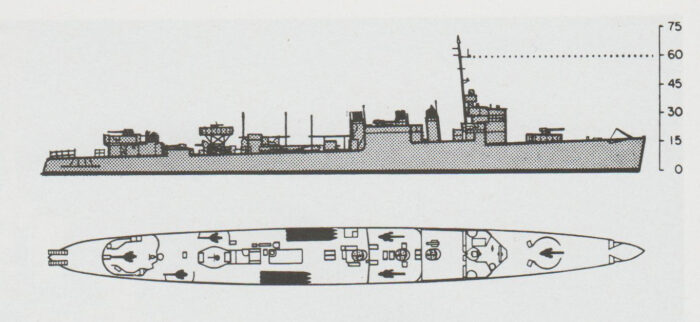
ONI 222 rendition.
⚙ DM/DMS class specifications |
|
| Propulsion | 2 shafts GST, 3 boilers, 20,000 shp |
| Speed | 25 kn (46 kph, 28 mph) |
| Armament | 4× 4-in/50, 80 mines, optional 3-in/23 AA (1930) |
| Armament | 4x 3-in/50 Mk.20, 2-4 DCTs, 2x 0.5-in AA, Minesweeping gear (1940-44) |
Lend-Lease conversions (1940-42)

HMS Leamington (ex-USS Twiggs). She had an interesting career, ceased to USSR in 1944, Renamed Zhguchiy (“Firebrand”). Sent back to UK, mothballed and used for the recreation of the St. Nazaire raid in the Trevor Howard film “Gift Horse”, BU in 1951.
HMS Montgomery, Lancaster, Mansfield, Newport, Newmarket, Newark, Richmond, St. Clair, Leamington, Campbeltown, Castleton, Caldwell, Chelsea, Wells, Salisbury, Lincoln, Niagara, Brighton, Georgetown, Roxborough, Hamilton, Annapolis, Bath, St. Albans, Columbia, Charlestown, St. Marys.
Twenty-three Wickes-class destroyers were transferred to the Royal Navy in 1940, the remainder twenty-seven being Clemson class ship for fifty total. Four were directly passed on to the Royal Canadian Navy. This was the 1940 Destroyers-for-bases deal.
These ships were refitted following the lines of WW2 destroyer used for escort, but only some saw extensive service as intended. Some depending on their conditions were even not considered worth refitting (Details below).
USS Buchanan was probably one famous example. Renamed HMS Campbeltown, she was disguised as a German vessel, modified to better protect the skeleton crew once the secret was given away, to be expended as blockship in the famed St Nazaire Raid. Another of these lend-lease vessels was sunk during the war, but the remainder were either sunk as target or scrapped between 1944 and 1947.
In 1944 seven of this original 23 ships load (4 to the RCN already) were transferred to the Soviet Navy, in place of Italian ships claimed by the USSR after Italy’s surrender. For the latter this was certainly an unfair replacement. These were scrapped between 1949 and 1952 after symbolic service, notably training, and tests.
Note: There will be a dedicated article the 50 “town-class” RN destroyers (Or Leeds class).
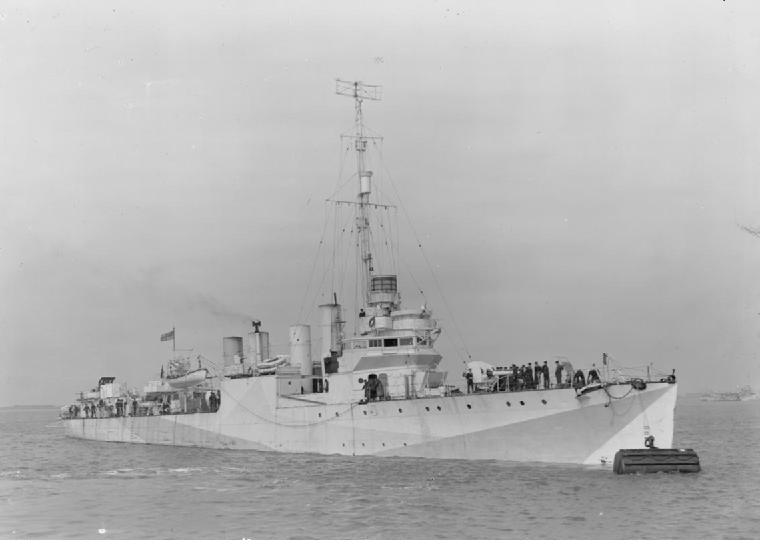
HCMS Manfield in 1942 (IWM). The ex-USS Evans was HMS Mansfield only for a few days, and HNoMS Mansfield for two years (Free Norwegian navy).
The destroyers-for-bases deal between the United States and the United Kingdom was signed on September 2, 1940, for 50 US Navy destroyers (including a single Caldwell class ship) transferred in exchange for land rights on British possessions, Trinidad, Bermuda and Newfoundland. They were mostly usable for the “flush deckers” lack of range, enabling to resupply them, as well as to put airfields on for the same reason and ensure the safe passage, of aircraft as well, complementary to the lend-lease agreement. The request for destrouers was initially denied by Roosevemt which instead pressed for the delivery or surplus ammunition instead in June 1940. However Churchill warned Roosevelt that if Britain fell, its colonial islands close to American shores could become a direct threat to US interests in German hands.
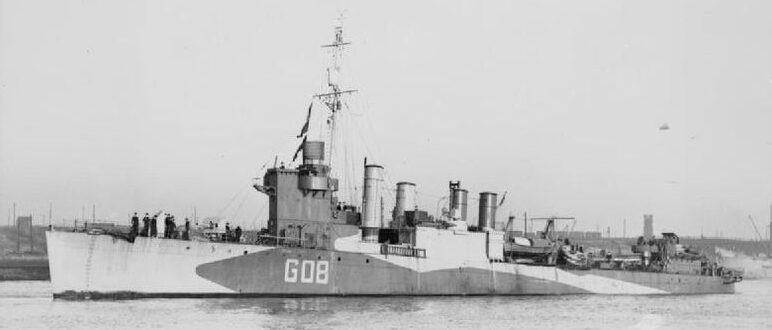
HMS Newark in 1942
Generally referred to as the “1200 tons type” but better known as “flush-deck” and “four-pipers” they became the British Town class after towns common to both countries. President Roosevelt for this went over the head of the congress, using an executive agreement and came under heavy attack from the wide antiwar faction in the US, notably to violate the Neutrality Acts.
The specs, notably radars, armament, are detailed below:
⚙ “Town” class specifications |
|
| Armament | 3× 4 in/50, 1× 3-in/23 AA, 2×3 21 in TTs, 2 DCR, 4-6 DCT initially |
| Armament | 2x 4-in/50, no TTs, 2x 3-in/50 Mk 10, 2-4x 20mm/70 Oerlikon Mk II/IV AA guns, DCT/DCRs. |
| Sensors | Type 271 and type 286 radars |
| Crew | 146 |
Pacific fleet conversions (1940-42)
The ships still active in 1939 (exhumed from mothballs and modernized, so basically all not Yarrow-boilered vessels, not converted as DMs and APDs), were given a quick refurbishment and some limited modernization:
In 1940-1942 all received the upgrade of QCJ or QCL sonar when they kept their depth charge racks and y-Guns.
⚙ DM/DMS class specifications |
|
| Propulsion | 2 shafts GST, 3 boilers, 20,000 shp |
| Speed | 25 kn (46 kph, 28 mph) |
| Armament | 4× 4-in/50, 80 mines, optional 3-in/23 AA (1930) |
| Armament | 4x 3-in/50 Mk.20, 2-4 DCTs, 2x 0.5-in AA, Minesweeping gear (1940-44) |
Assault Transport (APD) conversions (1940-44)
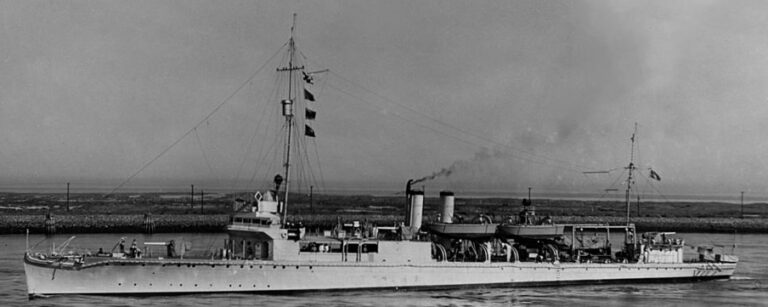
USS Manley (APD-1) as completed, 23 September 1940, of the prototype Caldwell class
APD2-4, 6, 17: 2 Curtis steam turbines / 1 geared steam turbine for cruising, 2 Yarrow boilers
APD5, 14: 2 sets General Electric Curtis geared steam turbines, 2 Yarrow boilers
APD7-9, 19, 20-22, 25: 2 sets Parsons geared steam turbines, 2 White-Forster boilers
APD15, 16: 2 sets Parsons geared steam turbines, 2 Normand boilers

USS Waters, APD-8 underway in 1944. This famous “green dragon” was one of the most decorated ship of the Wickes class, earning 7 battle stars, making all more important campaigns of the Pacific. The photo does not do justice to a complex camouflage that could comprise up to four tones of green.
Starting in 1940, many of the remaining ships were also converted. Sixteen were converted to high-speed transports with the designation APD following the example of USS Ward, sole vessel of the Caldwell class and prototype. These were USS Little, Gregory, Stringham, Colhoun, McKean in 1941, as well as Talbot, Waters, Dent in 1942 and Schley, Tattnall, Kilty, Ward, Roper, Dickerson, Herbert, Crosby in 1943 as well as USS Rathburne in 1944. These fast attack transports were assigned the task of carrying land crafts for fast operations, giving more tactical leeway compared to traditional assault vessels, at best reconverted cargoes and liners. Although they carried a limited number of landing crafts. Typically, four LCP(L) or LCP(R) at the start under davits for 144 troops. Any of the wartime assault ships was capable to carry five times that amount.
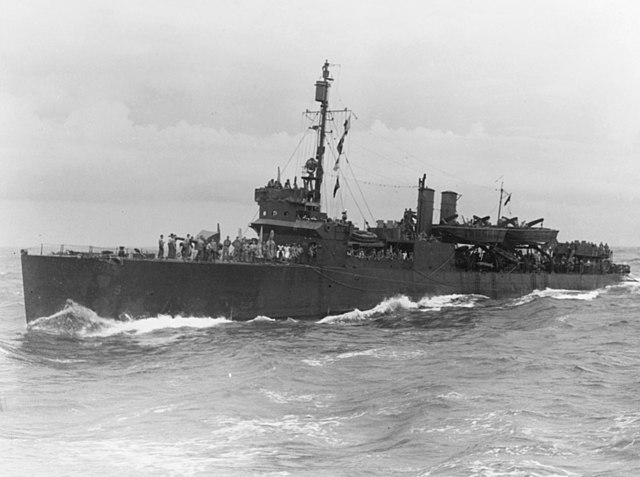
USS McKean as APD-5, sunk by on aerial torpedo of a G4M “Betty” Bomber of the IJN in 1944
The APDs not only were rearmed, but they lost two boilers to both accomodate more fuel (almost double) and and/or to accommodate more troops. As a result their speed fell to 25 knots (46 km/h; 29 mph) but this was considered good enough for their task, worth the sacrifice.
The conversion got rid also of the the low-angle Mark 9, 4-inch guns (transferred to armed merchant ships) in instead got the more recent dual-purpose 3-inch (76 mm)/50 caliber gun whoich could act for anti-aircraft protection. They were differences between conversions as well: The The AVD seaplane tenders had two of these, APDs as well as DM minelayer or DMS minesweeper had three guns. All the remaining destroyers had six of these, plus half their torpedo tubes removed. They were absent completely from all conversions.
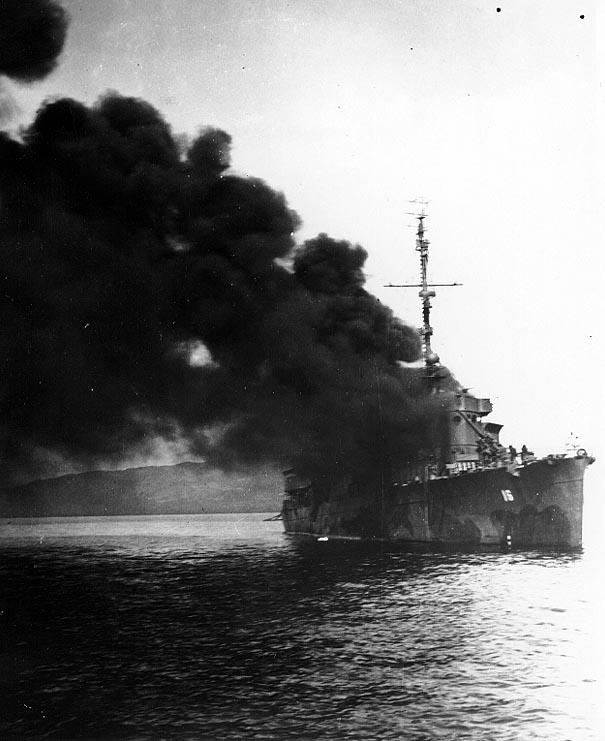
USS Ward, APD-16, afire after a kamikaze hit on 7 December 1944
The Case of USS Ward:
USS Ward was one of the rare ships of that type sunk by kamikaze during WW2. In 1942, she had a short career, between her commission on 24 July 1918, decomm. on 21 July 1921 and mothball until reactivated and recommissioned on 15 January 1941. While in Pearl Harbor in December 1941 she caught a Japanese midget submersibles trying to enter Pearl Harbor, fired several rounds from its main guns and hitting the conning tower and dropped several depth charges. This was an effect a “kill” as the wreck was later found in 2002, the first against the Japanese in WW2. She went on to serve actively in 1942 in Hawaiian waters, patrolling and escorting various ships, until sent to the West Coast for conversion as high-speed transport (APD-16) completed in February 1943.
She served in the Solomon Islands area as one of the famous “green dragons”, helped fight off the air attack off Tulagi (7 April 1943) and served as escort and transport, until December 1943 Cape Gloucester invasion. For the first 9 months of 1944, she went on in her escort routine, assisted amphibious landings at Saidor, Nissan Island, Emirau, Aitape, Biak, Cape Sansapor, and Morotai.
Next were operations in the the Philippine Islands and on 17 October 1944 she was used to land troops at Dinagat Island (Leyte invasion) and by early December was en route to Ormoc Bay, Leyte when attacked by several Kamikaze on 7 December, ironically three years after she fired on the Japanese sub, a bomb hit her hull amidships, and she took several near misses while she burned, stopped dead. Eventually abandon ship was ordered and she was sunk by gunfire by USS O’Brien, under William W. Outerbridge, Ward’s previous captain at Hawaii, another irony…
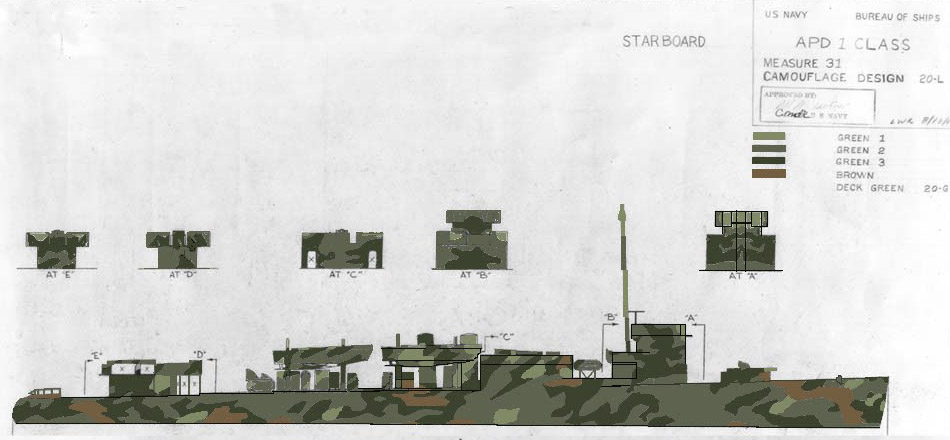
Pattern Measure 31, Design 20L fr the APD-1
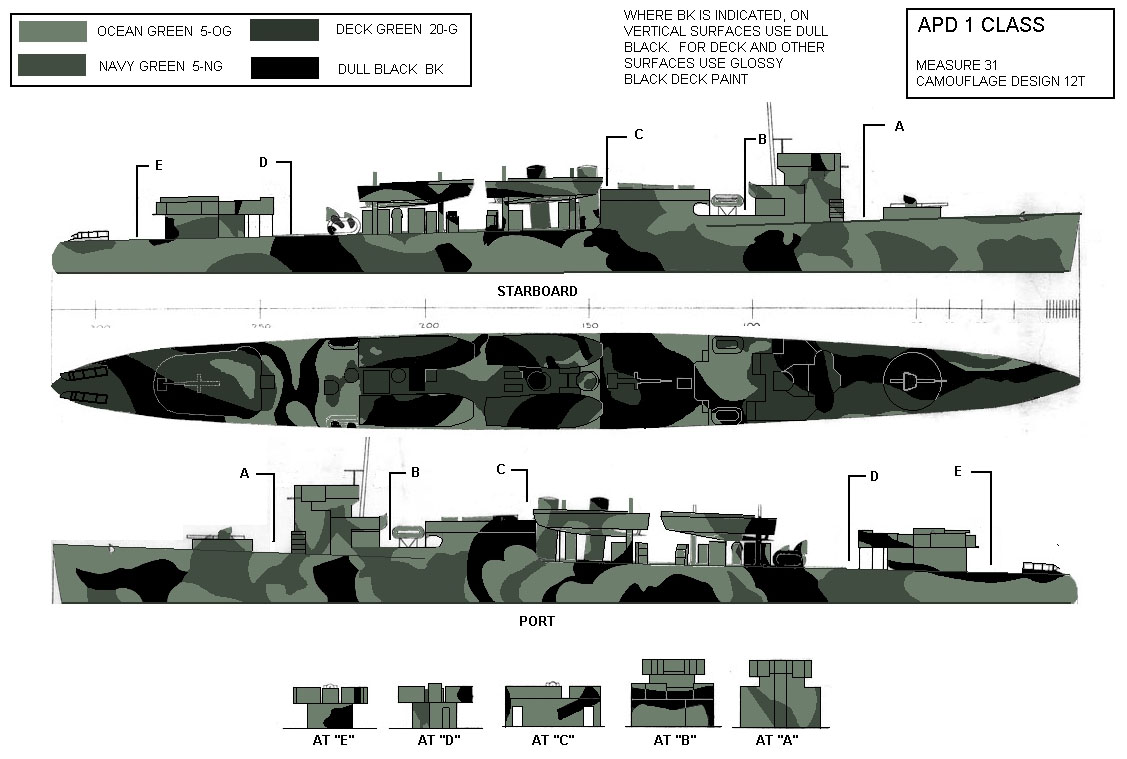
Measure 31, 12T design
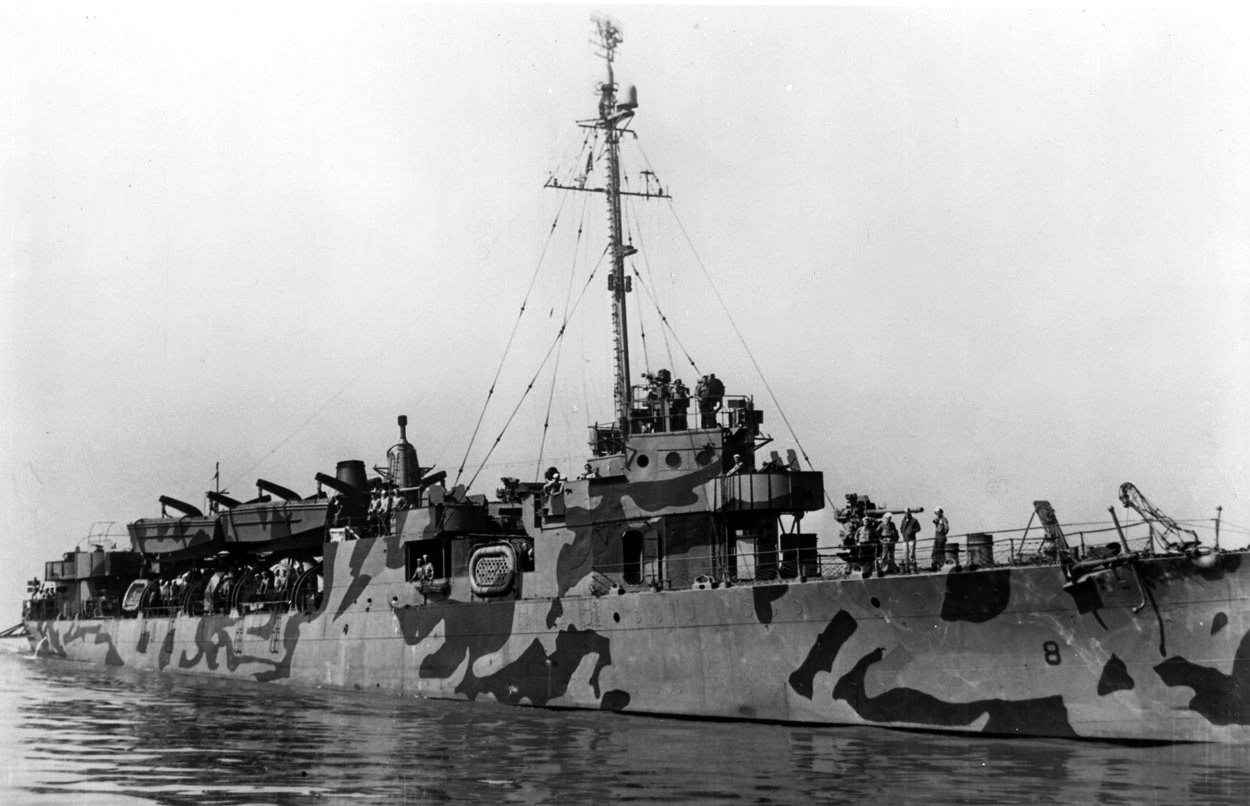
APD-8 USS Waters

APD-29 Barry
⚙ APD class specifications |
|
| Displacement | 1,315 tons standard, 1,793 tons FL |
| Dimensions | 95.7 x 11.3 x 3.76m |
| Propulsion | 2 shafts GST, 2 boilers, 13,000 shp |
| Speed | 22-24 kn (40 kph, 25 mph) |
| Range | Oil 429 tons, circa 7,000 nm |
| Armament APD2-6 | 3x 1 4-in/50 Mk 9, 6x 12.7mm/90, 4 DCT, 2 DCR |
| Armament APD7-9 | 3x 3-in/50 Mk 20, 6x 20mm/70 Mk 4, 4 DCT, 2 DCR |
| Armament APD14-17, 19-22, 25 | 3x 3-in/50 Mk 20, 1×2 40mm/56 Mk 1.2, 5x 20mm/70 Mk 4, 4 DCT, 2 DC |
| Landing Crafts | 4 LCP(L) or LCP(R), 144 troops |
| Sensors | QCJ or QCL sonar, SA, SE radars |
Note: There will be a dedicated article to cover APDs tech and career, that’s why their career is not seen there.
Thirteen Wickes class were lost during World War II in U.S. service. The remainder were scrapped between 1945 and 1947.
An exemplary Career: USS Wilkes, the lead ship
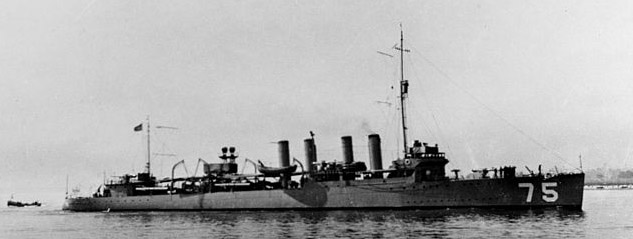
As the following career logs are shorted to the essentials not to make this already bloated page a massive mess, i’ll take USS Wilkes as an example of a ship which served in WWI, the interwar, and WW2 as lend-lease vessel. USS Wickes was laid down on 26 June 1917 at Bath, Maine, by the Bath Iron Works, launched on 25 June 1918 (So about a year after, which was long at that stage) sponsored by a descendant of Lambert Wickes. Commissioned on 31 July 1918 she made an abbreviated shakedown and departed Boston on 5 August for New York City prepared to sail for the British Isles and escorting a 12-ship convoy across the Atlantic. She was detached to Queenstown, Ireland, on 19 August and went to the Azores, Ponta Delgada and back to New York.
She escorted more convoys, notably via Nova Scotia but was hit by influenza adn 30 of her crew were evacuated and hospitalized in Halifax.
She later had an outbreak of flu. On 23 October screening ahead the cruiser USS Pueblo and escorting a convoy she sighted an unidentified ship to port on a collision course, changed course, switched her lights on and ordered full speed astern but the unidentified ship’s bow smashed in her port billboard eventually and she was cut down to the keel. There were no casualties zand still she survived thanks to her bulkhead. The ship in question remained unknown. She was back in NY for repairs on 24 October, learning on the armistice soon afterwards. She would later escort Wilson’s ship SS Washington to Brest, France.
She cruised in 1919 northern European ports, notably Hamburg and Stettin, Harwich but collided while in Hamburg with the German merchantman Ljusne Elf. She escorted back to the US the SS George Washington. Next she was sent to the Pacific, via the Panama Canal (24 July 1919) with and later had a new commander, no less than William F. Halsey after her overhaul at Mare Island Navy Yard. Halsey would said in his memoirs USS Wickes was “the best ship I ever commanded; she was also the smartest and the cleanest.” Wickes became flagship for Destroyer Division 10 (DesDiv 10), and operated along the west coast until 1922 between target practices and exercises. Peacetime austerity for her decommission and reserve at San Diego on 15 May 1922.
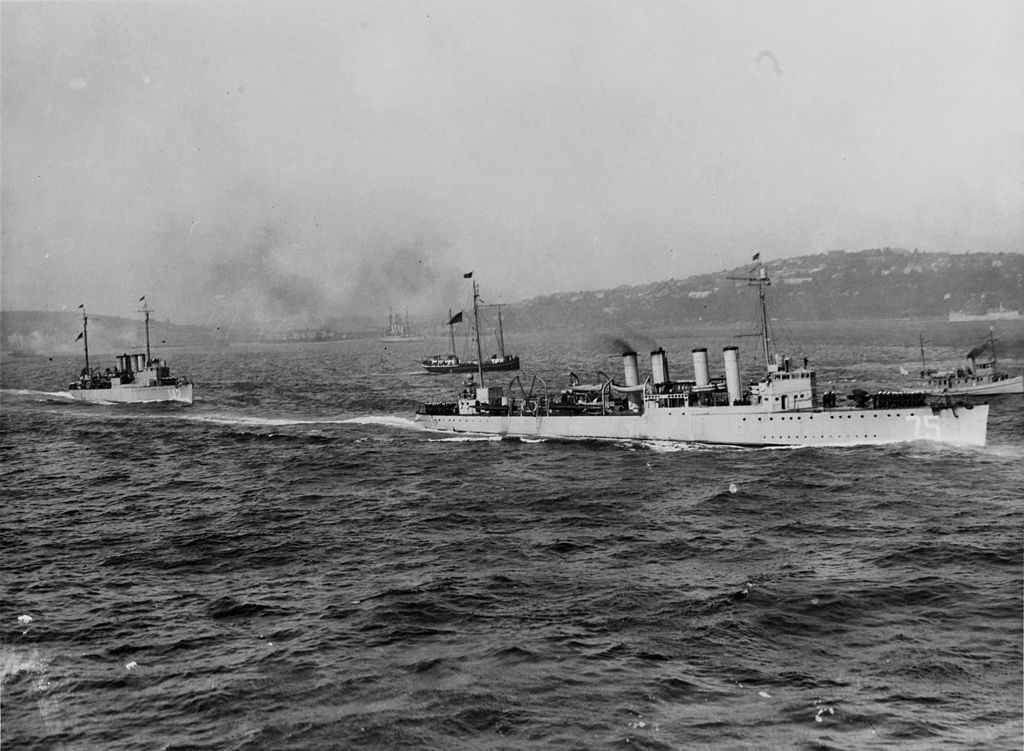
After eight years, Wickes was extracted out of her mothball on 26 April 1930, recommissioned and sent to the Atlantic with New York as new Homeport. Eastern seaboard training cruises with Naval Reserve detachments (3d Naval District) followed, and on 3-18 February 1931 she visited Tampa in Florida for the Gasparilla Pirate Festival, then Mobile in Alabama for Mardi Gras. In November 1931, she visited Bridgeport for Armistice Day. April 1932 saw her versed to the Rotating Reserve Squadron 20 (RoRSron 20) but sent to the Pacific.
1933-1937 saw her in San Diego, under command of Lt. Comdr. Ralph U. Hyde and Lt. Milton E. Miles as XO, and she was decommissioned on 6 April 1937, in reserve until the president decided to exhume many desstroyers for their reserve to take part in the “Neutrality Patrols” off the eastern seaboard, Panama Canal area approaches and Carribean, the two entrances to the Gulf of Mexico. In total 77 destroyers were reactivated, some as minelayers.
USS Wickes was recommissioned on 30 September 1939, fitted out alongside Whitney at the DD base and by early November, sent to Mare Island Navy Yard in drydock for alterations and modernizations, before going back to San Diego and depart on 27 November for Panama with the rest of DesDiv 64. En route, she refueled from the oiler Neches, reached Balboa on 6 December. She transited the canal to reach Naval Operating Base Key West in Florida, on 11 December, starting her neutrality patrol route.
She alternated between the Yucatán Channel, passage between Florida and the west coast and Cuba, shadowing belligerent merchantmen, British and Commonwealth navies ships looking out for German freighters or passenger ships trying to get back in Germany or be used as suppliers for raiders.
Her first patrol saw Wickes shadowing the cruiser HMAS Perth (or HMS Orion) well after nightfall. While off Port Everglades she shadowed the destroyer HMS Hereward in patrol off the Florida coast until Christmas. Back to Key West on 30 December she refuelled,, resupplied and sailed out on 2 January 1940 alternating between her homeport, Yucatan peninsula and Guantánamo and trained with the Atlantic Squadron (24-26 January) before joining DesDiv 64 sent to Puerto Cabello, Venezuela on 26 January for a three-day port visit.
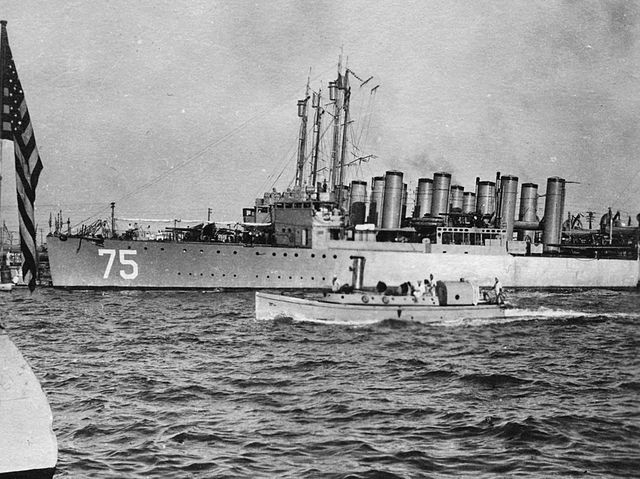
At her return she visited St. Thomas in the Virgin Islands, joined DesDiv 65 at St. Eustatius (Dutch West Indies) in February and next joined USS Wichita and DesDiv 82. With DesDivs 61 and 83 (USS Vincennes) they formed the “Antilles Detachment”, Atlantic Squadron. Wickes halted at Guantánamo Bay and ended in Key West, then patrolled the Florida Straits and Yucatán Patrol. In April she was with sister ship USS Twiggs a RAS. They however collided and the propeller guard from Twiggs punctured in her hull a small hole above her waterline, minor damage which did not prevented later to take part in battle practice off Key West, and return to the Yucatán Patrol.
She later visited San Juan, Puerto Rico, and St. Thomas and joined the battleships USS Texas, Arkansas, and New York for simulated torpedo attacks at night. Wickes stayed operating off San Juan. Meanwhile to the battle of the Atlantic for the Royal Navy was added the Mediterranean Campaign. The RN was hardly pressed for new destroyers after its losses, and Churchill’s pressure eventally enabled the “destroyers vs bases” agreement. Going above the congress, the president authorized the transfer of 50 Wickes-Clemson destroyers to Britain, and USS Wickes was among them. She made a last Caribbean patrol, returned to Key West on 24 July 1940 and shifted to Galveston in Texas, on 27 July for an overhaul (Todd’s Drydock) until late August.
She departed Galveston with USS Evans on 22 September, stopped at Key West, then Norfolk Navy Yard on 26 September, and departed on 9 October via Hampton Roads, joining DesDiv 64 to Naval Torpedo Station in Newport (Rhode Island). Via the Cape Cod Canal she arrived off Provincetown (Massachusetts) and then Halifax in Nova Scotia on 16 October.
She was part of the fifth group of destroyers transferred to the British and Canadians. As the class lead ship she was visited by Prime Minister Mackenzie King of Canada, Rear Admiral Ferdinand L. Reichmuth of USN. On 19 October, the first personal from the future British crew was trained. On 23 October 1940, USS Wickes was officially transferred to the Royal Navy, decomm. from the USN the same day and stricken on 8 January 1941. Her US service stopped for good and the name was free for a new destroyer in construction.
As HMS Montgomery
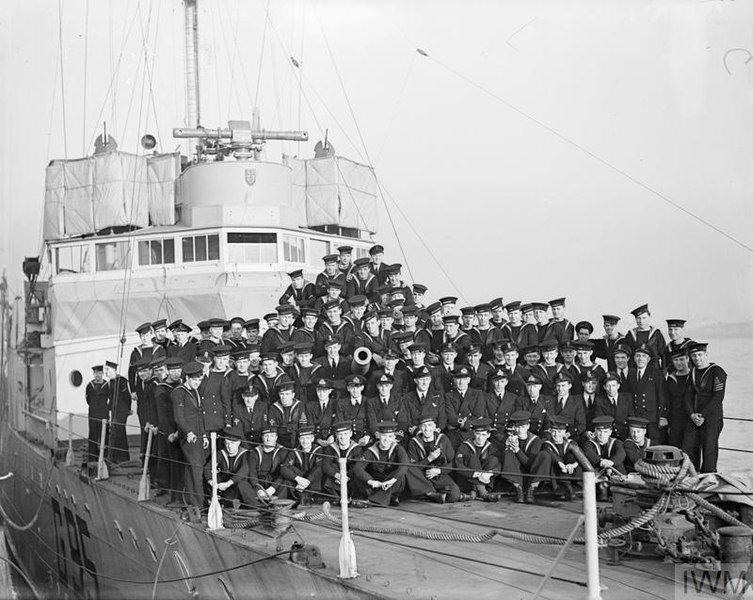
HMS Montgomery off Charleston
From 23 January under the White Ensign Wickes became HMS Montgomery (G95). She had a quick refit to RN standards, and for crew’s familiarisation, then departed Canadian waters on 1 November, sailing en route with other ships arriving to try to rescue survivors of the just sunken MAC HMS Jervis Bay by KMS Admiral Scheer on 5 November. Montgomery found nothing and reached Belfast in Northern Ireland on 11 November.
She went to Plymouth a week later, assigned to the Western Approaches command based in Liverpool. She rescued once 39 survivors from the motor tanker Scottish Standard torpedoed by U-96 on 21 February 1941. After a refit at Barrow-in-Furness (April-September 1941) she was assigned to the 4th Escort Group, having three 4-inch/50-caliber guns removed as well as one TT bank, additional depth charge stowage and an hedgehog. Based at Greenock se operated on the Canadian road until the end of the year. By 13 January 1942, she rescued the crew of the steamer SS Friar Rock torpedoed by U-130 off Cape Race in Newfoundland.
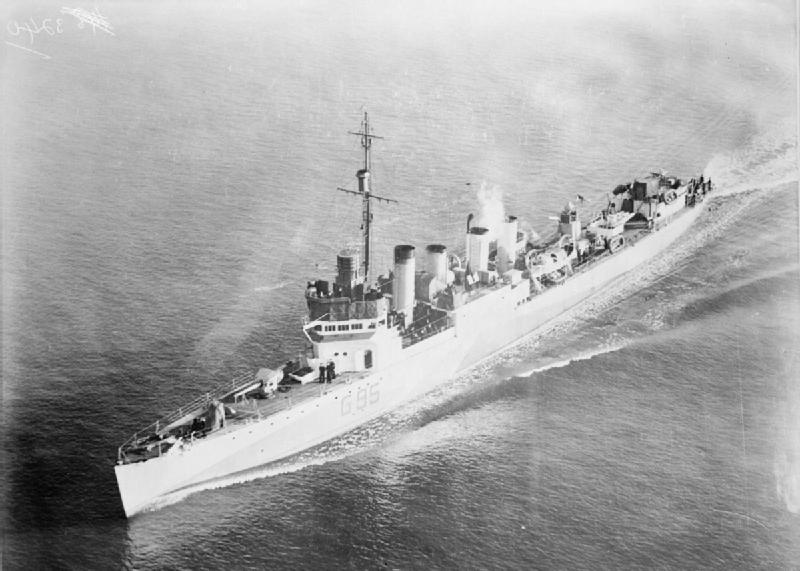
In February 1942, HMS Montgomery she was relocated to the Western Local Escort Force, Halifax. She was lated loaned to the Royal Canadian Navy and was sent for another refit at Charleston Navy Yard, US, until early 1943. She resumed coastal convoy escort by February 1943, rescued survivors of Manchester (sunk by U-628) off Cape Race. By late 1943 still based on Halifax she made more patrols, and by 27 December 1943, departed Halifax for the British Isles with survivors of HMS Hurricane (sunk by U-415, 24 December 1943). Upon arrival due to her age sge was placed in reserve on the Tyne on 23 February 1944. She was stricken from the RN list and sold for BU in the spring of 1945. In 1944 or even late 1943, many of these British operated destroyers were replaced by far better and recent British built destroyers.
Liveries and camouflages
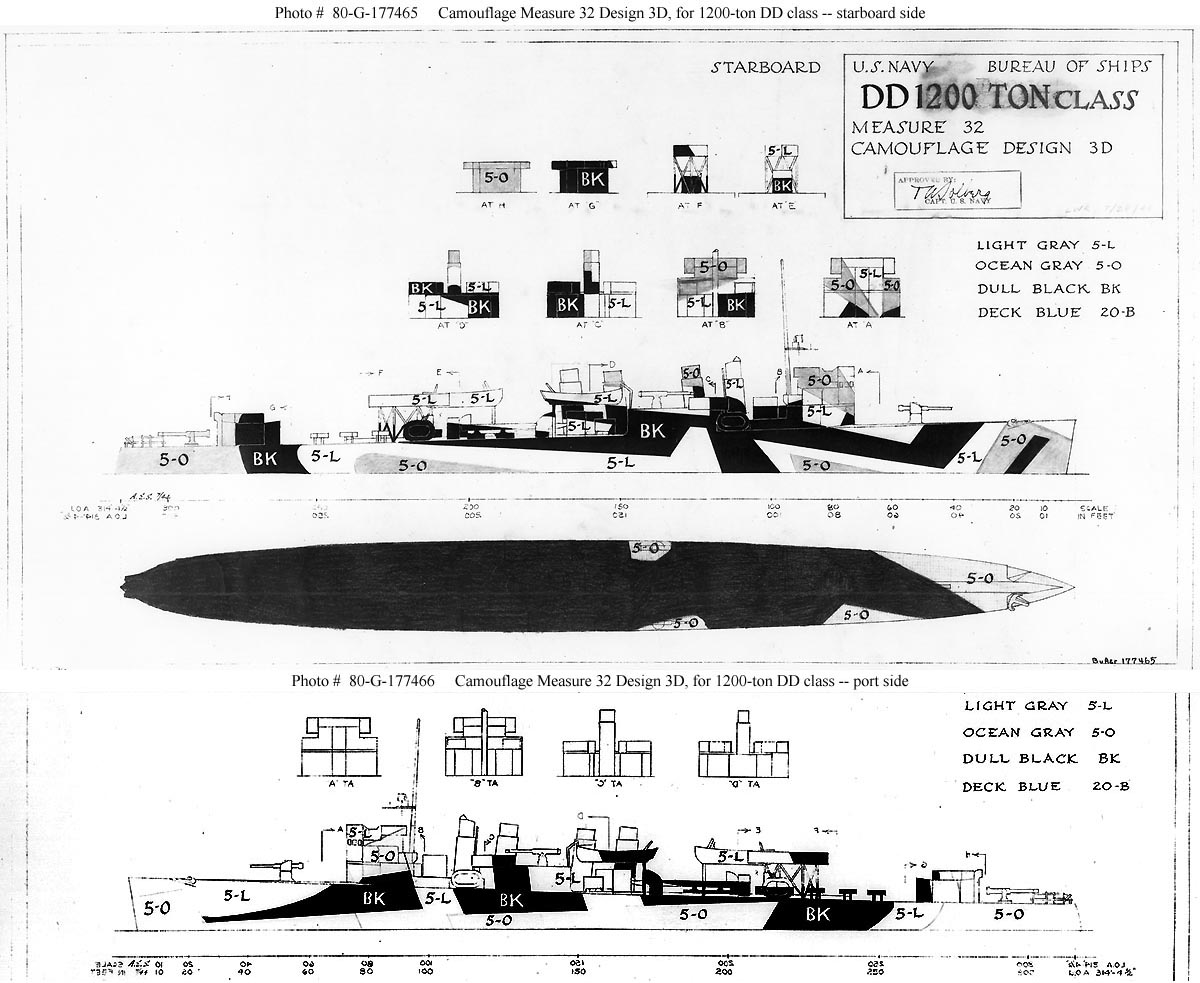
Measure MS-32 3D for the Wickes and Clemson class, 1944
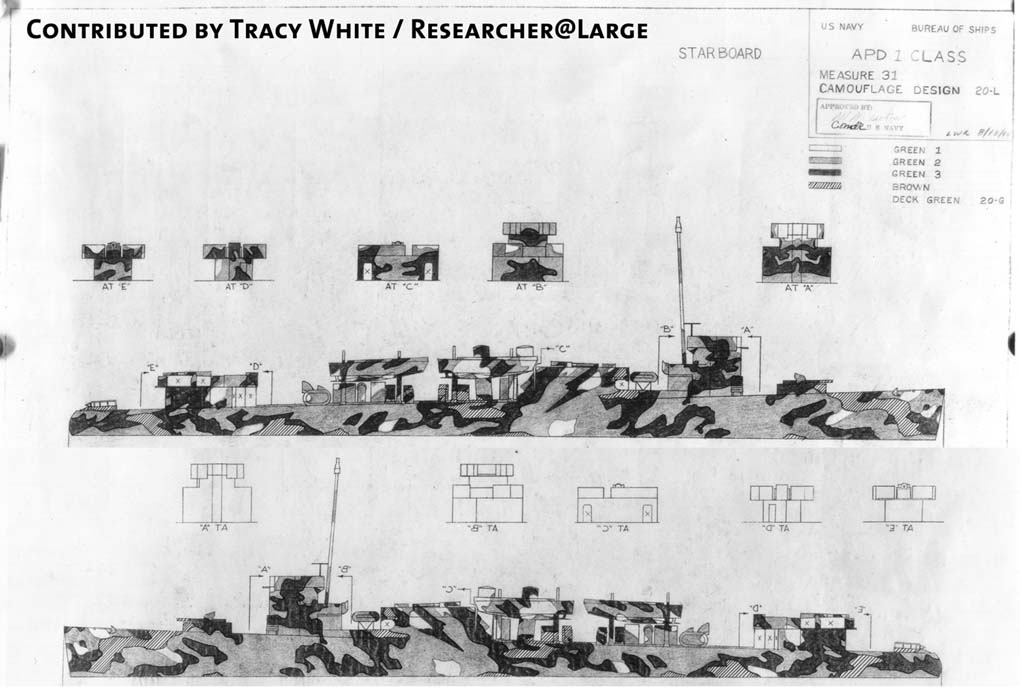
Measure 31 Design 20L APD-1 camouflage 1942
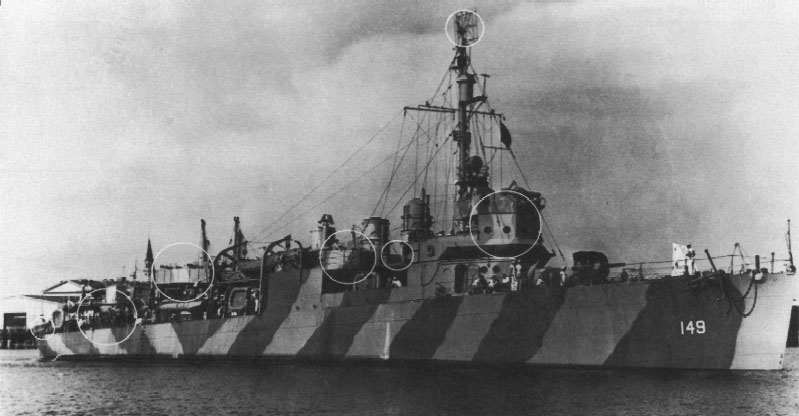
USS Barney (DD-149) taken on 20 August 1942 in Charleston. She is painted a most unusual modified Measure 12 camouflage scheme. It is worth comparing it to that of HMS Leeds (ex-USS Conner, DD-72), (USN Courtesy of Floating Drydock). Photo from Naval Camouflage 1914-1945, by David Williams via navsource.org

Author’s poster of USS Fairfax.

Author’s old rendition of USS Barney as APD “green dragon”, Guadalcanal 1942
More to come soon !
Read More
Books
Campbell, John (1985). Naval Weapons of World War Two. Naval Institute Press.
Friedman, Norman (2004). US Destroyers: An Illustrated Design History (Revised ed.). Annapolis NIP
Gardiner, Robert, Conway’s All the World’s Fighting Ships 1906-1921, Conway Maritime Press 1985.
Gardiner, Robert and Chesneau, Roger, Conway’s All the World’s Fighting Ships 1922-1946 Conway 1980.
Morison, Samuel Eliot (1962). History of United States Naval Operations in WW II. Brown and Co.
Silverstone, Paul H. (1970). U.S. Warships of World War I. Ian Allan.
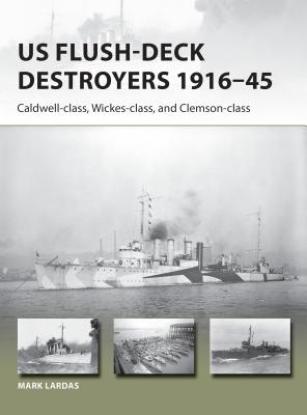
Osprey’s US Flush-Deck Destroyers 1916-45: Caldwell, Wickes, and Clemson Classes, Mark Lardas.
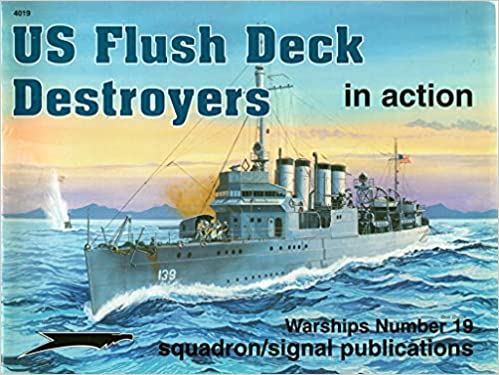
US Flush Deck Destroyers in action, Squadron Signal Pub.
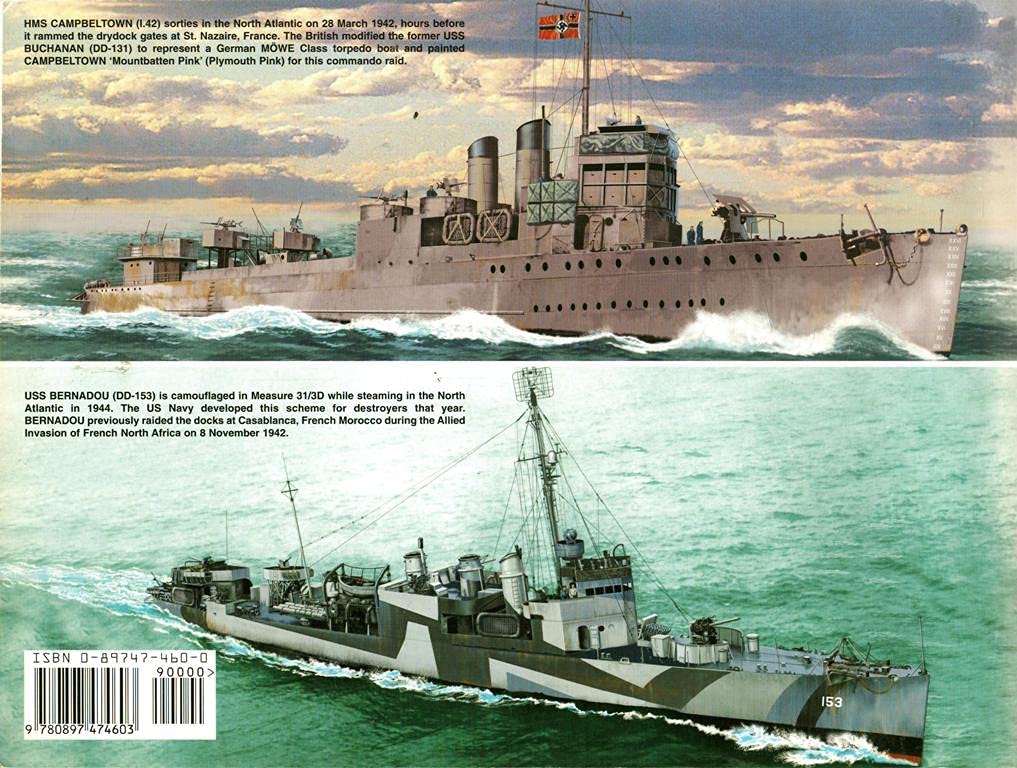
Nice renditions of the same book.
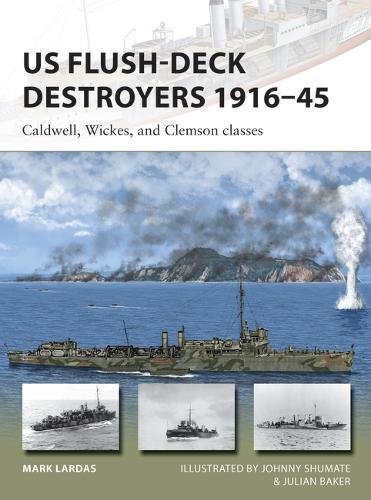
Naval Historical Fondation Book – US Flush-Deck Destroyers 1916-45: Caldwell, Wickes and Clemson Classes (New Vanguard #259) By Mark Lardas, illustrated by Johnny Shumate & Julian Baker, Osprey Publishing, Oxford, (2018).
Links
List_of_Wickes-class_destroyers
navypedia.org wickes
Wickes-class_destroyer
wickesclass on destroyerhistory.org
microworks.net
List_of_Wickes-class_destroyers
alchetron.com/
navweaps.com/ USN Mines
preliminary_design_wickes_class_destroyers
On historyofwar.org/
The town class on laststandonzombieisland.com
destroyerhistory.org/flushdeck/
Model Kits
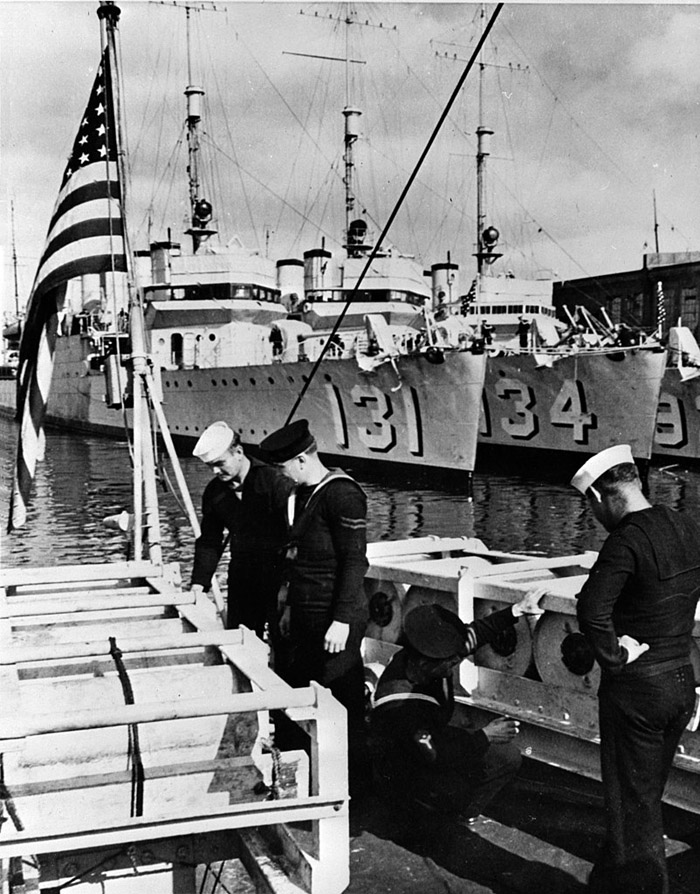
Large Model kit by SD Model Makers (1:72 for example !)
Plenty of choice – Scalemates query
Like the USS Ward Revell 1:240, same FlyHawk Model 1:700, Mirage Hobby 1:400, Bluejacket Ship Crafters 1:192, USS Decatur DD-341 1943 by Iron Shipwrights 1:350…
Superb 3D – 2D rendition of the wickes class by Admiral Horton on deviantart
3D
 Wickes (DD-75)
Wickes (DD-75)
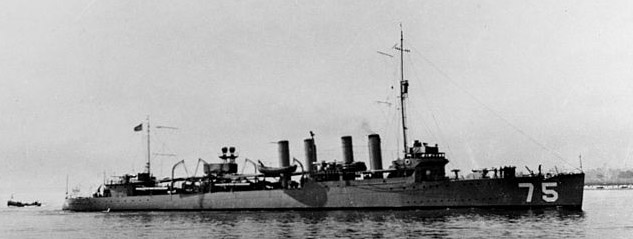
USS Wickes was Commissioned on 31 July 1918, served shoortly in WWI (collision and repairs on V Day), decommissioned 15 May 1922, recommissioned 26 April 1930, modernized, decommissioned against on 6 April 1937, mothballed, then recommissioned 30 September 1939 after the start of WW2, modernized again, but transferred to the Royal Navy on 23 October 1940, served as HMS Montgomery until BU 1945.
 Philip (DD-76)
Philip (DD-76)
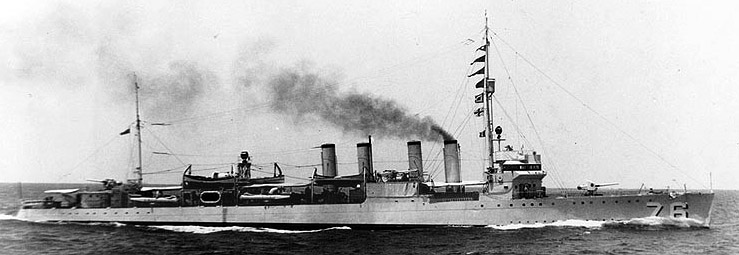
USS Philip (named after Admiral John Woodward, USS Texas 1898) was commissioned at Boston NyD on 24 August 1918. Assigned to DesRon 2, Cruiser Force, 1 September 1918, and escorted convoy HX–47 across the Atlantic. Flagship, Submarine Hunting Group at CG Station Cold Spring (Cape May, New Jersey) Sept. Oct. 1918. Ecorted convoy HX–54. Supported trans-Atlantic flight NC-1, NC-3, and NC-4 May 1919. Army experimental firing Fort Hancock, NyC. Desron 4 Pacific, San Diego, Pearl Harbor, Panama, decomm. May 1922.
Recomm. 25 February 1930, Reserve Force San Diego. Instruction NROTC 1931 New England. Special Service Squadron Panama-Nicaragua-El Salvador. 1932 reduced commission DesRon 20.
DesRon 6 Squadron 2 Battle Fleet/Reduced Comm. and training SubDiv 12. Presidential Fleet Review 1935. Decomm. San Diego, 2 April 1937, recomm. 30 September 1939, Division 64 Atlantic, neutrality patrols Florida/Canal Zone. Transferred to the RN as HMS Lancaster, Atlantic escort, stricken 8 January 1941.
 Woolsey (DD-77)
Woolsey (DD-77)
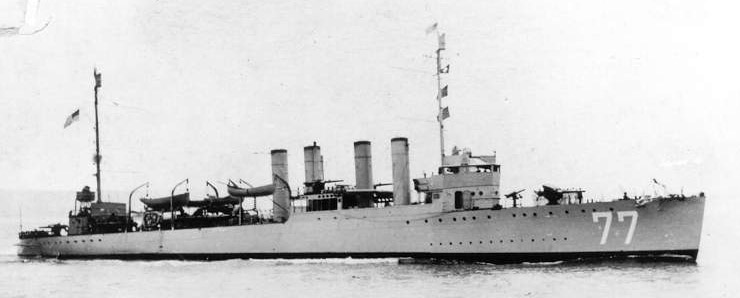
USS Woolsey (Bath Iron Works) was commissioned on 30 September 1918 (Capt. Frederick V. McNair, Jr), assigned Newport Torpedo Station, escorted battleship USS Virginia & Convoy HX 52. British escort force in October, Buncrana (Ireland), Ponta Delgada (Azores). American naval contingent, Brest, December 1918, 7 months missions between Brest and southern England. Escorted twice SS George Washington. Pacific Fleet July 1919, May 1920 overhauled Mare Island. Lost by collision 26 February 1921 with SS Steel Inventor.
 Evans (DD-78)
Evans (DD-78)

USS Evans (Bath Iron Works) was commissioned on 11 November 1918 (Capt. Frank H. Sadler). Departed 10 June 1919 for Europe and back, patroleld Central America, reassigned PacFleet San Diego. Two years. Reserve San Diego 6 October 1921, decomm. 29 May 1922. Recomm. April 1930, training naval reserve/Battle Fleet training. Decomm. 31 March 1937, recom. 30 September 1939, Key West neutrality patrols. Transferred October 1940 to the Royal Navy as HMS Mansfield, Royal Norwegian Navy (HNoMS Mansfield, December 1940), Royal Canadian Navy (HMCS Mansfield March 1942, decomm. 22 June 1944, Scrapped 1945).
 Kimberly (DD-80)
Kimberly (DD-80)
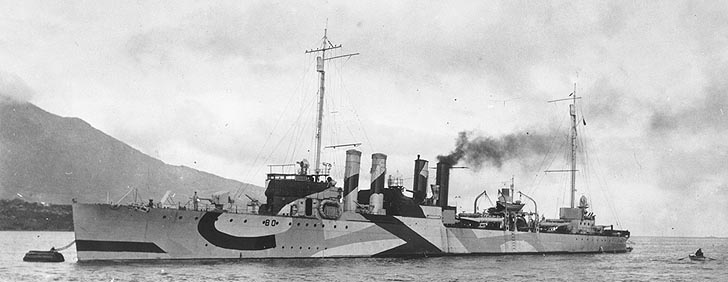
USS Kimberly moored to a Buoy in 1918, note her complex camouflage, applied very early in her career.
USS Kimberly commissioned 26 April 1918, Boston May 1918,convoy to UK. Stayed around British Isles, Queenstown Ireland; Departed for Boston 26 December 1918. January 1919 east coast TR. May lifeguard ship first transatlantic flight. August 1918 carried Undersecretary Navy FD Roosevelt and the 1st Lord Adm. Sir Eric Geddes cruise from Pembroke to Queenstown. Overhaul Boston. Decom. Philadelphia 29 March 1922, stricken 1930 sold for BU.
 Sigourney (DD-81)
Sigourney (DD-81)
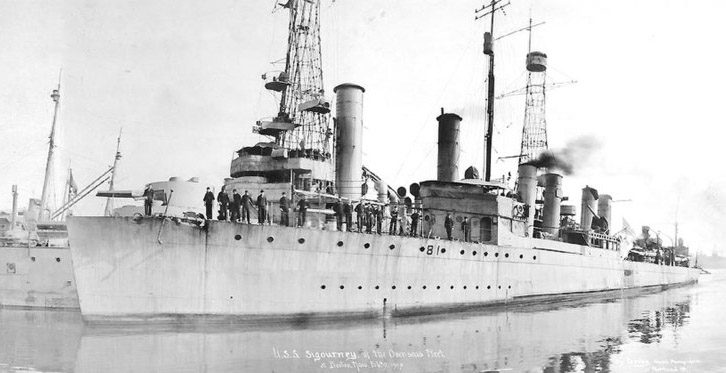
She was commissioned on 15 May 1918, escorted a troopship to France, Brest, assigned to Commander Naval Forces, escorted convoys to 500 miles west of Brest. Was flagship, screen commander. Contacts but no kill. Post-November European waters, escorted SS George Washington to France. Sailed back to Boston 8 January 1919, Overhaul, summer training Newport, reserve Philadelphia 1 November 1919, decom. 26 June 1922. Recom. Philadelphia 23 August 1940, to Halifax transferred 5 Dec. as HMS Newport stricken USN 8 January 1941. Served Royal Norwegian Navy March 1941-June 1942. Aircraft target ship (RN) from June 1943 until January 1945, scrapped February 1947.
 Stringham (DD-83)
Stringham (DD-83)
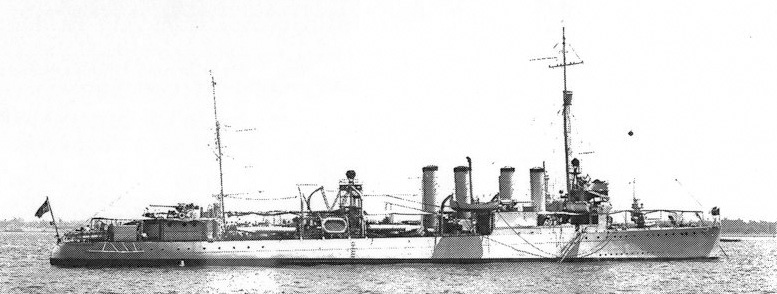
USS Stringham was commissioned on 2 July 1918. Assigned to convoy escort Altantic, back USA 1919 DesDiv 6 and December 1919-June 1920 reduced commission. Active until mid-1922. Decom. Philadelphia. Summer 1940 conveted APD-6 Norfolk Navy Yard. coastal convoys escort until late 1942. 18 April 1942, U-Boat attack, unconfirmed kill.
July 1942 transferred Southeastern Pacific, Fiji Islands, Espiritu Santo in August, resupply voyages to Guadalcanal. 23 August U-Boat contact and attack, no kill. Refit Mare Island, Russell Islands, storm damage, repairs Tulagi, Mare Island. Solomons: Vella Lavella, Mono, Stirling islands, Bougainville, Cape Gloucester. 1944 Saidor, Emirau, Green Islands. Invasion of the Marianas: Saipan, Tinian, worked with UDT 7. US overhaul, back 17 March 1945, Okinawa. Collided with La Vallette. Repaired San Diego, DD-83, decommissioned Philadelphia 9 November 1945, stricken 5 December 1945 sold and BU 1946.
 Dyer (DD-84)
Dyer (DD-84)
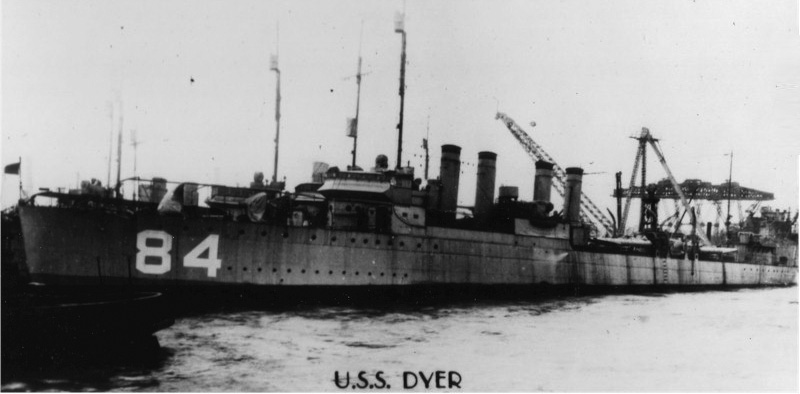
Commissioned 1 July 1918 (Capt. F. H. Poteet) Dyer was assigned to the U.S. patrol squadron in Gibraltar departing from NyC on 9 July with Assistant Secretary of the Navy Franklin Delano Roosevelt for Plymouth, England (21th) and arrived at Gibraltar on the 29th. 4 August started escort between Gibraltar and Marseilles, 9 missions before V Day. Departed Gibraltar 29 January 1919 for central-eastern Med service (Dalmatia) and Brindisi, Constantinople, Beirut, Venice, as flagship. She saw service in the Adriatic, enforcing terms traties. Back NyC 14 June 1919. October in reserve/reduced commission. Reassigned Charleston until 3 April 1922. Decommissioned Philly 7 June 1922, sold 8 September 1936. Only USN ship by that name ever.
 Stevens (DD-86)
Stevens (DD-86)
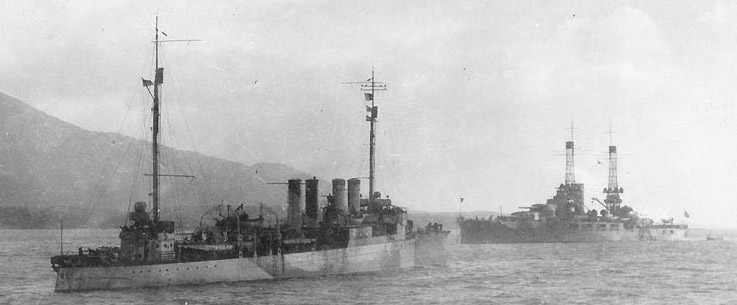
USS Stevens commissioned Boston on 24 May 1918; New York, June Europe convoy, Brest, France, Queenstown Ireland, convoys Queenstown-Liverpool, Azores-Bermuda, Boston Jan 1919. DesDiv 7, DesRon 3 Atlantic Fleet. Picket ship May 1919 transatlantic flight. Rhode Island operations, New England coast late 1921, decomm. Philadelphia 19 June 1922 until 7 January 1936, stricken 8 September 1936, sold and BU.
 McKee (DD-87)
McKee (DD-87)
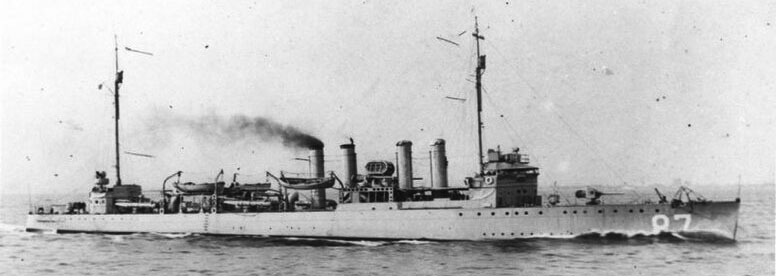
USS McKee commissioned 7 September 1918, transited Panama Canal, DesFlot 5 New York October. Convoy escort to Azores November. 1919 Guantanamo Bay exercises, cruises to Halifax, 13 December reduced commission. Decom. 16 June 1922, stricken 7 January 1936, sold, BU.
 Robinson (DD-88)
Robinson (DD-88)
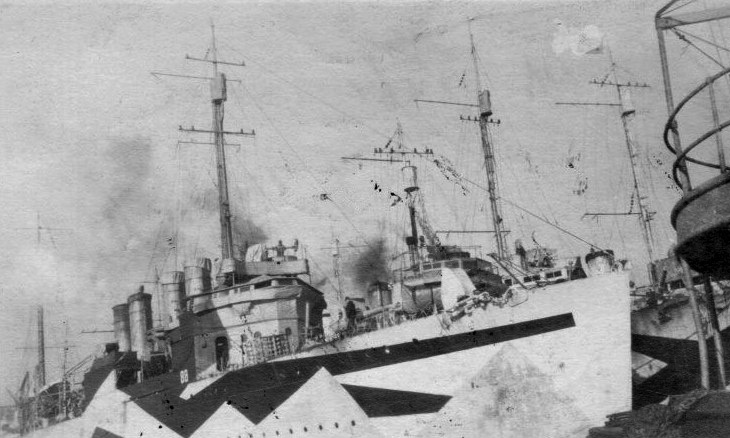
USS Robinson comm. 19 October 1918, war over. San Francisco Bay 24th for the east coast, Norfolk 8 November, winter training. NYC, picket ship first transatlantic flight. Escorted SS George Washington. Decom. Philadelphia 3 August 1922. 23 August 1940 recom. transferred 26 November as HMS Newmarket (G47), RCN. September 1943 maintenance status at Rosyth, aircraft target ship 1944, BU September 1945.
 Ringgold (DD-89)
Ringgold (DD-89)
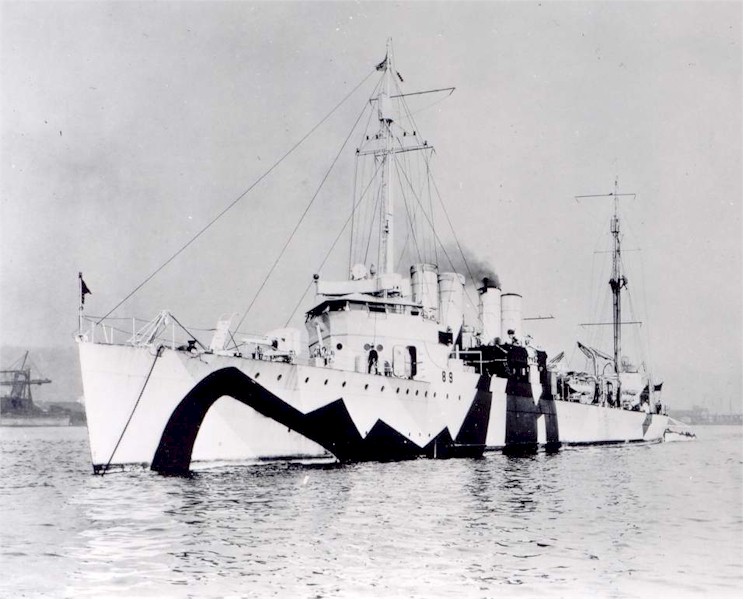
USS Ringgold commissioned 14 November 1918, Mare Island. Destroyer Force, Atlantic Fleet, Hampton Road December 1918, cruised east coast until 1922 HP Newport, decom. Philadelphia 17 June 1922, recom. 23 August 1940, transfer to Britain 26 November 1940 at Halifax as HMS Newark, RCN. Damaged in collision with Newmarket 9 December 1940, 17th DesDiv escort duty. Hit torpedo 25 August 1941, repaired Belfast. January 1945 aircraft target ship, stricken, BU 18 February 1947.
 McKean (DD-90)
McKean (DD-90)
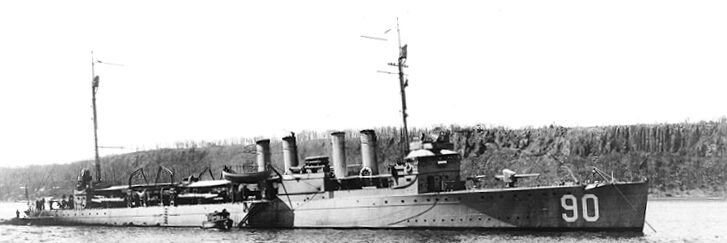
USS McKean commissioned San Francisco 25 February 1919. Atlantic fleet 1919-1922. European waters cruiser May-July 1919, New York, Charleston. Decom. Philadelphia 19 June 1922. APD-5 on 2 August 1940 Norfolk, 11 December 1940. East coast May 1942, South Pacific in July, invasion of the Solomons. Tulagi. Guadalcanal campaign. Overhaul. 1943 New Hebrides and Solomons, New Georgia and Rendova. Treasury Islands and Bougainville. Cape Torokina, Empress Augusta Bay. 17nov. struck torp. Mits. G4M “Betty” 702 Kkt starboard qut. Burned, abandoned. 64 crew + 52 troops died. She received four battle stars and Navy Unit Commendation award.
 Harding (DD-91)
Harding (DD-91)
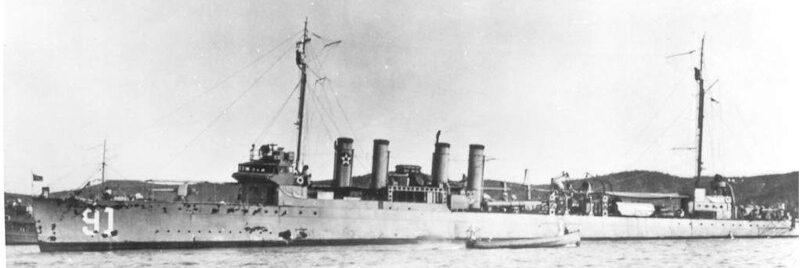
USS Harding commissioned 24 January 1919, 3 February Atlantic Fleet Newport, Santa Cruz, Cal. via Panama. Boston, to escort SS George Washington to France. Overhaul Norfolk. Plane picket ship for the tranatlantic flight, night searchlight illumination. Brest, Azores, Newport, Norfolk.
13 December 1919 Philadelphia converted to a seaplane tender on 20 May 1920, Pensacola NAS. Veracruz sanitary op. Seaplane pilot training program. Assisted bombing tests SM U-117, SMS Ostfriesland. Charleston 1922, deom. Philadelphia 1 July 1922. Sold 29 September 1936, BU.
 Gridley (DD-92)
Gridley (DD-92)

USS Gridley commissioned 8 March 1919 with Comdr. Frank Jack Fletcher in command, FO Mare Island Navy Yard, San Diego March 1919, Overhaul Norfolk, New York, transatlantic seaplane flight. Plymouth, Brest, Mediterranean, New York. Cuba, Haiti, Dominican Republic. Charleston, Newport, New York, Philadelphia decom. 22 June 1922, stricken 25 January 1937, sold 19 April 1939.
 Fairfax (DD-93)
Fairfax (DD-93)

USS Fairfax commissioned 6 April 1918, Hampton Roads June, convoy escort from Newport News to midocean meeting point with escort from French ports. Brest, recued surv. from USS Lucia. Azores and Brest escorted SS George Washington. Azores Transatlantic flight. Decom. Philly 19 June 1922 to 1 May 1930, training cruises Naval Reserve from Newport-Camden. San Diego 26 March, same. Presidential Review March 1933. East coast same to 1940, training midshipmen Naval Academy. NyC Fair April 1939, neutrality patrols. November 1940 Halifax, transferred RN as HMS Richmond. 16 July 1944 transferred to the Soviet Navy as Zhivuchy, returned 24 June 1949, scrapped.
 Taylor (DD-94)
Taylor (DD-94)
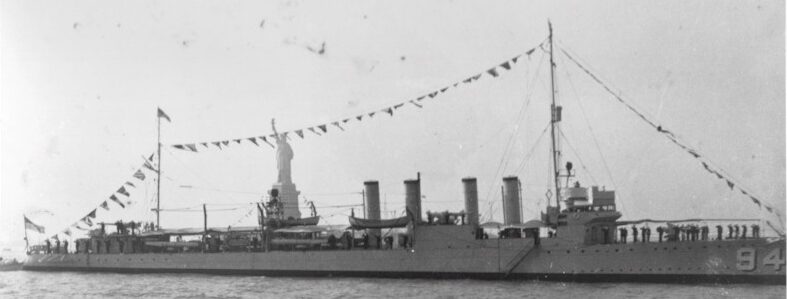
USS Taylor commissioned 1 June 1918, joined DesDiv 12, Atlantic Fleet then DesDiv 8 1919. Reduced commission 1920. Until June 1922 decom. Philly, DesDiv 8, Flot. 8, Sqn. 3.
Recom. 1 May 1930, DesDiv 33, Squn 7 Atlantic Scouting Fleet. Reduced commission, train reservists. 1931 DesDiv 28 TS Squadron to 1934 , Squadron 19 rotating reserven Special Service Squadron. Inactivated Philadelphia 23 September 1938. Stricken 6 December 1938, sold July 1939, Hulk No. 40 damage control parties TS. Torpedoed USS Blakeley repaired with 60 feet Taylor’s hull September 1942. sold 1945, BU.
 Bell (DD-95)
Bell (DD-95)
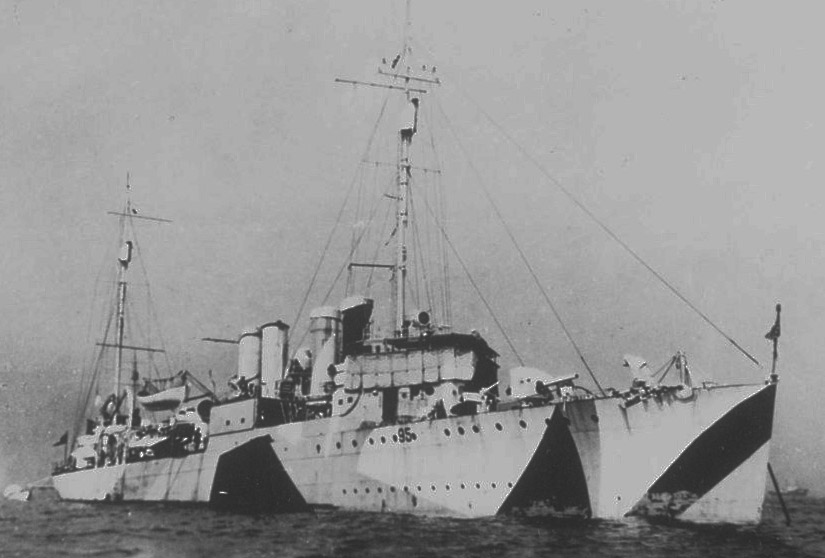
USS Bell commissioned 31 July 1918. 5 August 1918 collided with steam lighter Cornelia. August-November 1918 convoy escort North Atlantic , escorted SS George Washington. Reserve June 1920, decom. Portsmouth 21 June 1922 to August 1936. Excessed tonnage limits London Naval Treaty, reduced tohulk, sold and BU.
 Stribling (DD-96)
Stribling (DD-96)
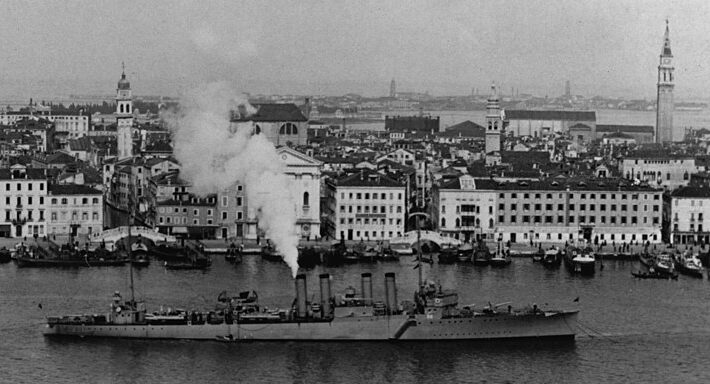
USS Stribling commissioned Boston NyD 16 August 1918. 31 August 1918 departed NY first escort Atlantic and Gibraltar-bound convoy via Ponta Delgada, Azores, Gibraltar, Marseilles and severam Gibraltar-Marseilles escorts. Nov. 1918 Venice, post-armistice observance Adriatic, Dalmatia. Back US July 1919, refit Portsmouth, red. Com. Philadelphiaconverted DM-1 July 1920. Tr. Hawaii, decom 26 June 1922. Stricken December 1936, sunk as target off San Pedro January 1937.
 Murray (DD-97)
Murray (DD-97)
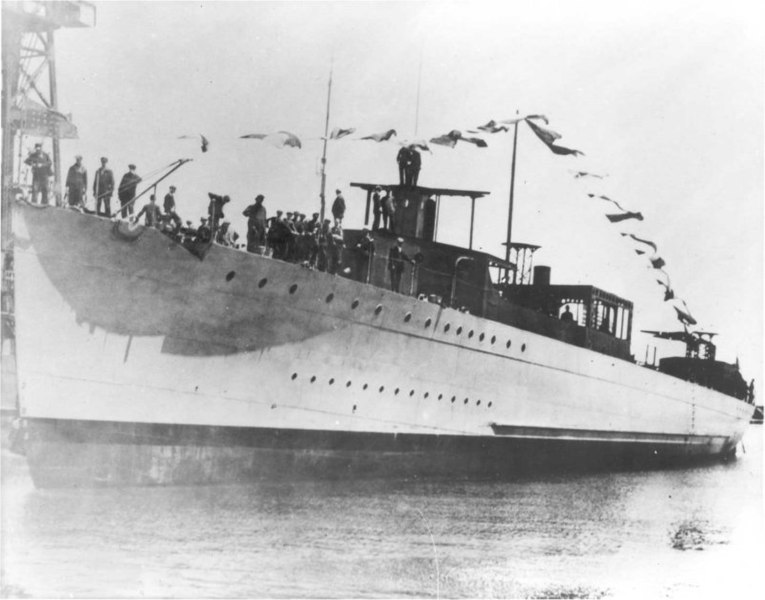
USS Murray after launch. Commissioned at Boston 21 August 1918, four years operations along the East Coast-Caribbean, Atlantic Fleet. Helped with ASW and mine warfare techniques. Converted DM-2 on 17 July 1920, decom. Philadelphia 1 July 1922, reserve, stricken 7 January 1936, sold 29 September 1936 and BU.
 Israel (DD-98)
Israel (DD-98)
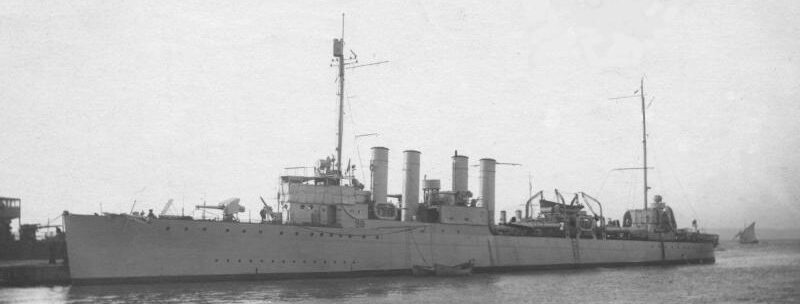
USS Israel commissioned 13 September 1918. FO Boston, escort battleship USS South Carolina Newport September 1918, escort East Coast. Left NYC 13 October, Gibraltar via Azores, escorted the Brazilian Detachment, then Eastern Mediterranean Forces. Sent Split Adiatic as station ship. Villefranche, France, Gibraltar, Azores, Boston 24 July 1919. Overhaul Portsmouth, 17 July 1920 DM-3.
East Coast Mine Squadron 1 at Gloucester. Decom. Philadelphia 7 July 1922. Reserve, hulk 1936 (London Treaty) stricken 25 January 1937, sold 18 April 1939.
 Luce (DD-99)
Luce (DD-99)
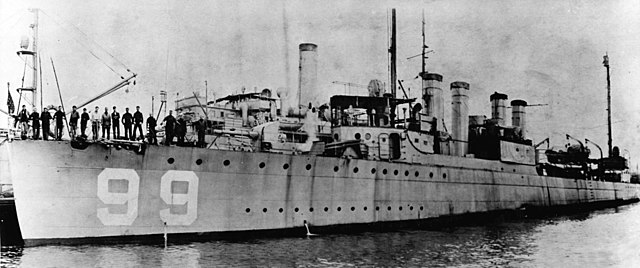
USS Luce commissioned 11 September 1918, FO Boston, Cruiser Force Atlantic Fleet NYC. Troop Convoy 67 for France via Azores, Gibraltar, patrols Mediterranea. November Adriatic Sea, five months with Food Commission. Eastern Mediterranean, Aegean, Black Seas until June 1919. Gibraltar, Azores and New York 10 July, overhaul Boston. 29 October transferred Reserve Sqn. 1 Atlantic Fleet, DM-4 March 1920, Newport, Mine Squadron 1 Gloucester. Decom. Philadelphia 30 June 1922 to 19 March 1930; Op. with subs Canal Zone Control Force. Mine Squadron 1. Decom. Boston 31 January 1931. Sold 29 September 1936 and BU.
 Maury (DD-100)
Maury (DD-100)
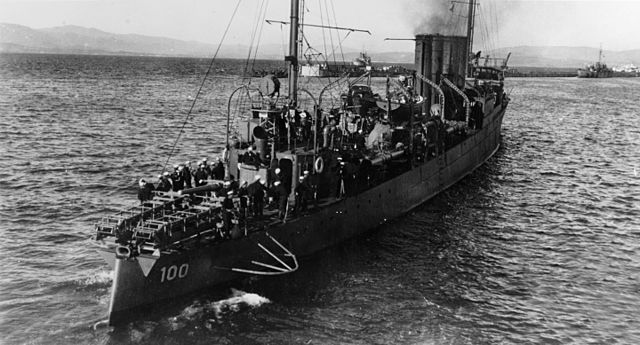
USS Maury was commissioned on 23 September 1918, based NyC November 1918, escort a convoy to France via the Azores, Gibraltar, cruised western Med, Adriatic Detachment (Venice) February 1919. Back NyC 25 July, overhaul Philadelhpia to 24 April 1920, DM-5 (light minelayer) Mine Squadron I Gloucester July 1921. 7 years East Coast, Gulf of Mexico 1929. Decom. Philadelphia 19 March 1930, stricken 22 October 1930, sold 17 January 1931.
 Landsdale (DD-101)
Landsdale (DD-101)
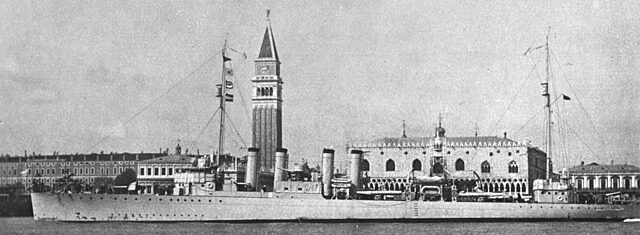
USS Lansdale was commissioned 26 October 1918 at Boston, assigned to the Cruiser/Transport Force, Norfolk November, convoy via the Azores to Gibraltar. Patrol Med, Tangier, Morocco, and one to Algiers, Algeria. Venice January, eastern Mediterranean, Adriatic, Split, Gibraltar, Azores, NyC. Philadelphia 11 July 1920 converted light minelayer DM-6. Newport, Mine Force Atlantic Fleet Gloucester. Decom. Philadelphia 25 June to 1 May 1930, Mine Squadron 1t Yorktown, New London target ship for submarines. Decom. Philadelphia 24 March 1931. 28 December 1936 hulk for disposal, stricken 25 January 1937, sold 16 March 1939.
 Mahan (DD-102)
Mahan (DD-102)
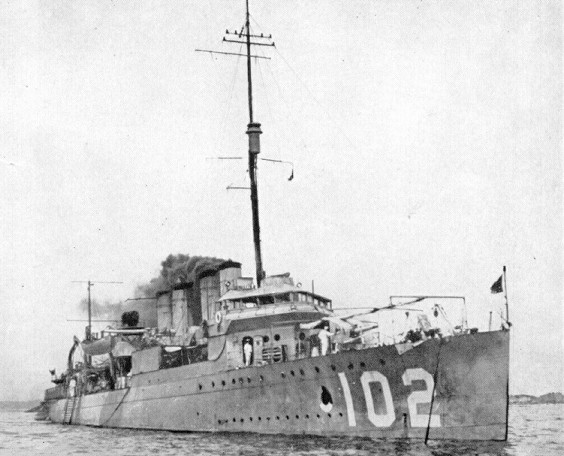
USS Mahan Commissioned 24 October 1918; operated off Cuba until May 1919, Azores, picket transatlantic flights. Converted light minelayer DM-17 July 1920. East Coast but short stay at Pearl Harbor early 1925, 10 years service. Patrolled courses for the International Six Meter Sailing Races 1922 and1927. Salvage operations for S-51 September 1925 and S-4. Reserve-training cruises Caribbean until Sept. 1929. Experimental ship. Decom. 22 October 1930, Sold for scrap 17 January 1931.
 Schley (DD-103)
Schley (DD-103)
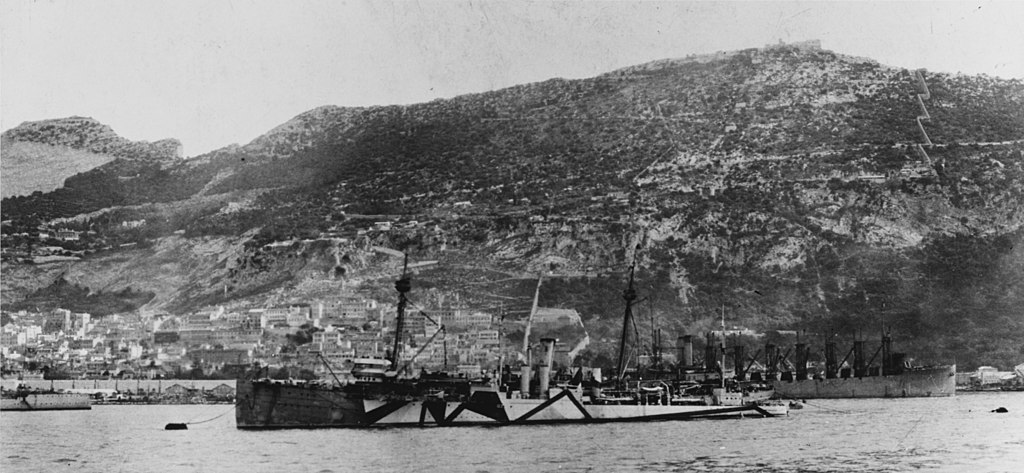
USS Schley comm. 20 September 1918. San Diego 10 October, east coast November departed NYC for the Med. Jan 1919 Taranto with RADM Mark L. Bristol aboard to Constantinople. Adriatic Sea, station ship at Pola. Back US 2 July, San Diego September, overhaul San Francisco, decom. 1 June 1922. Recom. 3 October 1940, Pearl Harbor 17 December. On 7th 1941, overhaul. 20 December patrol station channel Pearl Harbor. December 1942 converted Puget Sound as APD-14, comp. 6 February 1943.
Pearl Harbor and New Hebrides, Espiritu Santo. Used by Marine raiders in the Solomons, New Hebrides, Samoa, New Zealand, New Georgia. Invasion of Marshall Islands. Kwajalein, Eniwetok; New Guinea, Aitape, Tumleo Island, Niroemoar Island, Biak, Cape Sansapor. Overhaul Australia. Philippines Campaign, Morotai, Leyte Gulf, Ormoc Bay, Mindoro, Lingayen, Mariveles Bay, Manila Bay, Corregidor. Ulithi 25 February 1945, escorted convoys western Pacific, Okinawa. Overhaul San Diego, DD-103 auxiliary; Decom. Philadelphia 9 November 1945, stricken 5 December 1945, sold 29 March 1946. Awarded 11 battle stars.
 Champlin (DD-104)
Champlin (DD-104)

USS Champlin commissioned 11 November 1918 (Lt. Cdr F. M. Knox). December Atlantic Fleet, Caribbean, NyC November 1919 for San Diego, reserve PacFleet, reduced complement, decom. 7 June 1922, Laid up San Diego, used for experiments 19 May 1933, sunk in tests 12 August 1936.
 Mugford (DD-105)
Mugford (DD-105)
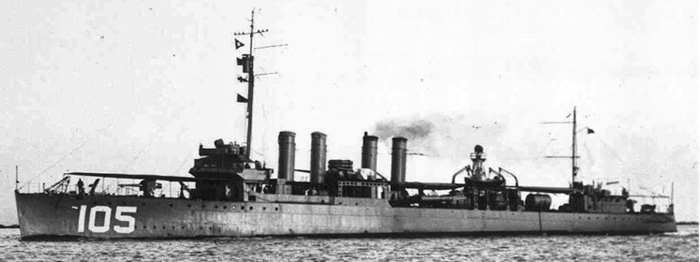
USS Mugford commissioned 25 November 1918 San Francisco. Panama, winter exercises Guantanamo Bay January 1919, East coast training New York-Massachusetts, back San Diego, Seaplane tender along the California coast. Decom. San Diego 7 June 1922, sold 1936.
 Chew (DD-106)
Chew (DD-106)

USS Chew commissioned 12 December 1918. East Coast 21 December, Newport January 1919. Picket ships first transatlantic seaplane flight. San Diego October, reduced com. Nov. 1919, Naval reservists, decom. 1 June 1922 to 14 October 1940, Defense Force, 14th Naval District. Pearl Harbor December 1940, DesDiv 80 (Allen, Ward, Schley). 7 December 1941 Berth X-5, had one aircraft dow, two damaged. Patrolled for Japanese submarine activity, spots, reported two destroyed. Some escortts from Pearl to San Francisco and Seattle. Departed Pearl Harbor on 21 August 1945, decom. Philadelphia 10 October 1945, sold 4 October 1946.
 Hazelwood (DD-107)
Hazelwood (DD-107)
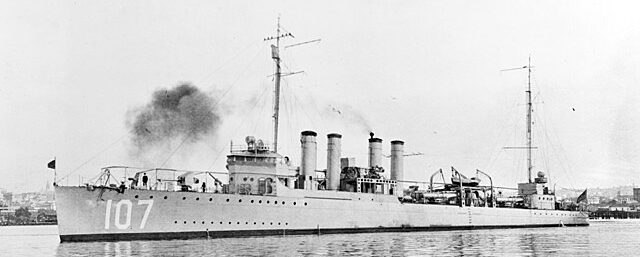
USS Hazelwood commissioned 20 February 1919. Norfolk, New York, Mediterranean May 1919 via Gibraltar, escort to USS Arizona (BB-39). Malta July, NyC 13 August. PacFleet, San Francisco 5 September. Decom. San Diego 7 July 1922 to 1 April 1925, training 5 years, decom. 15 November 1930 San Diego, sold 30 August 1935.
 William (DD-108)
William (DD-108)
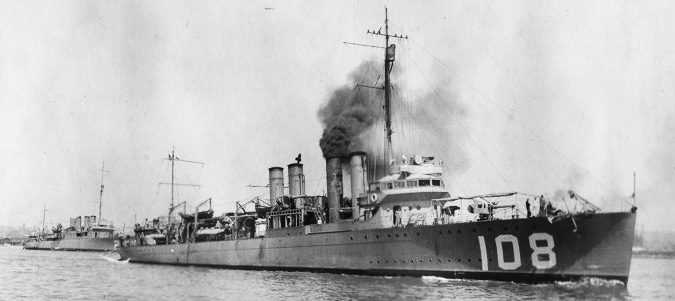
USS Williams Commissioned 1 March 1919, East Coast, until Decom. 7 June 1922, recom. 6 November 1939, decom. 24 September 1940 transferred Halifax, to RCN 24 September 1940 as HMCS St. Clair (I65), discarded 1944, sold 1946.
 Crane (DD-109)
Crane (DD-109)
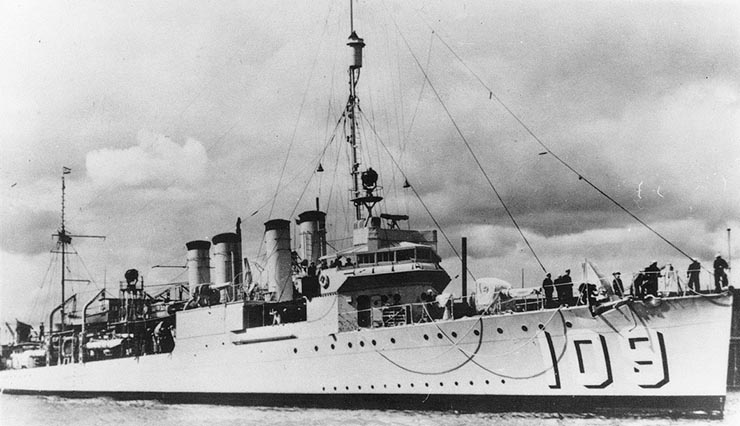
USS Crane commissioned 18 April 1919 San Francisco, Newport, in May. European waters June, England, France, escort SS George Washington. PacFleet San Francisco September. Naval Review, visited Secretary of the Navy Josephus Daniels. Decom. San Diego 7 June 1922, to 18 December 1939. Neutrality Patrol Pacific, TS for naval reservists. Remained in WW2 ASW patrol, local escort, training, screening duty for amphibious exercises, until 22 April 1944. West Coast Sound Training School. Philadelphia 19 October, decom. 14 November, sold 1 November 1946.
 Hart (DD-110)
Hart (DD-110)

USS art commissioned 26 May 1919, destroyer force California coast, until 17 July 1920. Conv. light minelayer DM-8 in Mare Island. Mine Detachment, Asiatic Fleet, Philippines November 1920. San Diego from Manila 24 January 1931. Decom. 1 June 1931, stricken, sold 25 February 1932 (London Treaty).
 Ingraham (DD-111)
Ingraham (DD-111)
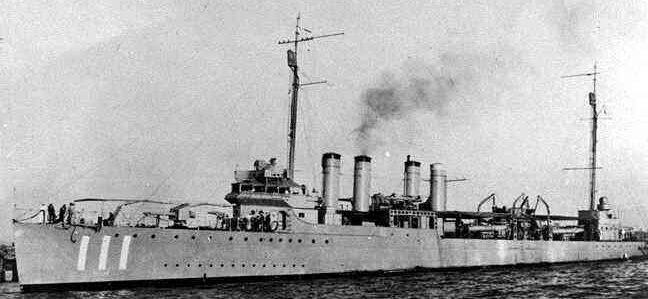
USS Ingraham commissioned 15 May 1919. Based Newport 6 June. European tour of duty, Ostend (King and Queen of Belgium to Calais, France). San Diego 8 January 1920. Connverted as minelayer DM-9, California coast. Pearl Harbor 18 June 1920 until decom. 29 June 1922. Stricken 1 December 1936, sunk as target off Pearl Harbor 23 July 1937.
 Ludlow (DD-112)
Ludlow (DD-112)
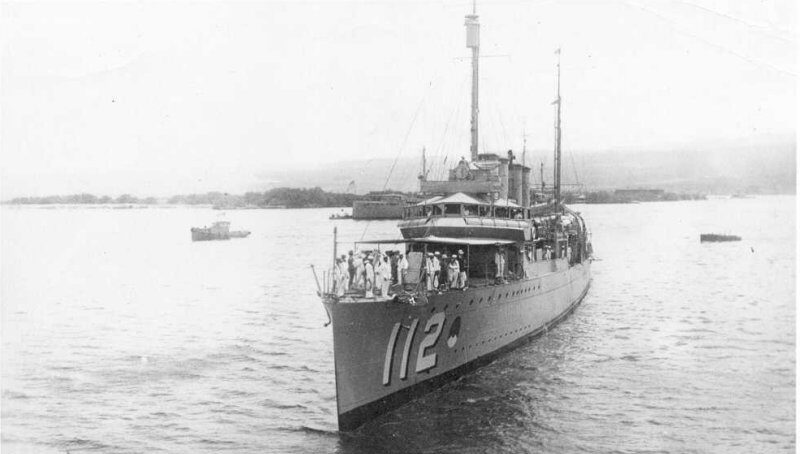
USS Ludlow commissioned 23 December 1918. Continuous training program 1918, 17 July 1920 light minelayer DM-10, transferred Pearl Harbor, eight years Mine Squadron 2. 1929 TS Naval Reserves. San Diego decomm. 24 May 1930. Stricken 18 November 1930, sold 10 March 1931.
 Rathburne (DD-113)
Rathburne (DD-113)
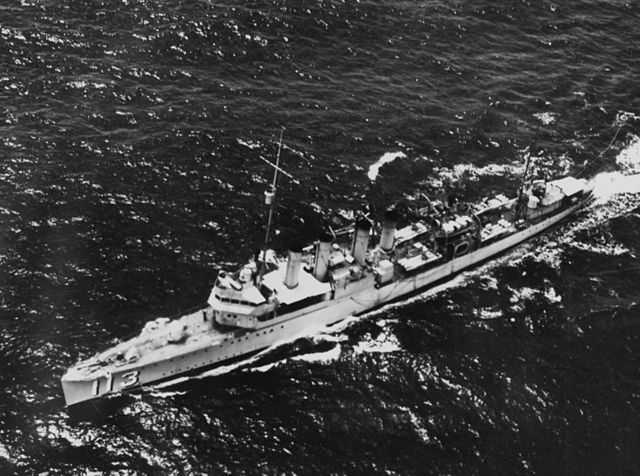
USS Rathburne commissioned on 24 June 1918, escorted coastal convoys to mid-Atlantic seaboard, Halifax, and Azores. 1919 Cuba winter maneuvers, Brest summer, New York, transferred PacFleet. 1920 overhaul Puget Sound. Asiatic sqn., Cavite, China coast, Japan, Midway, Pearl Harbor, San Francisco. HP San Diego, decom. 12 February 1923 until 8 February 1930. Transferred eastern Pacific. 1941 to 1944 West Coast Sound Training Squadron and schoolship. Converted high-speed transport APD-25 20 May 1944. Summer training with underwater demolition teams (UDT). TG 32.5 September, Palaus, Peleliu and Angaur with UDT 10, UDT 8. Ulithi, Falalop and Asor beaches. New Guinea and Admiralties, invasion of Leyte. Kossol Roads, Solomons, New Caledonia, New Guinea. Luzon offensive, Lingayen Gulf TU 77.2.1. San Pedro Bay, Saipan, Iwo Jima, Bonins, Guam, Okinawa, Kerama Retto, Hagushi. Damaged by kamikaze. Repaired San Diego 18 June 1945, auxiliary DD-113 20 July, east coast, Philadelphia decom. 2 November 1945. Stricken 28 November, sold November 1946. Earned six battle stars.
 Talbot (DD-114)
Talbot (DD-114)
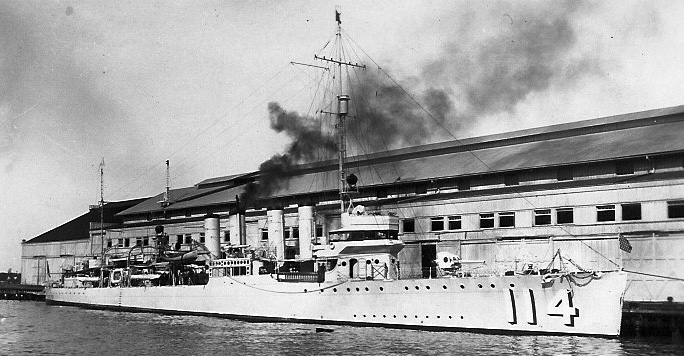
USS Talbot commissioned 20 July 1918. NuC 31 July, British Isles and Brest. 1919 Pacific Fleet, Sa, Diego, decom 31 March 1923 to 31 May 1930, DesRon 10 San Diego until 1937. Supprt ship for Submarine Force, Pacific Fleet. 1939, still Submarine Force. In 1940-1941 San Diego. Escorted USS Saratoga to Hawaii, Pearl Harbor. Escort 12th Naval District. Escorted S-18, S-23, and S-28 to Alaska, Dutch Harbor. Seattle, patrol and escort Alaskan waters. October 1942 conv. high-speed transport, APD-7 in Mare Island. March in Hawaii, Espiritu Santo, TransDiv 12. TG 31.1 Rendova Attack Group, invasion of New Georgia. Guadalcanal, occupation of Vella Lavella with TG 31.5; Treasury Islands. Noumea for reinforcements to Bougainville, Empress Augusta Bay. Guadalcanal. Nouméa, Sydney, Espiritu, Guadalcanal. Pearl Harbor, Eniwetok, Manus, TG 77.6. Cape Gloucester, Seeadler Harbor. Showered by explosion USS Mount Hood. Noemfoor Island TU 77.9.8, Lingayen Gulf. Luzon, Mindoro, Bataan, Corregidor. Guam, Ulithi, Okinawa, Kerama Retto, Saipan. Decom. back to San Pedro 6 July, DD-114, inactivated, decom. 9 October, stricken 24 October 1945, sold 30 January 1946. Earned 8 battle stars.
 Waters (DD-115)
Waters (DD-115)
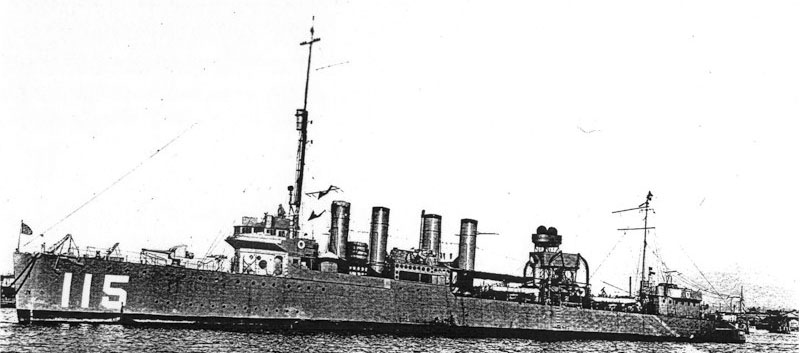
USS Waters commissioned Philadelphia NyD 8 August 1918. British Isles, Azores, armistice. New trip to Devonport, third to Ireland, Buncrana. HP Newport, new convoy to Azores. Philadelphia, NyC, picket for transatlantic flight; Escorted SS George Washington. Panama, west coast, San Diego, Hawaiian Islands, decom. San Diego 21 September 1919 to 24 February 1920. Bremerton, Puget Sound, San Diego, Division X 1921, Pearl Harbor, Midway, Guam, Manila Bay, Asiatic Fleet, Cavite. Chefoo-Chinwangtao, Nagasaki. San Francisco, San Diego, decom. 28 December 1922 to 4 June 1930. Hawaiian Islands, DesDiv 5 and DesDiv 19. Dec. 1941 in San Diego, Sound School. Escot missions from Seattle to Alaska and Aleutians. Puget Sound 19 December 1942, conv. to APD-8. Pearl Harbor, Noumea, Espiritu Santo, carried 4th Marine Raider Battalion Fiji Islands. Guadalcanal, northern Solomon, New Georgia, Vella Lavella, Bougainville, Treasury Island, Green Islands, Rendova, Munda, Bougainville. Became flagship for TransDiv 12 and TG 52.8 Eastern Landing Group: Saipan, Eniwetok, Tinian, Iwo Jima, Okinawa. San Pedro 21 July, overhaul, DD-115, decom. October 1945, stricken 24 October 1945, sold 10 May 1946. Earned 7 battle stars.
 Dent (DD-116)
Dent (DD-116)
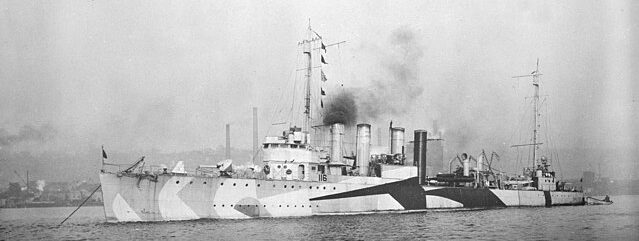
uss Dent Commissioned 9 September 1918. Escorted a convoy to Ireland 19 September-8 November. 1 May 1919 Trepassey Harbor, Newfoundland, first aerial Atlantic crossing. Newport, then escorted yacht Imperator (President of Brazil) from New York to Newport. Transferred San Pedro 6 August 1919; Hawaii with Secretary of the Navy aboard to Seattle, Fleet Review. Reduced complement, decom 7 June 1922 to 15 May 1930, Plane guard, reservists TS, fleet problem 1934. Rotating Reserve San Diego, where she was 7 December 1941. Screened USS Saratoga to Pearl Harbor. San Francisco 29 December 1941, Sound School San Diego, convoy duty until 27 April 1942, Alaska, invasion of Adak. APD-9 on 7 March 1943. New Caledonia April 1943 to Espiritu Santo. Assaults on New Georgia, Rendova, Vella Lavella, Cape Torokina, Bougainville. Overhaul Sydney, New Guinea. Grounded on uncharted shoal, repaired Australia until January 1944.
Emirau Island, Aitape landings, Solomons, invasion of the Marianas, Guam, Saipan, Tinian, Eniwetok, overhaul at San Diego.Served with the Amphibious Training Force, Pacific Fleet in San Diego. Decom. Philadelphia 4 December 1945, sold 13 June 1946. Earned 5 battle stars.
 Dorsey (DD-117)
Dorsey (DD-117)

USS Dorsey was Commissioned on 16 September 1918, Philadelphia, escort to Ireland, and back New York October. Other escort to Azores, then New York-East Coast until 13 January 1919. Escorted SS George Washington. Served in the Med until 9 July 1919. September west coast, San Diego. June 1921 Asiatic Fleet, Cavite, August. Shanghai, Chefoo, Nagasaki, Pearl Harbor, San Francisco, decom. San Diego on 9 March 1923 to 1 March 1930, plane guard for aircraft carriers and tactical maneuvers. Mare Island 1935, mod. as high-speed target towing vessel. Canal Zone, 1938-1939 Caribbean, July 1940 Pearl Harbor. Reclassified DMS-1 19 November 1940. With TF 3 Dec. 41 to Johnston Island. Pearl servoce until 24 September 1943. New Hebrides, New Caledonia, Solomon Islands (patrol and minesweeping operations). Bougainville, Florida Island, Kwajalein, Manus, New Georgia. Invasion of Lingayen Gulf, Iwo Jima, Okinawa. Grounded by severe typhoon, decom. 8 December 1945, Hull destroyed January 1946. Awared 6 battle stars.
 Lea (DD-118)
Lea (DD-118)
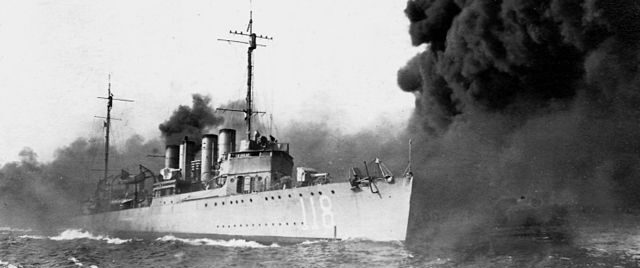
USS Lea commissioned 2 October 1918, Atlantic DesRon 19 in 1919, Pacific Fleet 1920, decom. San Diego 22 June 1922 – 1 May 1930 and 7 April 1937 – 30 September 1939. Neutrality Patrols in 1940. Occupation of Iceland 8 July 1941. Convoy escort duty North Atlantic, Caribbean, eastern seaboard. 22 April-30 May 1943 hunter-killer group USS Bogue, first mission. Shared an awarded Presidential Unit Citation. December 1943 rammed by merchant ship, repaired Boston 28 June 1944. Used as target ship for torpedo planes and same in January-June 1945 off Florida. Decom. Philadelphia 20 July 1945. Stricken 13 August 1945, sold 30 November 1945.
 Lamberton (D-119)
Lamberton (D-119)

USS Lamberton commissioned 22 August 1918. Atlantic service early 1919. Transferred to San Diego August 1919, served until June 1922. Decom. 30 June 1922 until 15 November 1930. “miscellaneous auxiliary” AG-21 16 April 1932, converted as target-towing ship 1933-1940 and “destroyer minesweeper” DMS-2 19 November 1940. Pearl Harbor September 1941. July 1942, Aleutian Islands campaign. San Diego July 1943. miscellaneous auxiliary AG-21 5 June 1945. Damaged by Typhoon louise 9 October 1945 off Okinawa, ran aground, refloated, decom. Bremerton 13 December 1946, sold 9 May 1947.
 Radford (DD-120)
Radford (DD-120)
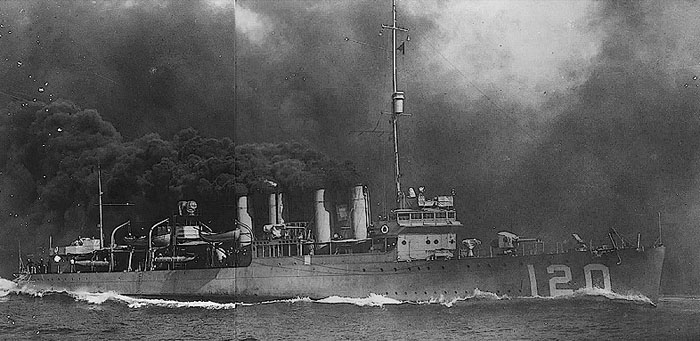
USS Radford commissioned 30 September 1918, Norfolk; Escort force Newport News section, Troop Convoy 76. Operated east coast 1919. Pacific Fleet July 1919, San Diego, DesDiv 12. Seattle, Tacoma, and Bellingham, Portland, 1920-21. Reclassified AG-22 16 April 1932, mobile target vessel. Stricken 19 May 1936, sunk 5 August 1936.
 Montgomery (DD-121)
Montgomery (DD-121)
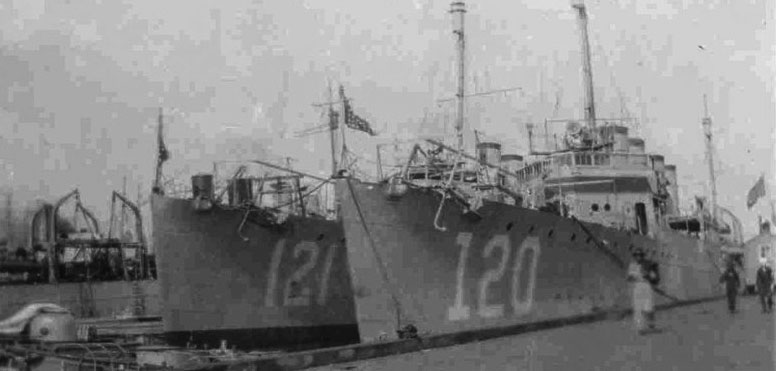
USS Montgomery commissioned 26 July 1918, east coast service, August 1918 ASW patrol, exercises from Maine to Cuba until 19 July 1919, West coast San Diego 7 August, DesRon 4, PacFleet. Operations from Alaska to Panama, decom. 6 June 1922 San Diego, converted DM-17 5 January 1931, recom. 20 August 1931. Pearl Harbor until 14 June 1937, decom. San Diego 7 December 1937 until 25 September 1939. Sent 11 April 1942 Suva, Fiji, Espiritu Santo, Nouméa in escort, minelaying operations, Aleutians Campaign, Guadalcanal. 25 August 1943 collided with Preble, repaired Tulagi and San Francisco. Escorts between San Francisco and Hawaii until 5 February 1944, minelaying around Kwajalein, escort to Majuro. Attacked a sub on 25 June 1944. Palaus Campaign, Peleliu, Angaur, Ulithi. Off Ngulu 17 October sighted a mine close aboard to port, pushed by wind, exploded as she had her engine shut; Saved, towed to Ulithi for repairs, San Francisco but decommissioned 23 April 1945. Sold 11 March 1946. Axared four battle stars.
 Breese (DD-122)
Breese (DD-122)

Commissioned as a destroyer in 1919, she undertook a number of patrol and training duties along the East Coast of the United States until being decommissioned in 1922. Overhauled in 1931, she returned to service with the United States Pacific Fleet on training and patrol for the next 10 years. She was present during the attack on Pearl Harbor, and following this she supported several operations during the war, laying minefields and sweeping for mines in the Pacific. Following the end of the war, she was sold for scrap in 1946 and broken up.
 Gamble (DD-123)
Gamble (DD-123)
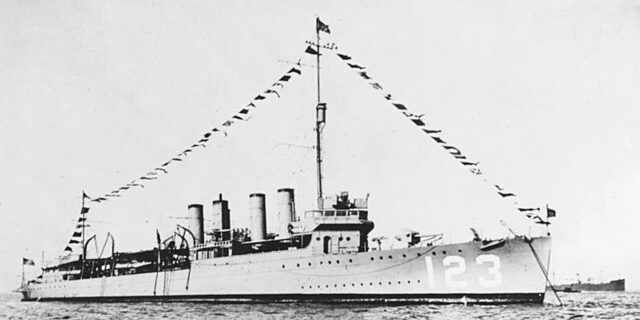
Completed 29 november 1918. NYC January 1919, maneuvers off Cuba, Key West, New England. Pacific Fleet, San Diego August 1919. Reserve, training ship for reservists, decom. San Diego 17 June 1922.
Recom. 24 May 1930 DM-15 Mare Island, Pearl Harbor, West Coast flagship MinesRon 2 and 1, decom. 22 December 1937-25 September 1939. MineDiv 5 San Francisco. April 1941 Pearl Harbor, MineDiv 2.
Attacked 7 December 1941. Mistook and fired at USS Thresher (SS-200). ASW patrols for USS Enterprise. Feb 1942, Samoa, Tutuila. Fiji, Midway Espiritu Santo. Guadalcanal Campaign. Sunk I-123. 6 May 1943 night battle Kula Gulf with “Tokyo Express.” Invasion of New Georgia, Empress Augusta Bay, Bougainville Strait, Purvis Bay, Florida Island, refit San Francisco October 1944. Iwo Jima February 1945. 18 February 1945 hit by two 250 lb (113 kg) bombs. Repaired Saipan USS Hamul. Decom. June 1945, scuttled at Apra Harbor. 7 battle stars.
 Ramsay (DD-124)
Ramsay (DD-124)

USS Ramsay was commissioned on 15 February 1919. DesDiv 12 Atlantic Fleet. Azores for the NC transatlantic flights. July transfer to the Pacific, San Diego, overhaul Mare Island. Decom. 30 June 1922, recom. 2 June 1930 light minelayer DM-16, Pearl Harbor. Decom. 14 December 1937-25 September 1939, MinDiv 5, trained naval reservists.
December 1940 Pearl Harbor, MineDiv 5 and 2. 7 December 1941 fired at IJN planes. Offshore patrol, contact submarine, possible kill. Patrol escort services. Samoa, Tutuila, Apia, Suva, Fiji Islands. New Hebrides, Efate. September, Aleutians. Overhaul at Hunters Point, 1943 Aleutians, patrols Unalaska-Attu. ServRon 6 Pearl HarborJanuary 1944, Gilberts, Tarawa, TG 50.15, Wotje, Majuro, Sub Training Force late 1944 and 1945, reclassified AG-98, plane guard Hawaii. Decomm. San Pedro 19 October 1945, stricken, sold 21 November 1946. Earned 3 battle stars.
 Tattnall (DD-125)
Tattnall (DD-125)

USS Tattnall commissioned 26 June 1919. Cruiser eastern Mediterranean 1919, Constantinople 27 July. June 1920 back USA. Overhaul, Pacific Fleet, San Diego December until 15 June 1922, decom.
Recom. 1 May 1930, Battle Force west coast until 1931. East Coast DesDiv 7 1932. Rotating reserve. January 1934 Scouting Force Training Squadron. Training Squadron 1935. Training Detachment, Scouting Force Training Squadron 1937-1938. November 1938 Special Service Squadron, Canal Zone. September 1940 coastwise convoys. July 1943 redesignated APD-19. April 1944 flagship of Transport Division (TransDiv) 13, only high-speed transport division in the Atlantic theater. Oran (Algeria) operations, 8th Fleet, Corsica (Elba and Pianosa Islands). Civitavecchia. Diversion helped Monte Cassino offensive. American-Canadian 1st Special Service Force Hyeres Islands (Toulon) Operation Anvil Dragoon southern France. Escorted convoys Mediterranean. Back to Norfolk, trasnferred Pacific. At Okinawa 19 April. Screen station for kamikazes. Philippines, Saipan, Leyte patrols and Ulithi-Hollandia escort. Back US September, San Francisco, Puget Sound, stricken 8 January 1946. Sold 17 October 1946. 3 battle stars.
 Badger (DD-126)
Badger (DD-126)
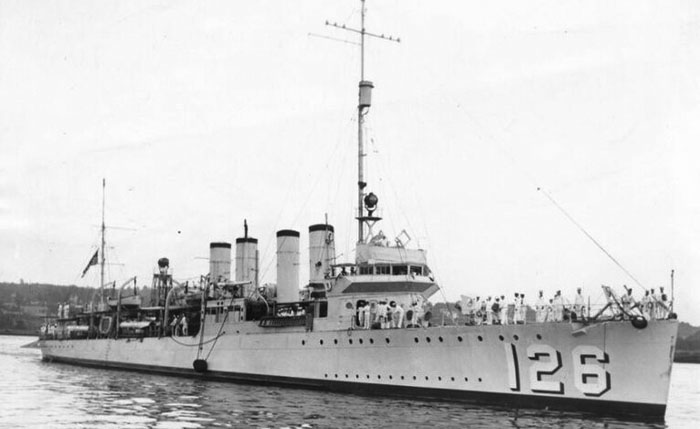
USS Badger commissioned 29 May 1919, Atlantic Fleet. Mediterranean cruise until August 1919. Assigned Pacific Fleet, San Diego September 1919, until May 1922, decom. Recom. January 1930, Battle Force & Scouting Force Pacific. April 1933 Atlantic, reserve training. 1938-1939 Special Squadron 4 Villefranche-sur-Mer, France. Des Div 53, Patrol Force and Midshipmen Coastal Cruise Detachment.
March-April 1941 refit for escort duties. December 1941-October 1944 convoy escort Atlantic-Caribbean and North Africa Oct.-Nov. 1943, February–March 1944, hunter-killer group, TG 21.12, 21.16.
October 1944, operated off Balboa, Panama. 15 November 1944-20 June 1945 ASW Development Detachment Port Everglades. Decom. Philadelphia 20 July 1945, sold 30 November.
 Twiggs (DD-127)
Twiggs (DD-127)
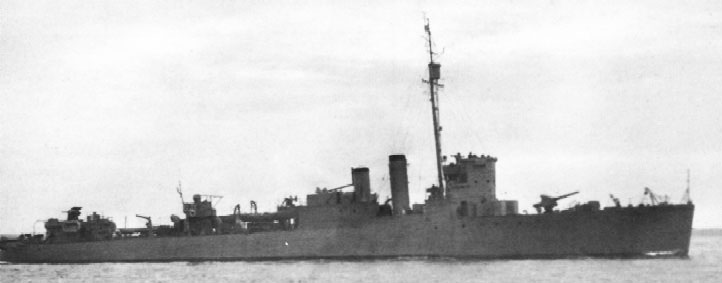
USS Twiggs commissioned Philadelphia 28 July 1919. DesDiv 1, Desron 4 Pacific Fleet 1919, San Diego, until spring 1922. Decom. San Diego 24 June. Recom. 20 February 1930, flagship of DesDiv 14. Charleston flagship DesDiv 7 1932-33. DesDiv 6, DesRon 2, Rotating Reserve DesRon 20 San Diego 1934, DesDiv 4, DesRon 2. Decom. April 1937 San Diego, recom. 30 September 1939, flagship DesDiv 64, DesRon 32, Key West. Chased German liner SS Columbus. Neutrality patrols, training cruises Naval Reserve contingents.
Transfer to Britain at Halifax October 1940 as HMS Leamington G 19. Collided twice, convo escort until October 1943. Reserve at the Tyne. 16 June 1944 transfer to USSR as Zhguchy, returned 1950, performed in film Gift Horse (St Nazaire Raid) sold 26 July 1951 for BU.
 Babbitt (DD-128)
Babbitt (DD-128)
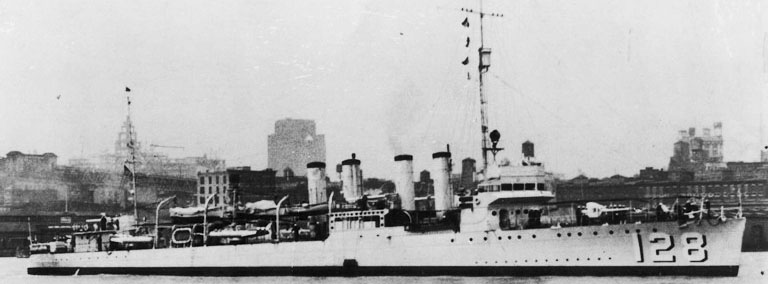
USS Babbitt commissioned 24 October 1919, Pacific Fleet, San Diego 1919-1922. Recom. 4 April 1930, Pacific Fleet. 1931, Atlantic fleet until May 1932 and until April 1933 Naval Torpedo Station Newport, cruise to Chile. Rotating Reserve DesRon 19 Norfolk, reduced commission until January 1935. Rotating Reserve, full commission 15 May 1935, Midshipmen’s Coastal Cruise Detachment. Special Service Squadron. April 1939 New York World’s Fair. DesRon 27 Patrol Force, Neutrality Patrol 1940-41. Convoy escort until 21 March 1944.
 DeLong (DD-129)
DeLong (DD-129)
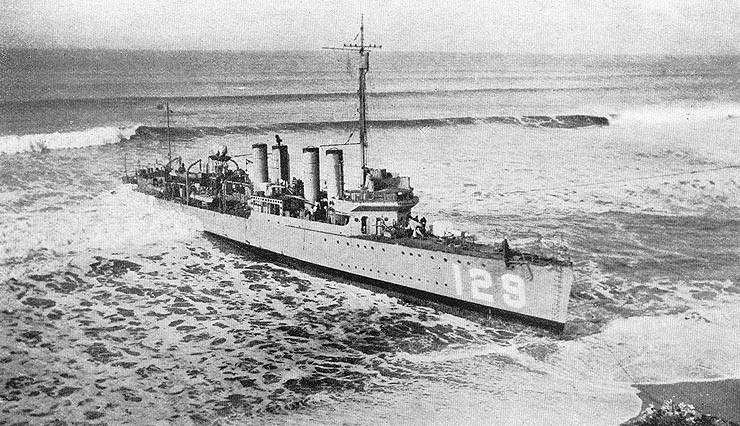
DeLong, named for Lieutenant Commander George W. DeLong (1844–1881), an Arctic explorer, was launched 29 October 1918 by New York Shipbuilding Corporation, Camden, New Jersey; sponsored by Miss E. DeL. Mills, granddaughter of Lt. Cmdr. DeLong; and commissioned 20 September 1919. DeLong sailed from New York 3 November 1919, and after joining in exercises at Guantanamo Bay, and patrolling off Honduras arrived at San Diego 24 December. She sailed in maneuvers and torpedo practice off Coronado Roads until placed in reserve 20 June 1920. After extended overhaul at Mare Island Navy Yard, she returned to San Diego 26 June 1921 and began operating from that port 21 October with 50 percent of her complement. On 1 December 1921 she went aground in a heavy fog at Half Moon Bay. A tug and two destroyers, Badger (DD-126) and Ballard (DD-267), stood by to assist. On 17 December she was salvaged and towed to Mare Island Navy Yard. DeLong was decommissioned 18 March 1922 and her hulk sold 25 September 1922.
 Jacob Jones (DD-130)
Jacob Jones (DD-130)

USS Jacob Jones commissioned 20 October 1919, decom. 24 June 1922, recom. 1 May 1930, Neutrality Patrols in 1940 and training midshipmen until March 1941 and watch over Lesser Antilles. September 1941 DesDiv 54 escort duty North Atlantic. On the morning of 27 February 1942, while along New Jersey coast ordered off Cape May, Delaware Capes. At 15:30 spotted burning wreckage tanker R. P. Resor. At dawn, 28 February 1942 torpedoed by U-578 port side. Only 12 survivors.
 Buchanan (DD-131)
Buchanan (DD-131)
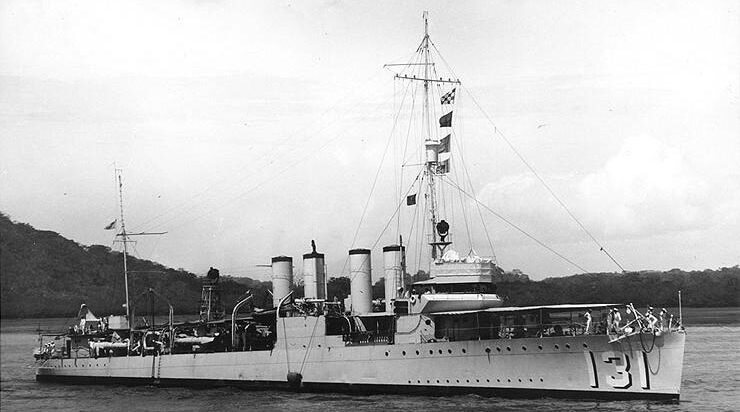
USS Buchanan commissioned 20 January 1919. Cuba, DesRon 2, Pacific Fleet July 1919, DesFlot 4. Decom 10 April 1930 San Diego. DesDiv 10 West Coast (Capt. Theodore E. Chandler), ROTC training and Rotating Reserve DesRon 20 San Diego. DesDiv 5, decom. San Diego 9 April 1937-30 September 1939. DesDiv 65 DesRon 32 Atlantic Squadron. December 1939-22 February 1940 Neutrality Patrol, Antilles Detachment. Gulf of Mexico from Galveston and Key West. Decom. Halifax 9 September 1940 transferred RN as HMS Campbeltown (I42). Spent in the Saint-Nazaire Raid. The dock was unusable before repairs 1948.
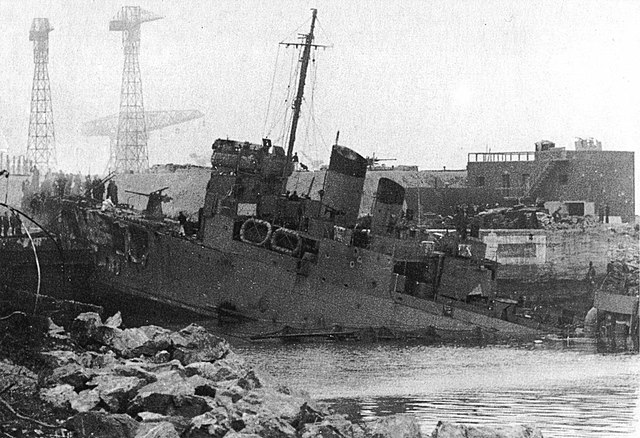
German personnel on-board Campbeltown on the morning after the raid, before the ship exploded
 Aaron Ward (DD-132)
Aaron Ward (DD-132)
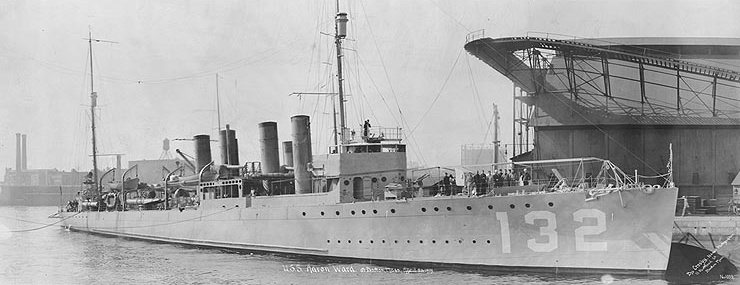
USS Aaron Ward was commissioned on 21 April 1919 (Lt. Cdr Raymond A. Spruance in command). DesDiv 13, DesRon 2 Atlantic Fleet. Picket transatlantic flight Curtiss NC. Pacific, Angeles Bay, Battle Fleet. Panama Canal Zone. 17 June 1922 recom. Reserve Fleet San Diego.
Recom. 24 May 1930. Rotating Reserve 1932-1934, Decom. 1937. Recom. 30 September 1939, flagship DesDiv 65 Pacific Fleet. Atlantic Fleet, Key West, neutrality patrols Gulf Mexico, West Indies.Sept. 1940 transferred RN as HMS Castleton. October 1944 Air Target ship. Paid off March 1945, sold January 1948.
 Hale (DD-133)
Hale (DD-133)
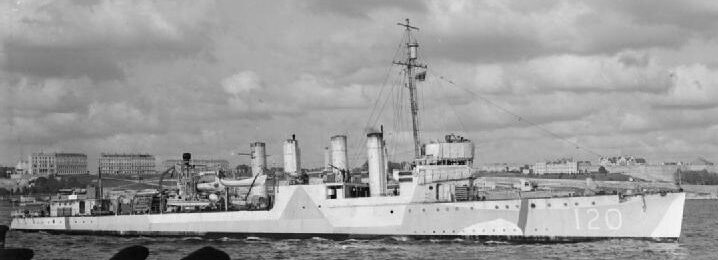
USS Hale commissioned at Boston 12 June 1919. DesRon 3 Atlantic Fleet, European cruise. Goodwill visits Mediterranean, Turkish waters. Decom. Philadelphia 22 June 1922. Recom. May 1930, East Coast. Decom. San Diego 9 April 1937, recom. 30 September 1939, Neutrality Patrol Caribbean, Galveston 1940, Key West. September 1940 transfer to Great Britain Halifax, HMS Caldwell (I20). RCN from mid-1942 seriously damaged, heavy gale. Reserve Tyne, BU September 1944.
 Crowninshield (DD-134)
Crowninshield (DD-134)

USS Crowninshield commissioned 6 August 1919, Atlantic Fleet. From 14 November 1921, half complement, decom. Philadelphia 7 July 1922. Recom. 12 May 1930 San Diego. 1934 Rotating Reserve. 2 November 1935 Presidential Fleet Review, San Francisco–Oakland Bay Bridge November 1936. Decom. San Diego 8 April 1937. Recom. 30 September 1939. Cuba Neutrality Patrol. 9 September 1940 decom. Halifax, transferred as HMS Chelsea. Served with RN, RCN and ended as Soviet Derzky 1944-1945. Returned 1949 and scrapped.
 Tillman (DD-135)
Tillman (DD-135)
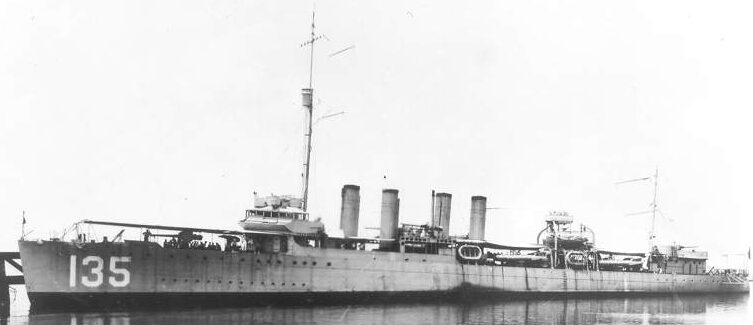
USS Tillman commissioned 10 April 1921. Charleston DesDiv 20, Desron 9, Atlantic Fleet 1921, DesDiv 33, Desron 8 1922. Decom. 3 July 1922 Philadelphia. Recom May 1930 Charleston DesDiv 23, DesRon 7, DesDiv 48 January 1931, trained NROTC midshipmen. 1933 Boston reservists/NROTC midshipmen. Rotating reserv until 1934. DesDiv 29, DesRon 10, decom. 15 June 1939.
Recom. Philadelphia 24 August 1940, Halifax transferred Royal Navy as HMS Wells (I 95) 5 December 1940. Target ship for aircraft training 1945. Decom. July 1945, scrapped.
 Boggs (DD-136)
Boggs (DD-136)
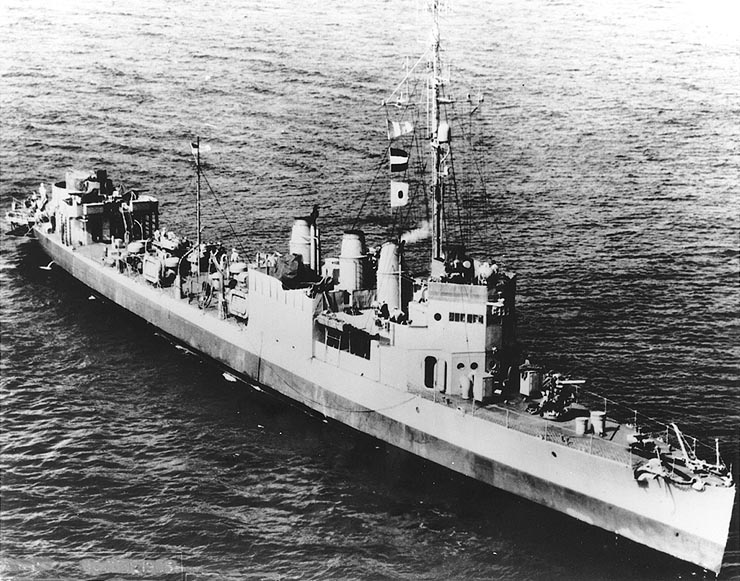
USS Boggs was commissioned on 23 September 1918. San Diego March 1919, cruise East Coast, North Atlantic, Caribbean, then Pacific Fleet, decom. 29 June 1922. AG-19 5 September 1931, recom. 19 December 1931, Mobile Target Division 1 until 1940. Pearl Harbor September, DMS-3. Pearl Harbor until January 1943, supplies to Canton Island, Phoenix Islands. Operational Training Command off San Diego 12 April 1944-March 1945. Overhaul San Pedro March-June 1945, AG-19, Eniwetok 15 August 1945, until 6 October, back USA 1946, decom. 20 March 1946, sold 27 November.
 Kilty (DD-137)
Kilty (DD-137)
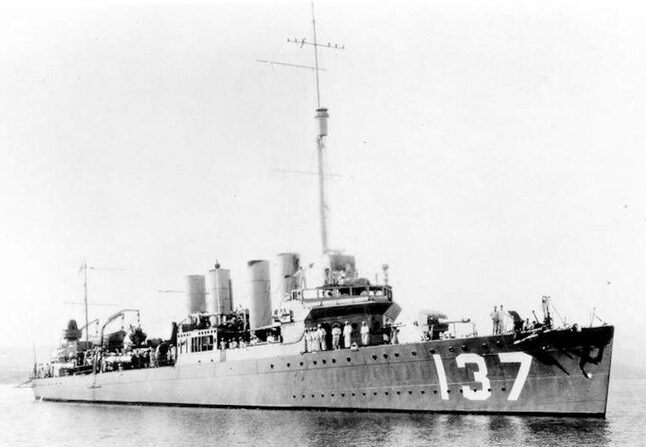
USS Kitly commissioned 17 December 1918. European cruise summer 1919, San Diego until decom. 5 June 1922. Recom. 18 December 1939, April 1940 Neutrality Patrol San Diego. Reserve training cruises. 1941-42 ASW patrols. Converted APD-15 January 1943, Mare Island, South Pacific, Noumea April, Guadalcanal as ASW screen, Solomons operations. Landed 37th Division New Georgia Island, reinforcement runs up the “Slot”, landings Vella Lavella. Treasury Islands Campaign (New Zealand troops, Stirling Islan, Bougainville). Brisbane, Milne Bay, Bismarck Archipelago 7th Marine Regiment Cape Gloucester. Saidor 2 January 1944, Green Island, Port Purvis (Florida Island), Emirau Island, Hollandia campaign. Aitape, New Guinea: Wakde, Biak 10, Humboldt Bay. Cape Sansopor, Sydney. Morotai, Leyte assault, rangers on Dinagat. Shot down two Vals. Philippines, Mindoro, Luzon, Nasugbu, Corregidor.
Okinawa Campaign. San Diego overhaul, DD-137 20 July 1945, decom. 2 November 1945, sold 26 August 1946. 10 battle stars.
 Kennison (DD-138)
Kennison (DD-138)
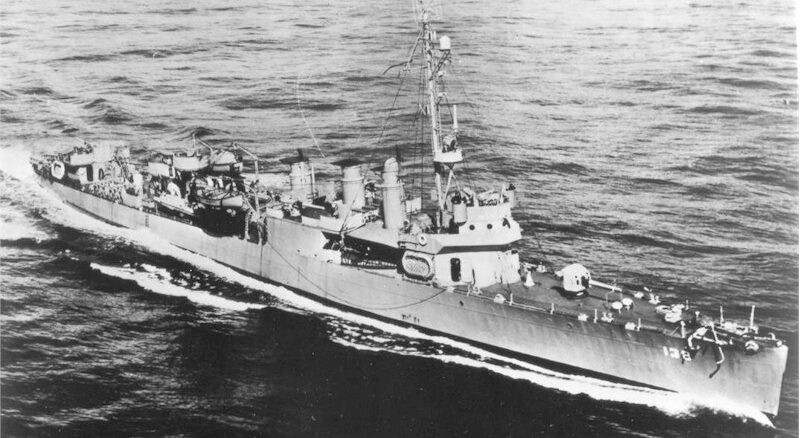
USS Kenniston was commissioned on 2 April 1919. San Diego 25 March 1920, exercises, coastal operations, decom. San Diego 22 June 1922. Recom. 18 December 1939, Neutrality Patrol May 1940 to September, reserve training cruises, patrols West Coast 1941-1942, ASW operations until 22 September 1944. Converted Bremerton Washington as AG-83, San Diego 9 November 1944, target ship for plane exercises. Decom. 21 November 1945 Portsmouth, sold 18 November 1946 for BU.
 Ward (DD-139)
Ward (DD-139)
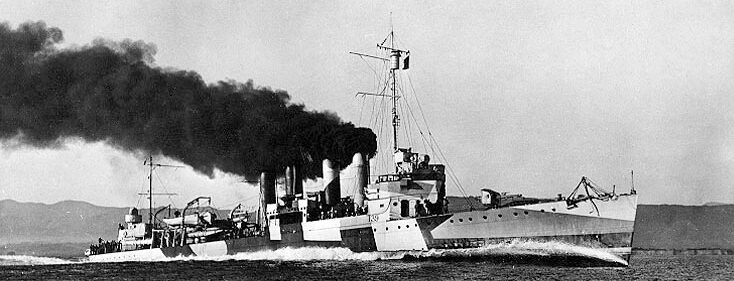
USS Ward Atlantic 1919, watch ship for trans-Atlantic flight Curtiss NCs May 1919. Pacific fleet under decom. July 1921. Recommissioned January 1941, Pearl Harbor. 7 Dec. attacked signalled sub. Ko-hyoteki-class. APD-16 February 1943, escort/transport, Cape Gloucester 1944, assisted landings Saidor, Nissan Island, Emirau, Aitape, Biak, Cape Sansapor, Morotai.
Badly damaged by kamikaze attack 7 December 1944, Ormoc Bay, Leyte, finished off gunfire.
 Claxton (DD-140)
Claxton (DD-140)
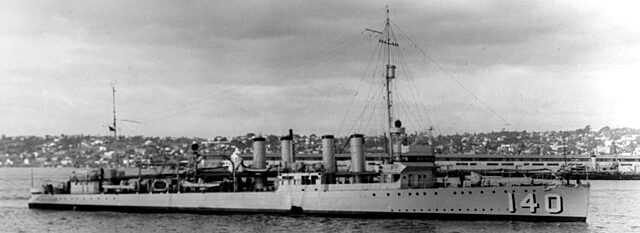
USS Claxton commissioned 13 September 1919. West coast until 18 June 1922, decom. San Diego, Re-com. 22 January 1930, west coast/reserve training until September 1933. Special Service Squadron off Cuba. Rotating reserve, Charleston, Cuban patrols until October 1935. Naval Academy cruises 1936-1937. Squadron 40-T civil war Spain until Nov. 1938. January 1939 Naval Academy, Neutrality Patrols Florida Straits. 1940 New England coast. Nova Scotia 21 November 1940 transferred Royal Navy as HMS Salisbury. Nova Scotia paid off 10 December 1943, sold for scrap 26 June 1944.
 Hamilton (DD-141)
Hamilton (DD-141)
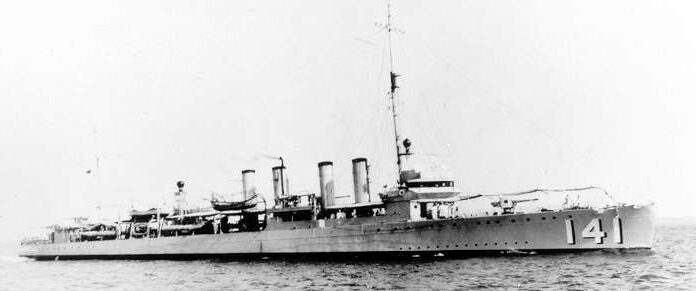
USS Hamilton was commissioned on 7 November 1919. Desron 17, detached to Hawaii. Decom. 20 July 1922. Recom. 20 January 1930 Norfolk Scouting Force East Coast, San Diego in 1932. East Coast 1933. 1939 Grand Banks Patrol (Iceland-Greenland) neutrality patrols. Conv. Fast minesweeper June 1941 DMS-18 East Coast, North Atlantic. Patrolled Panama Canal Zone. Operation Torch November 1942 TF 34, ASW patrols and covered landings Algiers. Minesweeping/escort, refit Brooklyn NyD. 1943 coastal convoy duty from Iceland to the Caribbean.
San Diego, Pearl Harbor, Kwajalein, covered Marines 31 January 1944. Admiralty Islands, Seeadler Harbor. Aitape, sweeping operations, Solomons, Mariana campaign, Saipan, Guam, refit Pearl Harbor.
Peleliu, Philippine Islands (Diriagat Island, Looc Bay). Battle of Leyte Gulf. Lingayen Gulf. Saipan. Iwo Jima. Refit Pearl Harbor, San Francisco (100,000 miles). Drydocked Richmond AG-111 (miscellaneous auxiliary) 6 May 1945. Decom. San Diego 16 October 1945. Sold 21 November 1946. Nine battle stars.
 Tarbell (DD-142)
Tarbell (DD-142)
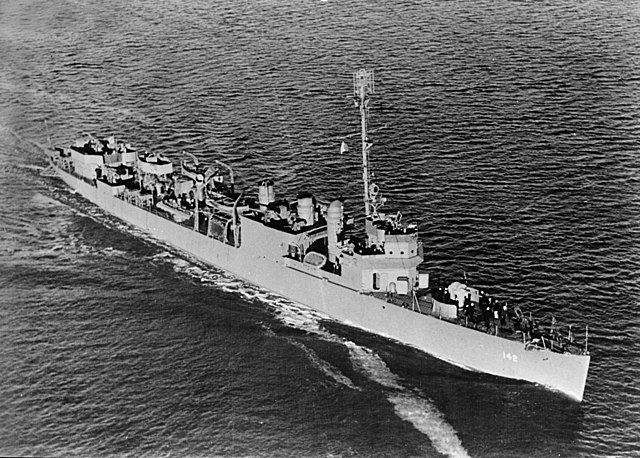
USS Tarbell was commissioned on 27 November 1918. Eastern seaboard until Sept. 1919, Pacific Fleet, San Francisco, DesDiv 15, DesFlot 5, DesRon 4 until Jan. 1920, DesDiv 13 Cavite Philippines, Asiatic Fleet until mid-1921. Decom. 8 June 1922 San Diego, 29 May 1930 recom. DesDiv 11, Desron 10 San Diego, Charleston, DesDiv 3. Decom. late 1936 Philadelphia.
Oct. 1939 recom. Neutrality Patrol. From Dec. 1941 convoy missions Atlantic. Decom. 20 July 1945 Philadelphia. Stricken 13 August 1945, sold 30 November.
 Yarnall (DD-143)
Yarnall (DD-143)
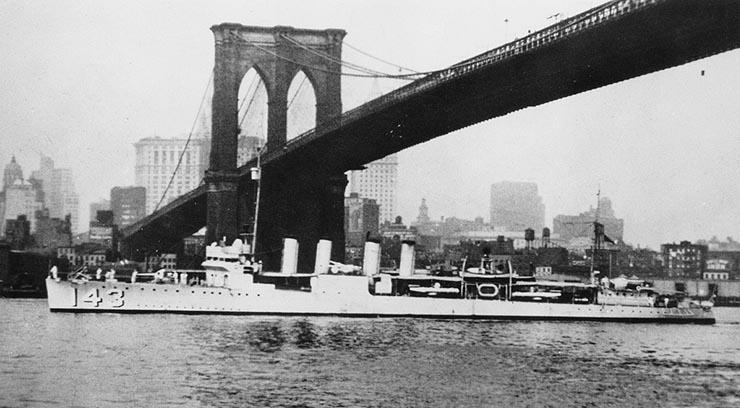
Commissioned on 29 November 1918 (Commander William F. Halsey, Jr. as first captain), Desdiv 15 France 1919. Flotilla 5, Desron 4 Pacific Fleet, San Diego. Asiatic station. Overhaul Puget Sound 1921, DesDiv 11, decom. 29 May 1922, reserve.
Recom. 19 April 1930, Desdiv 11, Sqn 10 west coast, east coast. December 1936, decom. reserve. Recom. October 1939 DesRon 11 Atlantic Neutrality Patrols. 1940 Transfer to the Royal Navy HMS Lincoln (G 42). Royal Norwegian Navy July 1942-1943. Tyne Reserve 1944. Soviet Druzhny 1944-1952, returned, scrapped.
 Upshur (DD-144)
Upshur (DD-144)
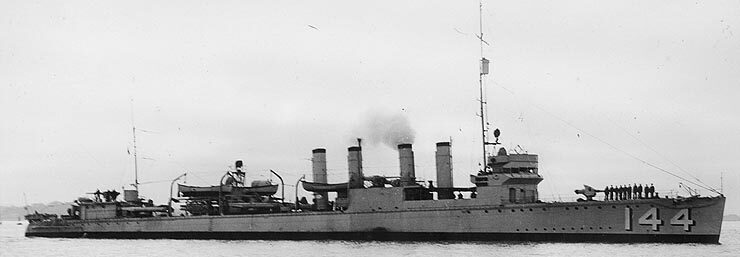
USS Upshur was commissioned at Philadelphia on 23 December 1918. On 20 May 1919 she went for the Azores and Devonport, Harwich, Heligoland, Danzig and back to NyC. Assigned to Pacific Fleet, San Diego. April 1920 Pearl Harbor, Midway, and Guam, Cavite 20 May. Yangtze River Patrol. 23 June landing party to protect American mission. Philippine Islands winter, Chefoo summer with Asiatic ended 1922, decommissioned San Diego 15 May 1922, reserve. Recom. 2 June 1930 Scouting Force west/east coast, decom. 22 December 1936 Philadelphia, berthed until 1939.
Neutrality Patrol September. Tracked North German Lloyd Line steamship Columbus off Mexico.
With Desron 30 until late 1940, wathing over French West Indies. Carried Ambassador William D. Leahy to Vichy France. March 1941 Support Force Narragansett Bay, NAS Argentia, Reykjavík Iceland occupation. Escorted convoy HX 150 and 14 more. December 1941-February 1942, more convoys, two attacks. Escorts Mediterranean, North Atlantic, Caribbean, plane guard 1944. AG-103 3 June 1945 until 15 August. Decommissioned Norfolk 2 November 1945, sold 26 September 1947.
 Greer (DD-145)
Greer (DD-145)
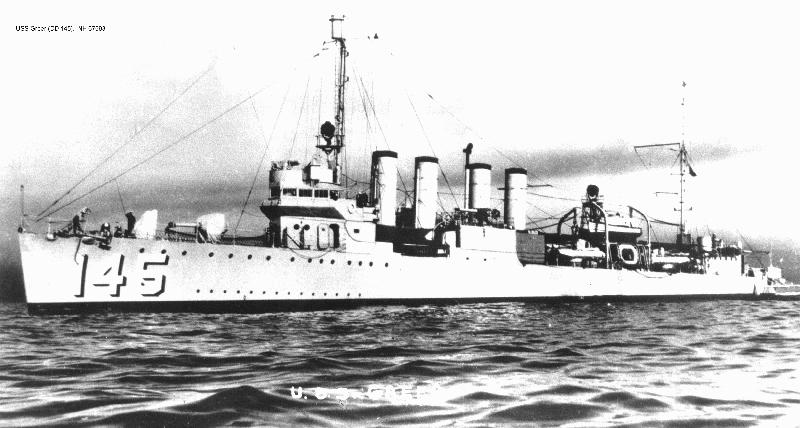
USS Greer was commissioned 31 December 1918. Azores, escort SS George Washington. Trepassey Bay, Newfoundland, transatlantic flight. Pacific Fleet, San Francisco 18 November 1919 to 25 March 1920, Asiatic Fleet, Shanghai, Port Arthur-Dairen, Cavite. Decom. San Francisco 22 June 1922, recom. 31 March 1930, west coast from Alaska to Panama. Rotating Reserve 1933-1934, Naval Reserve cruises to 1937. Recom. 4 October 1939, DesDiv 61 as flagship. East Coast-Caribbean Neutrality Patrol 1940, Reykjavík, Iceland, Argentia, Newfoundland. Greer incident, September 1941: U-652 fired on Greer, dipl. Indident. declared “an act of piracy” by President Roosevelt, “shoot-on-sight” order. North Atlantic escort 1941 to mid-ocean meeting point. March 1942 Caribbean. Stood guard off Guadeloupe (Vichy French fleet). Atlantic convoy duty from Argentia March 1943, Convoy SC 121. Other convoy to Casablanca. Northern Ireland, British West Indies, North Africa. 15 October collided with Moonstone Delaware Capes. Convoys ON 24, SC 48, ON 37, HX 165, ON 51, HX 170, SC 121, ON 175, Auxiliary service American waters. Plane guard. Decom. Philadelphia 19 July 1945, stricken 13 August, sold 30 November.
 Elliot (DD-146)
Elliot (DD-146)
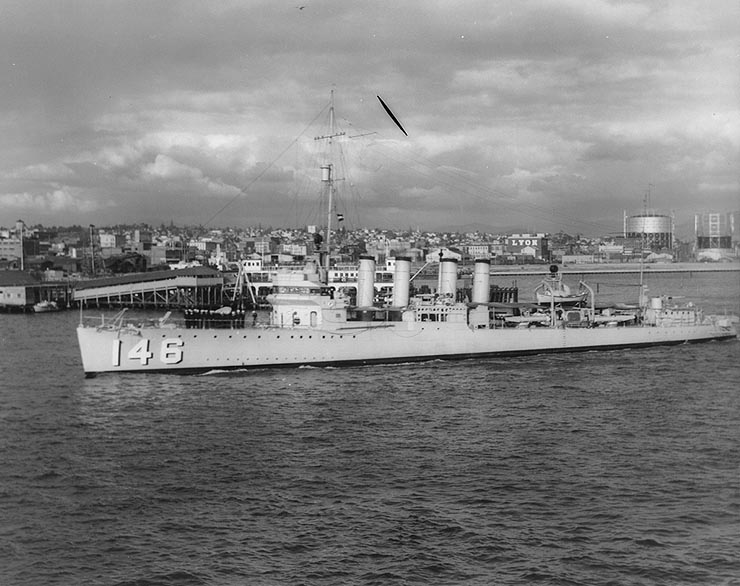
USS Elliot was commissioned on 25 January 1919. 28 April 1919 Azores, Gibraltar, Malta, Split, Philadelphia. Pacific Fleet DesDiv 13 after escort SS George Washington. March 1920 Far East with Admiral Albert Cleaves CiC Asiatic Fleet to Yangtze. Port Arthur, Dalian intel, Cavite. Overhaul, San Francisco late 1921, decom. 22 May 1922 to 8 February 1930. West coast DesDiv 11, plane guard. 1934 east coast fleet problem. 1935 high-speed towing vessel for fleet targets. 1937, training and XP services. 1940 Eclipse Expedition to Muleje, Baja California, Pearl Harbor, converted DMS-4 19 November 1940. MineDiv 6, TF 3 Johnston Island, ASW patrols. July 1942 Aleutians TG 8.6 Kiska. May 1943 minefield Attu. Operational Training Command San Francisco, San Diego towing targets until 13 August 1944. Pearl Harbor, same until 22 July 1945, San Pedro as AG-104 5 June 1945, decom. 12 October 1945, sold 29 January 1946.
 Roper (DD-147)
Roper (DD-147)

USS Roper was commissioned on 15 February 1919, New England coast, Ponta Delgada, Gibraltar, Malta, Bosporus, Black Sea area, back NyC. PacFleet via Panama, San Diego. West Coast until July 1921, Asiatic Station, Cavite, Chinese waters (Hong Kong-Chefoo). San Francisco 13 October, decom. San Pedro 14 December 1922 until 18 March 1930, rotating reserve squadron for seven years. NoV 1939 moved to Norfolk and Key West, Florida, then New England Patrol, Neutrality Patrol. Cape Cod December 1941, Norfolk, NS Argentia February 1942, escort to Londonderry. 13/14 April 1942, made contact with surfaced U-boat off North Carolina, sunk U-85 with artillery fire, first U-Boat kill of the USN. Convoys escorted ON 63, AT 18. Auxiliary service as APD-20 October 1943, Chesapeake Bay, Florida coast. 1944 8th Fleet Oran, Transport Division 13, offensive in Italy, Pianosa then southern France, “Sitka” Force, Levant Island. Italy, Naples-Oran, then Hampton Roads, Norfolk. January 1945 Pacific Fleet, Mariana Islands, Okinawa May 1945, Nakagusuku Wan. 25 May hit by a kamikaze. Repaired San Pedro. Decom. 15 September 1945, stricken 11 October, sold 1946. 4 battle stars, 2 citations, sold Wickes seeing service on three theaters.
 Breckinridge (DD-148)
Breckinridge (DD-148)
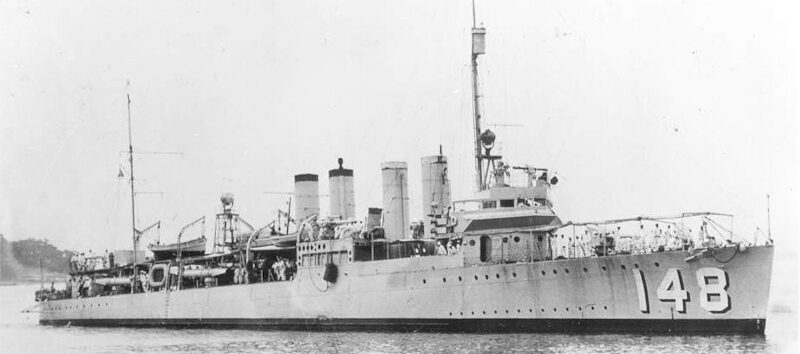
USS Breckinridge commissioned 27 February 1919, Atlantic Fleet, Cuba, development and tests, decom. Philadelphia 30 June 1922 to May 1930, Scouting Force, east coast until 1932. Pacific Scouting Force Alaska-Pearl Harbor. 1936 Training Squadron 10, decom. September 1936 to September 1939, DesDiv 66, Atlantic Squadron, Neutrality Patrol. December 1940 Inshore Patrol Station Panama Canal Zone. May 1941 Key West. December 1943 Atlantic Fleet TG 21.13 hunter-killer group January 1944, mid-Atlantic ASW patrols. Boston overhaul, March 1944 Norfolk, TF 6 escort to Mediterranean. May 1944 Caribbean Sea Frontier. Overhaul Boston, New London, flagship DesDiv 54. 30 June 1945 auxiliary AG-112, Pacific San Diego 21 August, CarDiv 12, as plane guard/escort, decom. 30 November 1945, sold 31 October 1946. One battle star.
 Barney (DD-149)
Barney (DD-149)

USS Barney commissioned 14 March 1919. DesDiv 19, Atlantic Fleet. Decom 30 June 1922 Philadelphia to 1 May 1930. Scouting Force east coast -Caribbean. Fleet problem San Francisco. Reduced commission, Rotating Destroyer Squadron 20 Pacific. 1935 DesDiv 3 cruised to Alaska, Honolulu, Puget Sound. East coast 10th Training Squadron. Nov. 1936 decom and recom. 4 October 1939, 66th Division Atlantic, Inshore Patrol 18th Naval District. December 1941 to November 1943 Caribbean area escort force. 18 September 1942 collied with USS Greer. Repaired Charleston. 14 January–May 1944, two convoy escort to North Africa. May 1944-February 1945, Caribbean. March 1945 assigned TE 25, TS submarines Long Island, Block Island. 30 June 1945 AG-113. Decom. 30 November 1945, sold 13 October 1946.
 Blakeley (DD-150)
Blakeley (DD-150)
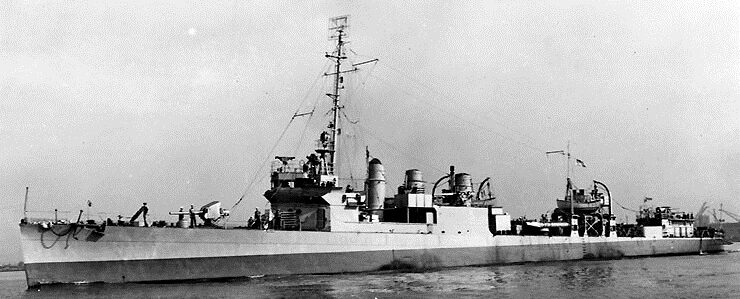
USS Blakeley commissioned 8 May 1919. Atlantic Fleet, East Coast until decom. 29 June 1922 Philadelphia, recom. 1932 to 1937, Scouting Fleet, Philadelphia. Recom. 16 October 1939, Neutrality Patrol until. From 1942 escort missions Caribbean Sea. 25 May 1942, while off Martinique (French West Indies), inspecting incoming Vichy French ships with USS Ellis she detected by sonar at 08:30 a.m. something but no alarm. She was soon after torpedoed by U-156 (Werner Hartenstein), holed 60 feet (18 m) forward bow-forecastle. Limped to Fort-de-France (6 died, 21 wounded). U-156 asked thje premission to finish her off to Lorient HQ, which was denied. She was escorted soon by USS Breckinridge, Greer, Tarbell and two PBY Catalina from VP-53. Fitted with wooden bulkhead, reached San Juan, more mods, then Philadelphia, repairs. Was fitted the forecastle of discarded USS Taylor, and updated, until September 1942.
Resumed convoy escort duty Caribbean until June 1945. Made a February 1943 deployment with hunter-killer TG 21.13 North Atlantic, and March-May 1943 to Bizerte. Summer 1945 New London TS submariners Long Island. Decom. Philadelphia 21 July 1945, sold 30 November 1945.
 Biddle (DD-151)
Biddle (DD-151)
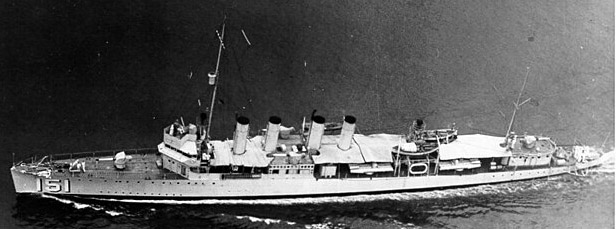
USS Biddle built at Cramp, commissioned 22 April 1919. Cruise Mediterranean. New York 1 July 1920, DesDiv 48 Atlantic, east coast. Decom. Philadelphia 20 June 1922 to 16 October 1939. Nautality Patrols DesDiv 66 Atlantic and TS Naval Reserve Officers. ASW patrols 15th Naval District until May 1941, HP Key West. From March 1942-February 1945 convoy duty Caribbean, part of TG 2 in early 1944. Escorted convoy to North Africa 24 March-11 May 1944. 11–12 April Luftwaffe attack, 7 men wounded. March–July 1945 TS with MTBs, reclassified AG-114 30 June, decom. Boston 5 October 1945, sold 3 December 1946.”
 Du Pont (DD-152)
Du Pont (DD-152)
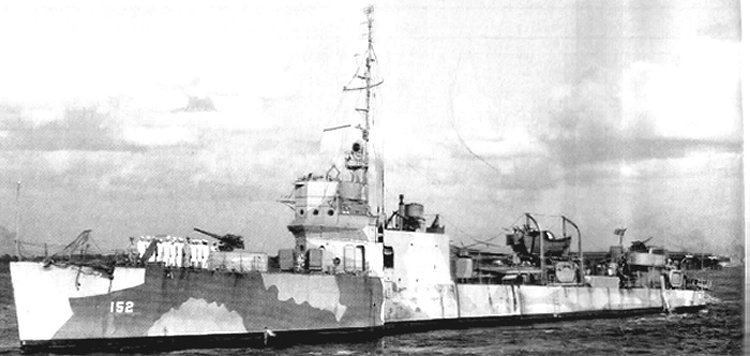
USS Dupont commissioned 30 April 1919. HP Newport May, picker ship Azores transatlantic airplane flight. Brest, France, New York June. Mediterranean cruise, Constantinople, relief in eastern Europe, Lebanon, Syria, Egypt, Greece. Reserved NYC July 1920, half complement. Decom. Philadelphia 19 April 1922 to 1 May 1930. Service east coast-Caribbean. 13-29 March 1931 escorted USS Arizona (Pdt H. C. Hoover) to South America. 9 January-22 October 1932 west coast service. Norfolk Rotating Reserve Squadron 19. TS Naval Reservists. 15 August 1934 full commission from Charleston, target vessel, plane guard Caribbean. San Diego 9 November, Alaskan, Pearl Harbor. Back east Coast Jacksonville, TS Naval Reserve. Decom. Philadelphia 14 January 1937.
Recom. 16 October 1939, Neutrality Patrol, 5 five convoys to NS Argentia, Iceland. Caribbean escort tanker convoys. May 1943 Mediterranean service, Algiers, Casablanca. 17 July-12 September 1943 convoy escort to UK. September USS Card hunter-killer group, then USS Bogue Casco Bay-Long Island. Helped sinking U-172, shared Presidential Unit Citation.
Norfolk September 1944, damaged Great Hurricane. Not fully repaired, reclassified auxiliary AG-80 Charleston, Key West, Fleet Air Wing 5. Served until 1 April 1946, decom. Boston 2 May 1946, sold for BU. Awarded 3 battle stars.
 Bernadou (DD-153)
Bernadou (DD-153)

USS Bernadou was Commissioned on 19 May 1919. DesDiv 19, Atlantic Fleet, east coast, decom Philadelphia 1 July 1922 t 1 May 1930, Desron 7, Scouting Force, September 1936-October 1939, then DesDiv 6, Atlantic Squadron’s Neutrality Patrol. Invasion of Iceland 1-7 July 1941, Newfoundland-Iceland convoy run until late 1942. October 1942 Norfolk, Operation Torch to North Africa 8–11 November, Presidential Unit Citation for landing at Safi, Morocco. Boston, November resumed east coast convoys until February 1943. Gibraltar, Oran, assisted Battle of Gela, occupation of Sicily 9–12 July, Salerno landings. 2 more convoys to North Africa, ans East Coast late 1944, then October 1944 – May 1945 plane guard/escort for carrier exercises. Decom. Philadelphia 17 July 1945, sold 30 November 1945. Awarded 5 battle stars.
 Ellis (DD-154)
Ellis (DD-154)

USS Ellis commissioned 7 June 1919, cruised to the Black Sea (US Food Administration officials), relief work and officers between Constantinople, Varna, Batum. Ex. east coast-Caribbean Sea, reduced reserve September 1920-16 March 1921 Charleston. Decom. Philadelphia 17 June 1922-1 May 1930. East coast Panama-Cuba, San Diego-San Francisco. Rotating reserve Norfolk-Boston 1932, 1933. Search for USS Akron, found off the New Jersey coast. New York for escorting Presidential yacht New England to New Brunswick, embarked President FD. Roosevelt and party to transfer USS Indianapolis. TS Naval Reserve. Key West, Cuba, escorted the president’s private yacht. Panama, San Diego TS Alaska-Hawaii. 7 June 1936 Miami, east coast reserve TS, decom. Philadelphia 16 December 1936 to 16 October 1939. Patrolled Charleston-Norfolk. Occupation of Iceland. NS Argentia for escorts to Iceland, mid-ocean point. From March 1943 transatlantic convoys, Ireland and North Africa.
Escorted HX 150, ON 22, HX 157, ON 35, HX 164, ON 49, HX 169, HX 170. Plane guard for carriers and cruised to Recife, Brazil 1944-45. Decom. Norfolk 31 October 1945, sold 20 June 1947. Earned 2 battle stars.
 Cole (DD-155)
Cole (DD-155)
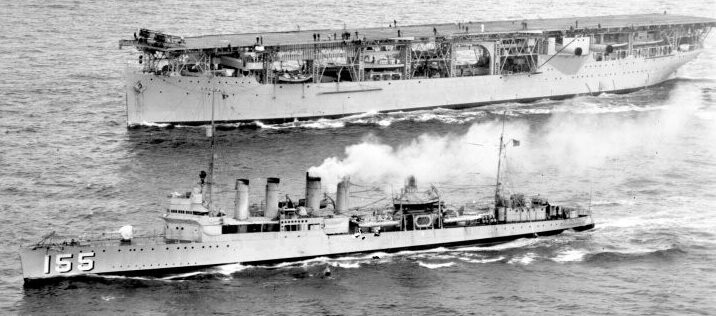
USS Cole commissioned 19 June 1919, New York, Turkish waters, evacuation of refugees (Greek-Turkish war), eastern Mediterranean, Black Sea. Back 4 June 1920. East Coast-Caribbean, decom. Philadelphia 10 July 1922 to 1 May 1930, Scouting Fleet Atlantic. 22 October 1932-24 March 1933 reduced commission Norfolk, rotating reserve. 4 April 1933 searched for USS Akron. August 1934 Scouting Force Pacific, San Diego 9 November – 24 May 1936. Back New York Naval Reserve TS, decom. Philadelphia 7 January 1937 to 16 October 1939. Neutrality Patrol Atlantic. 10 June 1941 escorts to Newfoundland-Iceland, 5 trips to 28 January 1942. 14 March-28 September east coast patrols. 24 October Operation Torch (8 November, landed 175 men, 47th Infantry at Safi Morocco), Presidential Unit Citation. More covoys until February 1943. Invasion of Sicily 10 July 1943, Landing on Salerno 9 September. December 1944 plane guard for aircraft carriers off Quonset Point until 31 August 1945 as AG-116, decom. November 1945, sold 6 October 1947. 3 battle stars.
 J. Fred Talbott (DD-156)
J. Fred Talbott (DD-156)
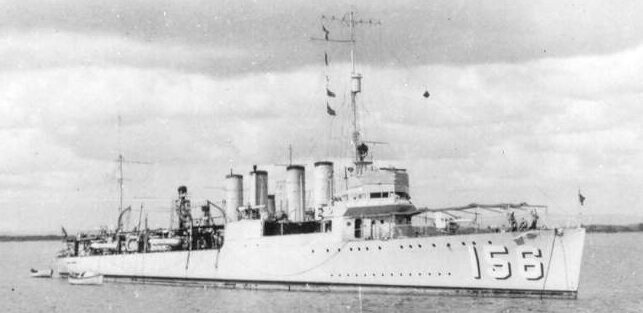
USS Talbott commissioned 30 June 1919. Newport, Med. Sea, station ship for US representation. Back home 21 June 1920, Neutrality Patrol East Coast, fleet exercises, decom. Philadelphia 18 January 1923 to 1 May 1930. Ten years Atlantic coast/Caribbean, ASW exercises and TS reserves & midshipmen. Patrolled Panama Canal 1939-40. Early 1942 escort duties New Orleans, Cuba, Panama Canal. Refit Boston January 1944, transatlantic convoys, Casablanca, Iceland, Caribbean. Converted New York AG-81 25 September 1944, Port Everglades as target ship for torpedo bombers. Decom. Boston 21 May 1946, stricken 19 June 1946, sold 22 December 1946.
 Dickerson (DD-157)
Dickerson (DD-157)
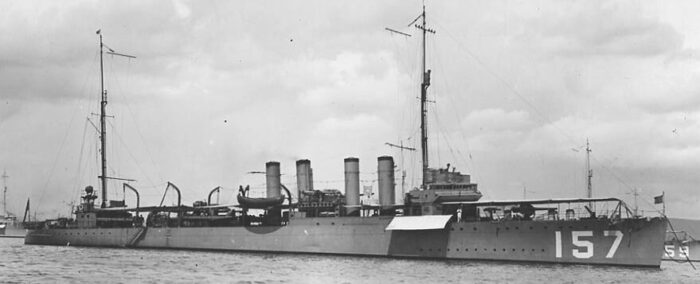
USS Dickerson commissioned 3 September 1919, decom. 26 June 1922 reserve New York Navy Yard, recom. 1 May 1930, Rotating Reserve, Neutrality Patrol Key West from 25 July 1940. Before that she was with DesRon 10, Atlantic in 1938,, plane guard for USS Yorktown off Norfolk. Squadron 40-T Lisbon Portugal 1939 and visited Spanish ports, refugees from Casablanca, special mission for the State Department. Norfolk July 1940. Neutrality Patrols HP Key West, New London with SubRon 2 October 1940. NS Argentia, to Iceland and back until January 1942. 19 March off Norfolk fired by an unidentified ship, badly damaged charthouse, 4 kills including CO Lt Cdr J. K. Reybold. Apparently nervous merchantman Liberator. Repaired Norfolk. Escort Norfolk-Key West, Key West-New York, New York-Cuba, then to Gibraltar-Algiers. USS Card hunter-killer group Casablanca, middle Atlantic. Reclassified APD-21 21 August 1943, converted, November 1943 Pacific. Escorted convoys Espiritu Santo-Guadalcanal. 30 January 1944, landed New Zealanders Green Island. Landed troops Emirau Island. April 1944 New Guinea area, landings Seleo Island, Aitape. Refit Pearl Harbor, Roi, Saipan, Guam. November 1944 Aitape, invasion Lingayen Gulf, Luzon (HP Ulithi), Iwo Jima February 1945, Keise Shima, Okinawa. 2 April 1945 hit by Kamikaze. Damage control measures failed, abandoned, sunk, 45 crew lost. Awarded 6 battle stars.
 Leary (DD-158)
Leary (DD-158)
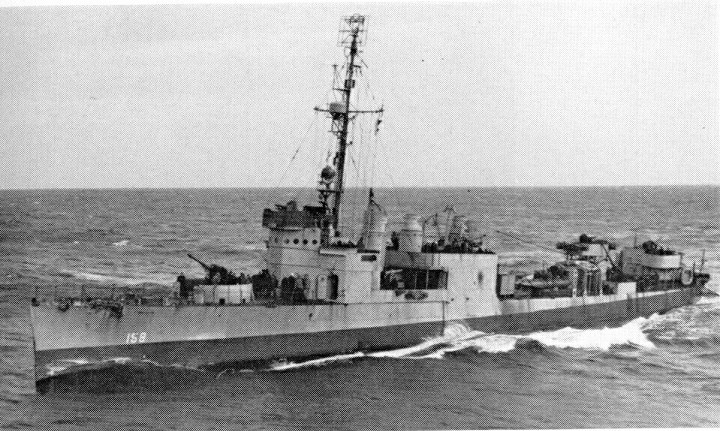
USS Leary Commissioned 1919, decom. 1922 to 1930. First U.S. Navy ship equipped with sonar and detect a German ship with it. Escorted convoys from 1941 to Iceland, Caribbean, west Africa, mod. ASW vessel. 24 December 1943, escorting USS Card rough seas North Atlantic (Hunter Killer group), torpedoed thrice by U-275, sank with 98 men.
 Schenck (DD-159)
Schenck (DD-159)
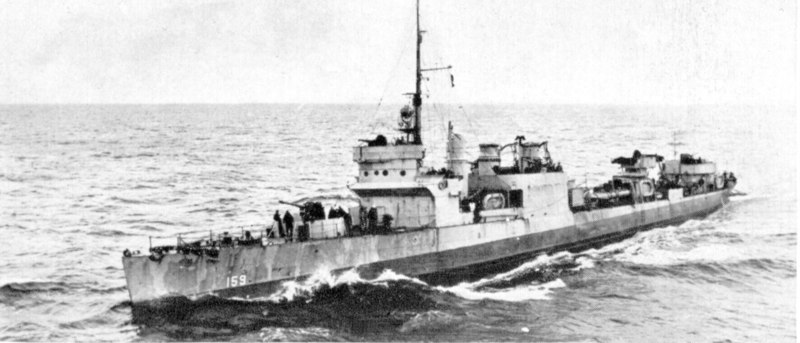
USS Schenk commissioned 30 October 1919, Atlantic Fleet, July-September 1920 east coast Mexico, 1921 fleet exercises Caribbean. Reduced crew Charleston November 1921, decom. Philadelphia 9 June 1922 to 1 May 1930. TS reservists, 1931-32 Fleet Problems. Pacific Fleet June 1932. Remained from April 1934, overhaul, rotating reserve Norfolk, TS reservists, Academy midshipmen. September 1939, Neutrality Patrol east coast, overhaul, HP Key West until July 1941. Sent NS Argentia for escorting convoys. 13 March 1943 gale, drag anchor, collide with SS Exterminator Iceland, repaired Boston.
North Atlantic convoys: HX 152, ON 26, ON 28, HX 160, ON 41, HX 167, ON 55, HX 174, SC 71, SC 73, SC 75, SC 77, ON 89, ON 90, SC 95, SC 97, SC 99, ON 136, SC 103, SC 107, SC 110, SC 112, ON 156, SC 114, SC 116, SC 118, HX 226, SC 120. October 1943 Hunter-killer group USS Card. November 1943-2 January 1944. 24 December 1943 sunk U-645. Brooklyn NyD stripped of armament, torpedo target ship for aircraft AG-82 September 1944 Quonset Point. decom. Boston 17 May 1946, stricken 5 June 1946, sold 25 November 1946.
 Herbert (DD-160)
Herbert (DD-160)
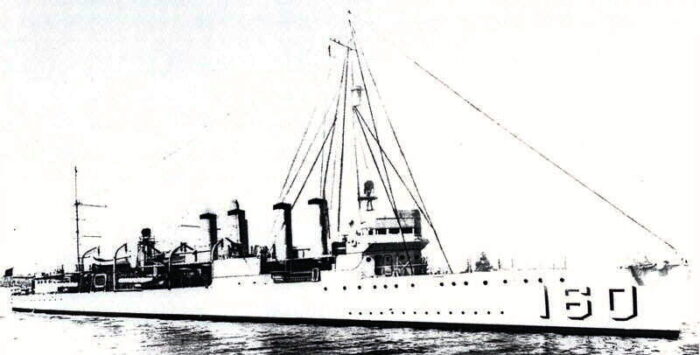
USS Herbert commissioned 21 November 1919, South Atlantic, Caribbean, Atlantic Fleet destroyer squadron. Decom. Philadelphia 27 June 1922 to 1 May 1930, Scouting Fleet HP Newport. January 1935 to August 1939 TS for Naval Reserves-midshipmen. Portugal 2 October 1939-July 1940. Overhaul October, New London sound school training. Convoy escort Key West-Halifax-Iceland. April-June 1943 Gibraltar, North Africa, invasion of Sicily. Hunter-killer patrols Bermuda-Casablanca. She escorted HX 165, ON 51, HX 172 and ON 65. Charleston November 1943 conv. as high-speed transport APD-22. Trasnferred Pacific, San Diego, New Guinea via Pearl Harbor March 1944. Landings Humboldt Bay 22 April, convoy escort duty, invasion Biak 27 May. Landings at Warsai, Cape Sansapor 30 July. 15 September Morotai. 17 October Leyte Gulf Rangers landed on Homonhon Island. January 1945, landed Lingayen Gulf. Iwo Jima, Leyte March 1945, invasion of Okinawa, 31 March. San Diego 19 June, decom. 25 September 1945, stricken 24 October 1945, sold 23 May 1946. Awarded 6 battle stars.
 Palmer (DD-161)
Palmer (DD-161)
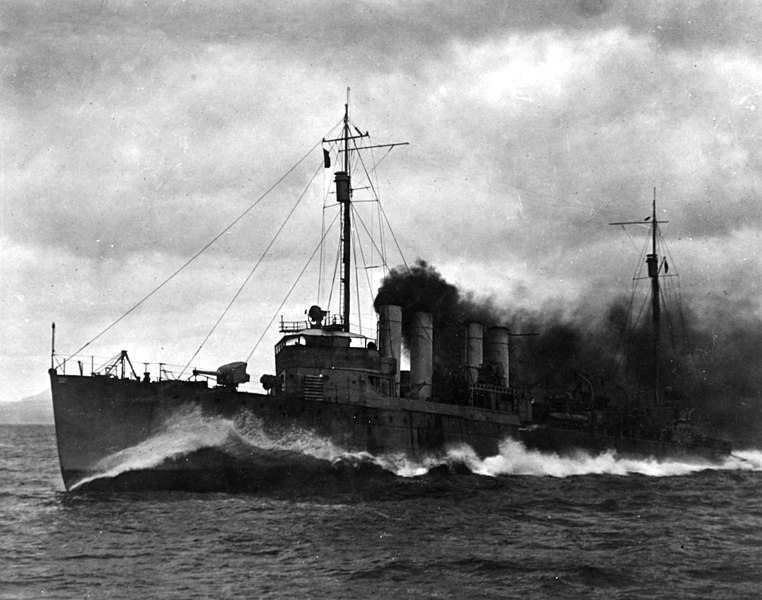
USS Palmer commissioned 22 November 1918, Pacific Fleet, decom. San Diego 31 May 1922 to 7 August 1940. Converted as fast minesweeper DMS–5 19 November, Atlantic MineDiv 19 HP Norfolk. 24 October 1942, screening TF 34 to North Africa, Operation Torch. 8 November captured French trawler Joseph Elise, engaged shore battery. Patrol/escort off North Africa until 12 December, Atlantic escort to 1943, transferred Pacific, San Diego, TF 53 Pearl Harbor, 22 January 1944 assault on Kwajalein. Marshalls until 12 February, escort voyages Pearl Harbor-Majuro. Saipan until 8 July, Guam 22 July. Pearl Harbor prepared Philippines invasion. HP Manus, Leyte Gulf 17 October; Surigao Strait, Lingayen Gulf 11 January 1945. Air attack, bombs, violent explosion repairs, then new bombs portside, sank in six minutes. 2 killed, 38 wounded, 26 missing. Awarded 5 battle stars.
 Thatcher (DD-162)
Thatcher (DD-162)

USS Thatcher commissioned 14 January 1919, Atlantic Fleet autumn 1919, picker ship transatlantic NC-boat flight May 1919. Routine training eastern seaboard, late 1921 reassigned Pacific Fleet, San Diego, decom. 7 June 1922 to 18 December 1939. west coast training, transferred Atlantic, neutrality patrols, Halifax, transferred 24 September 1940 to RCN as HMCS Niagara. 1944 TS at Halifax and Saint John for torpedomen. Decom. 15 September 1945, sold 27 May 1946.
 Walker (DD-163)
Walker (DD-163)
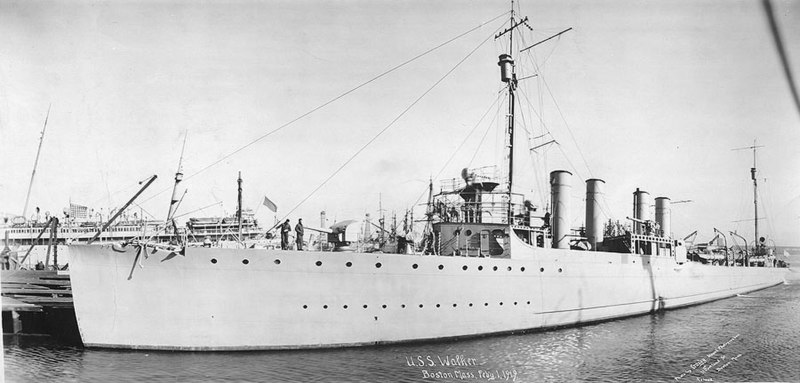
USS Walker commissioned Boston 31 January 1919. Escorted SS George Washington from France. DesDiv 18 HP Newport, West Indies, New York. Picket ship for transatlantic flight. HP Annapolis, TS Naval Academy, Panama 24 July, Acapulco, Coronado 8 August, HP San Diego, West Coast training, Reserve Destroyer Flotilla, TS reservists October 1920, rotating reserve, Decom. 7 June 1922 San Diego, stricken 28 March 1938. Converted as water barge YW-57 April 1939 Mare Island, then damage control hulk DCH-1 July 1940, HP San Diego, Pearl Harbor, IX-44 17 February 1941. While under tow 28 December 1941 by oiler USS Neches, cast adrift, scuttled by gunfire.
 Crosby (DD-164)
Crosby (DD-164)
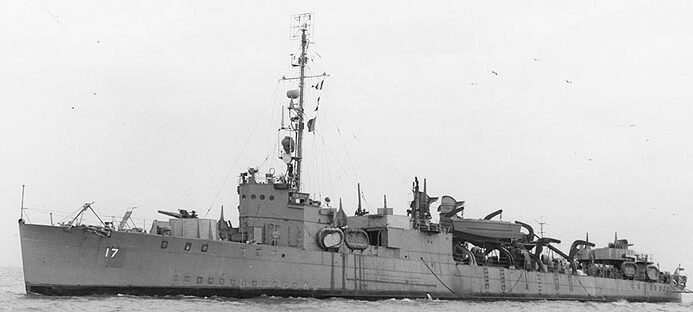
USS Crosby commissioned 24 January 1919, Atlantic Fleet. Sent Newfoundland May 1919 as plane guard transatlantic flight. July 1919 assigned Pacific Fleet, San Diego 7 August. Visited Portland and Seattle, reserve status reduced complement San Diego January 1920, decom. 7 June 1922 to 18 December 1939. Neutrality Patrol HP San Pedro April 1940. 3 April collided with fishing vessel Lone Eagle off Point Arguello. July assigned to the 11th Naval District, TS reserve. Alt. this and escort convoys until 1 February 1943. Converted Mare Island as high-speed transport APD-17 22 February 1943.
Pearl Harbor, Samoa, Viti Levu, Noumea, Espiritu Santo, 4th Marines. 29 April Guadalcanal, same in June, escort in the Solomons. Landings New Georgia, Treasury Islands, Bougainville. Overhaul Australia, New Guinea, TS, landing Cape Gloucester, Dekays Bay New Guinea January 1944. Landing Green Island February 1945, Emirau Island 20 March, Aitape 22-26 April, invasion of Biak 27 May, flagship for landing craft May-6 July. Overhaul Manus, landing Cape Sansapor. Refit Sydney. Landing Morotai. 6th Rangers Suluan Island, Leyte, Dinagat Island, Ormoc Bay, Mindoro, Lingayen Gulf, Luzon, Nasugbu, Mariveles, Corregidor. Refit Ulithi. ASW patrol Okinawa, radar picket. Back San Francisco June. Decom. 28 September 1945, sold 23 May 1946. Awarded 10 battle stars.
 Meredith (DD-165)
Meredith (DD-165)
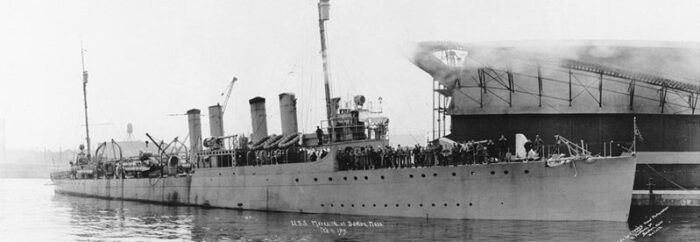
USS Meredith built Fore River, Quincy, commissioned Boston 29 January 1919. Destroyer Force Atlantic, HP Newport, escorted SS George Washington, New York, Newfoundland, picket ship for aerial transtlantic flight. Boston 22 May DesDiv 2 until November, TS Newport, refit Norfolk. Charleston January 1922 maneuvers. Decom. Philadelphia 28 June 1922. Stricken for limit tonnage (London Naval Treaty), sold 29 September 1936.
 Bush (DD-166)
Bush (DD-166)
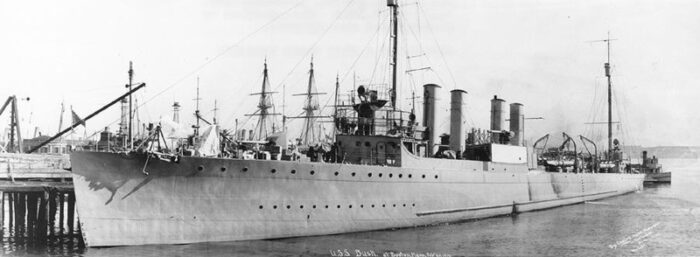
USS Bush built at Fore River Quincy, commissioned 19 February 1919; Operated East Coast DesRon 3 until 29 November 1919. HP Charleston, DesFlot 7, reduced commission. Reserve until summer 1920. TS Naval Reserves. Alt. Charleston winter base, Newport summer. Decom. 21 June 1922 Philadelphia, sold 8 September 1936.
 Cowell (DD-167)
Cowell (DD-167)
USS Cowell commissioned 17 March 1919, Boston, May 1919, Trepassey Bay (Newfoundland) for first aerial crossing Atlantic. 30 June from New York, American naval force Adriatic. Dispatch ship for Allied Peace Commission, station ship Rijeka, Split, Trogir. Back home October, reserve Boston-Charleston, TS HP Newport, until October 1921. Decom. 27 June 1922 Philadelphia, recom. 17 June 1940 Atlantic neutrality patrols East Coast until 18 September 1940, Halifax, transferred 23 September 1940 as HMS Brighton. 1943-1944 target ship for naval aircraft at Rosyth. 16 July 1944 transferred soviet navy as Zharky, returned RN, Rosyth 28 February 1949, sold 5 April 1949.
 Maddox (DD-168)
Maddox (DD-168)

USS Maddox built Fore River Massachusetts, commissioned 10 March 1919, DesDiv 21, Atlantic Fleet, Boston, Newfoundland, Azores, picket for first transatlantic flight. European TOD 26 August 1919. Brest, escorted SS George Washington. Ostend hosted Belgian King and Queen to the US. Detached 25 September cross-channel service, Dover/Harwich-Boulogne, Kiel Canal, Baltic ports. Back home 12 February 1920, HP Boston 2 years. Decomm. Philadelphia 14 June 1922 to 17 June 1940. Mid-Atlantic Neutrality Patrol. Halifax decom. 23 September, transferred as HMS Georgetown. December 1943 Reserve Fleet, trandferred August 1944 Soviet Navy as Doblestny or Zhyostky, returned 9 September 1952 and scrapped.
 Foote (DD-169)
Foote (DD-169)
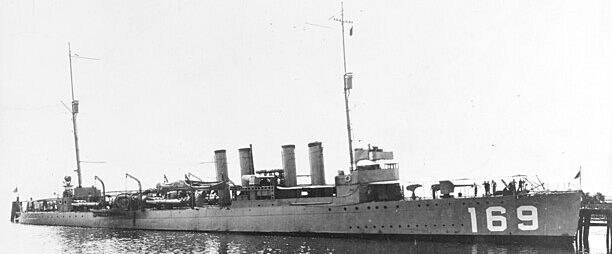
USS Foote comm. 21 March 1919, Boston May, picket ship transatlantic seaplane crossing. HP Newport August, TOD Naval Forces European Waters, Mediterranean. Boston February 1920, reserve Charleston.
Red. complement Charleston, Boston, decom. Philadelphia 6 July 1922 to 2 July 1940, HP Charleston, nautrality Patrols, Halifax, 23 September 1940, decom. transferred as HMS Roxborough. Damùaged storm. Tyne reserve 10 January 1944, transferred Soviet Navy 1 August 1944 as Zhyostky, used c.1944-1949, scrapped 14 May 1949.
 Kalk (DD-170)
Kalk (DD-170)
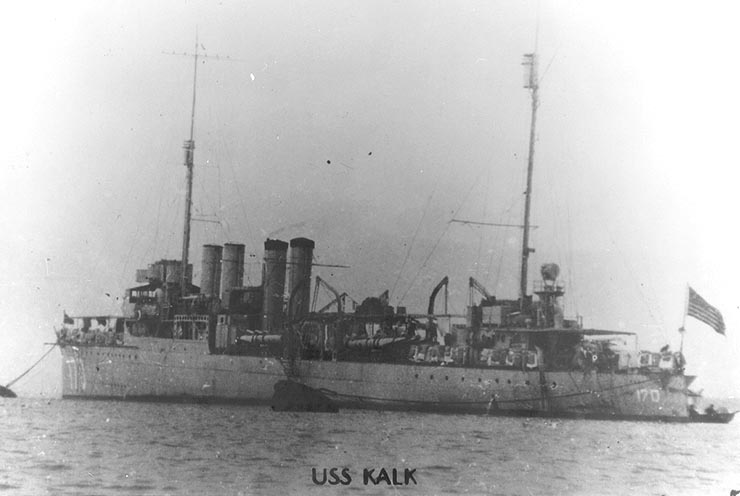
USS Kalk commissioned Boston, 29 March 1919. HP Newport, 3 May Newfoundland, mid-Atlantic rescue cover transatlantic seaplane crossing to the Azores. Boston, then Europe 10 July, Brest, England, Hamburg late July, Baltic Sea, American Relief Administration operations. Dispatch-escort Brest, back home 25 January 1920. TS 1st Naval District, DesRon 3. Decom. Philadelphia 10 July 1922 to 17 June 1940. Charleston, Neutrality Patrol, Halifax 18 September. Decom. trasnferred 23 September RN as HMS Hamilton. Collided with HMS Georgetown at St. John’s. Mod. RCN late June 1941 (HMCS Hamilton). Discarded 11 August 1943, tender HMCS Cornwallis. Surplus 1 April 1945, decom. 8 June Nova Scotia. Towed to Baltimore but lost underway, sunk.
 Burns (DD-171)
Burns (DD-171)
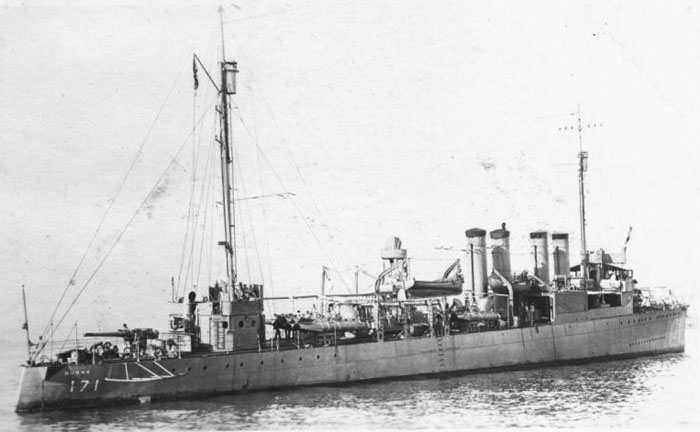
USS Burns built San Francisco, commissioned 7 August 1919. Destroyer Force, Pacific until March 1920, tender for NC Seaplane Division. 15 March 1921 reclassified DM-11, 5 May Mine Force, Pacific. Mare Island 11 July conversion and overhaul, NAS Pearl Harbor, MineRon 2 Pacific Fleet. 1925 tour of Australia and New Zealand. TS Naval Reservists. 1927 San Diego refit, Pearl Harbor until November 1929. Decom San Diego 2 June 1930. Towed 11 June to Mare Island, barracks ship, stricken, scrapped, sold 22 April 1932.
 Anthony (DD-172)
Anthony (DD-172)
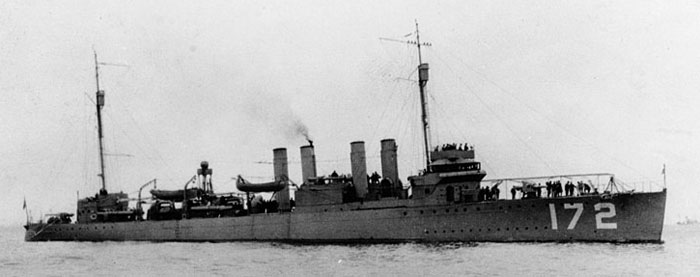
USS Anthony built San Francisco, commissioned 19 June 1919, Destroyer Division Pacific. San Diego-Bremerton June 1921. 8 September 1919 Port Angeles ceremonies new Pacific Fleet. Visited Victoria, carried Sec. Navy Josephus Daniels to Bremerton, Presidential review. 16 November 1920 light minelayer DM-12. October 1921 MineDiv 1, MineRon 2, Pearl Harbor. Decom. there 30 June 1922. Towed San Diego 1937, sunk as target 22 July 1937. Thus, she only had lass than four years of active service, one of the shortest-lived US destroyer.
 Sproston (DD-173)
Sproston (DD-173)
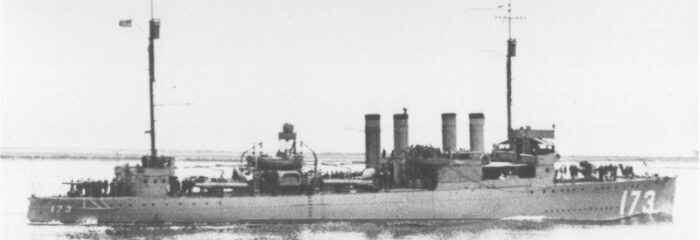
USS Sproston built San Francisco, commissioned 12 July 1919. Hawaii, PacFleet late 1919. Conv. Light Minelayer (DM-13) Pearl Harbor until 1922. 15 August, decom. reserve fleet. Stricken 1 December 1936, sunk astarget 20 July 1937.
 Rizal (DD-174)
Rizal (DD-174)
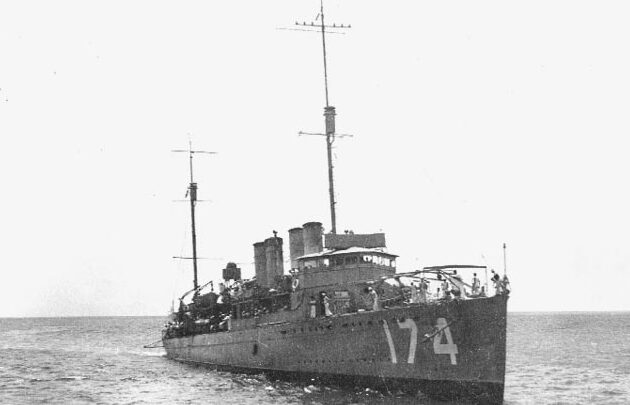
USS Rizal was donated to the USN by the Philippine Legislature (American-colonial Insular Government) built San Francisco, commissioned 28 May 1919. PacFleet. Conv. light minelayer DM-14 17 July 1920. San Diego, Far East, Honolulu, Midway, Guam, Cavite 1 May 1920, flagship Mine Detachment Division, Asiatic Fleet. Also visited Shanghai, Chefoo, Chinwangtao, Hong Kong, Guam, Yokohama. Decom. 20 August 1931 San Diego, Mare Island reserve. Stricken 11 November 1931, BU and sold 25 February 1932.
 Mackenzie (DD-175)
Mackenzie (DD-175)

USS MacKenzie built San Francisco, commissioned 25 July 1919. PacFleet operation DesRon 2 and 4, decom. Mare Island 27 May 1922, recom. San Diego 6 November 1939. Neutrality Patrols, Halifax, 20 September 1940, decom., transferred RCN 24 September as HMCS Annapolis. From April 1944 TS as HMCS Cornwallis. 4 June 1945 sold for BU.
 Renshaw (DD-176)
Renshaw (DD-176)

USS Renshaw was commissioned 31 July 1919, assigned Destroyer Force, PacFleet. Naval review Monterey Bay Secretary of the Navy. HP San Diego, Hawaii 25 March-28 April 1920, DesFlot 11, 16 December 1920-4 April 1921 overhaul Puget Sound. San Diego January 1922 moored reserve, decom. 27 May. Laid up, disposed of 1936 (London Naval Treaty) stricken 19 May 1936, sold 29 September 1936, BU.
 O’Bannon (DD-177)
O’Bannon (DD-177)

USS O’Bannon built San Francisco, commissioned 27 August 1919, San Diego, exercises, training Calif. and Hawaiian waters. Reserve commission until Nov. 1920, decom. San Diego 27 May 1922, stricken 19 May 1936, sold 29 September 1936 and BU.
 Hogan (DD-178)
Hogan (DD-178)
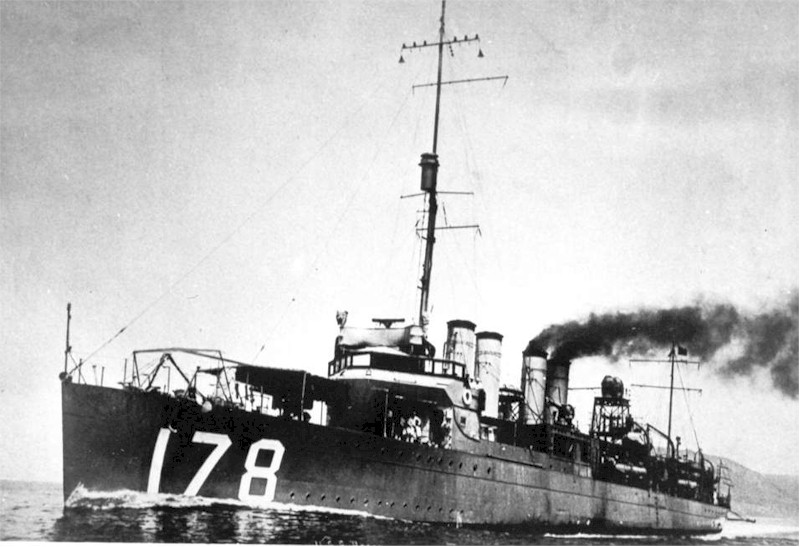
USS Hogan commissioned 1 October 1919, PacFleet, San Diego 23 November to 6 February 1920 fleet maneuvers and exercises off California coast. Hawaii, San Diego 1921. First US Navy ship refuelled at sea, oiler Cuyama. Decom. San Diego 27 May 1922 to 7 August 1940, conversion HS minesweeper Mare Island, DMS-6. Caribbean, Eastern Coast as convoy escort. Operation Torch 7 Nov. 1942, Center Force off Fedhala, fired on Vichy French steamer and escort. Coastal convoy duties until November 1943. Norfolk, Pacific Fleet, Mare Island December, invasion of the Marshalls, Kwajalein 16 January 1944. ASW Roi, Espiritu Santo, Milne Bay, Hollandia, invasion of Saipan, Guam. Overhaul San Francisco winter 1944. Leyte Gulf January 1945, Iwo Jima. San Diego AG-105 June 1945. Sunk as target 8 November 1945. Awarded 6 battle stars, sank 4 submarines, downed two planes.
 Howard (DD-179)
Howard (DD-179)

USS Howard commissioned 29 January 1920, Mare Island. Departed San Francisco, Pacific Destroyer force San Diego. Mexico in May, decom. 27 May 1922, recom. 29 August 1940, converted fast minesweeper as DMS-7. HP Norfolk 29 October, Caribbean, Neutrality patrols May 1941. 8 December escort duty. October 1942 Operation Torch, Western Naval Task Force with cruiser USS Augusta. Battle of Casablanca. 1943 ecorted convoys Atlantic-Caribbean up to Newfoundland-Iceland. San Diego 7 December. Pearl Harbor, Majuro, Eniweto, Saipan. Back Pearl Harbor 10 August 1944. Invasion of the Philippines, Leyte Gulf October 1944. Manus, battle for Leyte Gulf, invasion of Luzon, Lingayen Gulf January 1945. Ulithi 5 February, Tinian 13 February, Iwo Jima. Pearl Harbor April 1945. Reclassified AG-106 5 June, escorted submarines, plane guard; Decom. Philadelphia 30 November. Sold 1946. Earned six battle stars.
 Stansbury (DD-180)
Stansbury (DD-180)
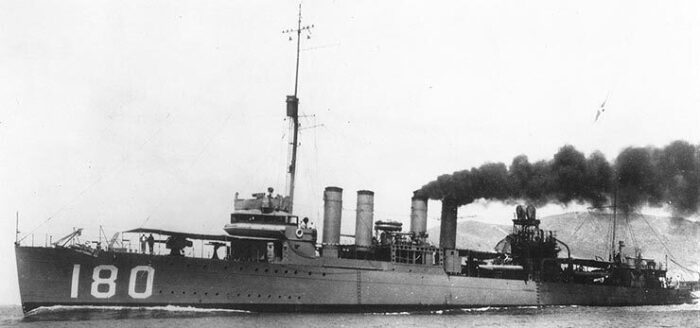
USS Stanbury commissioned Mare Island 8 January 1920. Pacific Fleet two years, decom. 27 May 1922 San Diego, recom. 29 August 1940. Conv. Mare Island high-speed minesweeper DMS-8, FO Norfolk.
Atlantic Fleet October 1940-December 1943. 30 June 1942 bound to Bermuda, attacked U-boat, recued 390 survivors. 24 October 1942 TF 34 North Africa, Operation Torch. MinRon 7 Center Attack Group Fedala-Casablanca 7 November. Nack Hampton Roads 26 December 1942, eastern coastal waters. 4 December 1943 Panama, Pacific Fleet, California, San Diego January 1944, TF 53 Hawai, Marshalls, Kwajalein assault. Ellice Islands. Escorts from Noumea (New Caledonia) to Solomons, New Hebrides. Based Eniwetok. Saipan TF 58, Guam with TF 53. San Francisco overhaul comp. 17 January 1945, TS Fleet Operational Training Command, Pacific Fleet, AG-107 5 June 1945. Decom. Norfolk 11 December 1945, tricken 3 January 1946, sold 26 October.
 Hopewell (DD-181)
Hopewell (DD-181)

USS Hopewell commissioned 22 March 1919 Portsmouth Norfolk DesRon 3 New England, picket ship Azores seplanes transatlantic crossing. NYC 8 June comp. FO, winter Caribbean. Trained reservists. Same HP Charleston, NYC May 1921 reserve training. Reserve Charleston, decom. Philadelphia 17 July 1922 to 17 June 1940, Neutrality Patrol off New England. Halifax 18 September, decom. 23 September transferred as HMS Bath. 9 April 1941 transferred Royal Norwegian Navy, HNoMS Bath. Sunk by U-204 19 August 1941 bound for Gibraltar. 42 rescued.
 Thomas (DD-182)
Thomas (DD-182)

USS Thomas commissioned 25 April 1919, east coast, decom. Philadelphia 30 June 1922, reclass. DD-182, recom. 17 June 1940, Neutrality Patrols DesDiv 79 Atlantic Sqn. eastern seaboard. 18 September 1940 Halifax, decom. transferred 23 September 1940 as HMS St Albans (I15). 16 July 1944 transferred Soviet Navy as Dostoyny. Returned February 1949, sold 1949.
 Haraden (DD-183)
Haraden (DD-183)
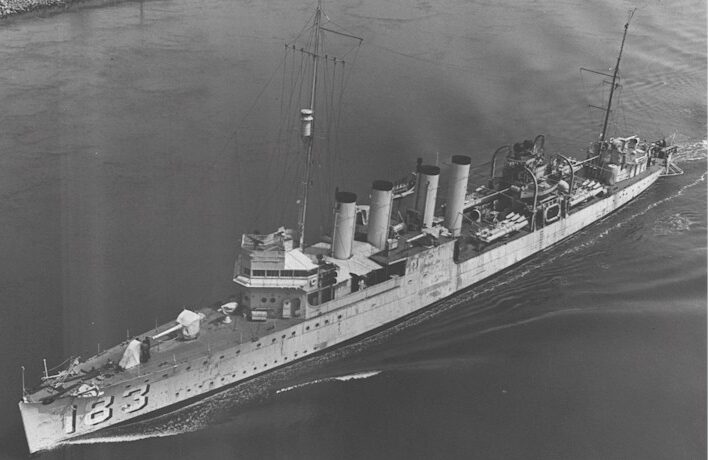
USS Haradencommissioned Norfolk 7 June 1919. HP Newport, dep. NYC 30 June 1919 for Adriatic Sea, Split, station ship at Trieste and Rijeka until 23 October 1919. Norfolk, Charleston, reserve destroyer division until 15 March 1921. Philadelphia decom. 17 July 1922 to 4 December 1939. Neutrality patrol Cuban waters, Block Island, Nantucket, three training cruises, 18 September Halifax, decom. 24 September 1940, transferred RCN as HMCS Columbia. 25 February 1944 struck a cliff in foul weather off Newfoundland. Unrepaired, stricken August 1945, sold.
 Abbot (DD-184)
Abbot (DD-184)
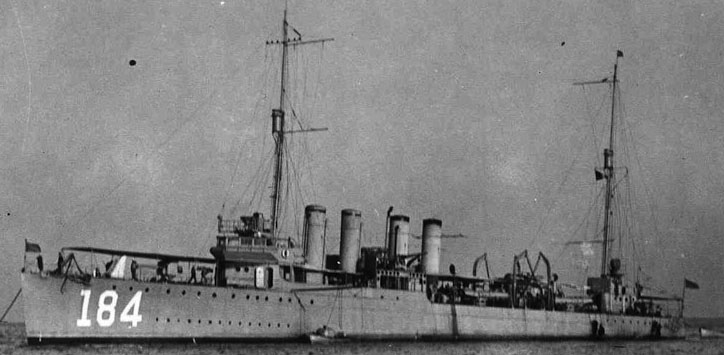
USS Abbot commissioned on 19 July 1919, Norfolk, east coast-Gulf Mexico-Caribbean, decom. Philadelphia 5 July 1922, recom. 17 June 1940, neutrality patrols. Decom. Halifax 23 September 1940, transferred as HMS Charlestown. Collision with minesweeper HMS Florizel December 1944, unrepaired, reserve at Grangemouth, decom. 15 January 1945n scrapped.
 Bagley (DD-185)
Bagley (DD-185)
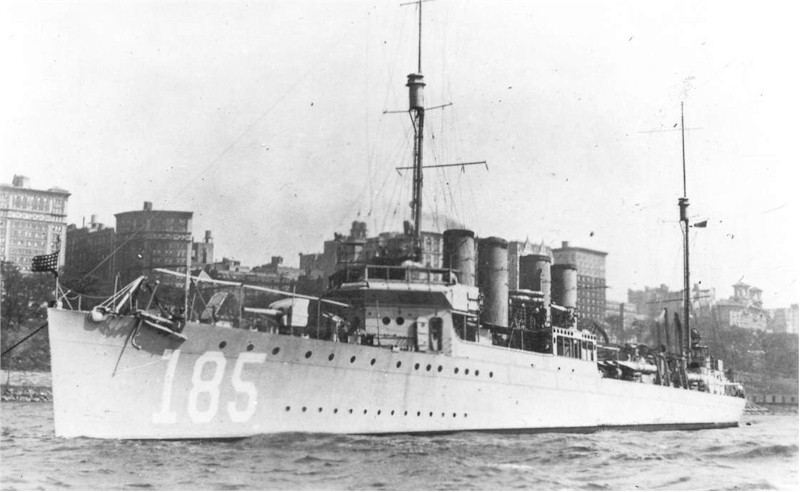
USS Bagley commissioned 27 August 1919, Atlantic Fleet. August 1919-July 1920 DesFlot 1, 3, 8. Reserve commission 16 July 1920, decom. Philadelphia 12 July 1922, loaned CG 25 April 1932–20 April 1934. Renamed “USS Doran” 22 December 1939, recom. 17 June 1940 Atlantic Sqn. until 22 September 1940, Halifax, decom. transferred as HMS St. Mary. PO February 1944 Tyne, scrapped 1945.

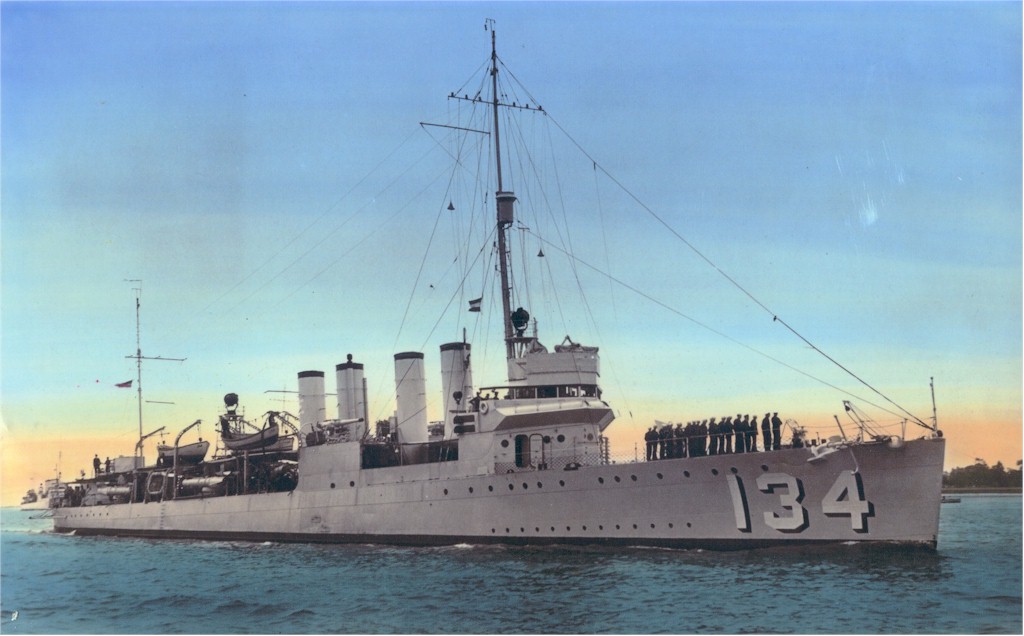
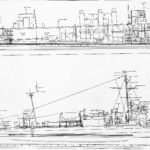
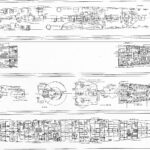
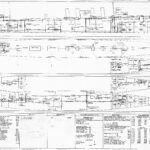
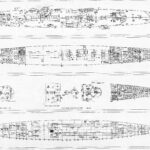
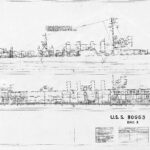
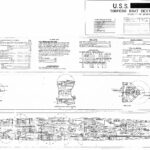
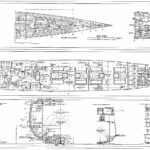
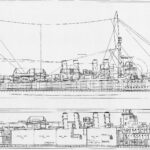
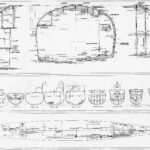
 Latest Facebook Entry -
Latest Facebook Entry -  X(Tweeter) Naval Encyclopedia's deck archive
X(Tweeter) Naval Encyclopedia's deck archive Instagram (@navalencyc)
Instagram (@navalencyc)





 French Navy
French Navy Royal Navy
Royal Navy Russian Navy
Russian Navy Armada Espanola
Armada Espanola Austrian Navy
Austrian Navy K.u.K. Kriegsmarine
K.u.K. Kriegsmarine Dansk Marine
Dansk Marine Nautiko Hellenon
Nautiko Hellenon Koninklije Marine 1870
Koninklije Marine 1870 Marinha do Brasil
Marinha do Brasil Osmanlı Donanması
Osmanlı Donanması Marina Do Peru
Marina Do Peru Marinha do Portugal
Marinha do Portugal Regia Marina 1870
Regia Marina 1870 Nihhon Kaigun 1870
Nihhon Kaigun 1870 Preußische Marine 1870
Preußische Marine 1870 Russkiy Flot 1870
Russkiy Flot 1870 Svenska marinen
Svenska marinen Søværnet
Søværnet Union Navy
Union Navy Confederate Navy
Confederate Navy Armada de Argentina
Armada de Argentina Imperial Chinese Navy
Imperial Chinese Navy Marinha do Portugal
Marinha do Portugal Mexico
Mexico Kaiserliche Marine
Kaiserliche Marine 1898 US Navy
1898 US Navy Sovietskiy Flot
Sovietskiy Flot Royal Canadian Navy
Royal Canadian Navy Royal Australian Navy
Royal Australian Navy RNZN Fleet
RNZN Fleet Chinese Navy 1937
Chinese Navy 1937 Kriegsmarine
Kriegsmarine Chilean Navy
Chilean Navy Danish Navy
Danish Navy Finnish Navy
Finnish Navy Hellenic Navy
Hellenic Navy Polish Navy
Polish Navy Romanian Navy
Romanian Navy Turkish Navy
Turkish Navy Royal Yugoslav Navy
Royal Yugoslav Navy Royal Thai Navy
Royal Thai Navy Minor Navies
Minor Navies Albania
Albania Austria
Austria Belgium
Belgium Columbia
Columbia Costa Rica
Costa Rica Cuba
Cuba Czechoslovakia
Czechoslovakia Dominican Republic
Dominican Republic Haiti
Haiti Hungary
Hungary Honduras
Honduras Estonia
Estonia Iceland
Iceland Eire
Eire Equador
Equador Iran
Iran Iraq
Iraq Latvia
Latvia Liberia
Liberia Lithuania
Lithuania Mandchukuo
Mandchukuo Morocco
Morocco Nicaragua
Nicaragua Persia
Persia San Salvador
San Salvador Sarawak
Sarawak Uruguay
Uruguay Venezuela
Venezuela Zanzibar
Zanzibar Warsaw Pact Navies
Warsaw Pact Navies Bulgaria
Bulgaria Hungary
Hungary

 Bundesmarine
Bundesmarine Dutch Navy
Dutch Navy Hellenic Navy
Hellenic Navy Marina Militare
Marina Militare Yugoslav Navy
Yugoslav Navy Chinese Navy
Chinese Navy Indian Navy
Indian Navy Indonesian Navy
Indonesian Navy JMSDF
JMSDF North Korean Navy
North Korean Navy Pakistani Navy
Pakistani Navy Philippines Navy
Philippines Navy ROKN
ROKN Rep. of Singapore Navy
Rep. of Singapore Navy Taiwanese Navy
Taiwanese Navy IDF Navy
IDF Navy Saudi Navy
Saudi Navy Royal New Zealand Navy
Royal New Zealand Navy Egyptian Navy
Egyptian Navy South African Navy
South African Navy






























 Ukrainian Navy
Ukrainian Navy dbodesign
dbodesign
USS Stringham is DD83
USS Dyer is Dd84
Well spotted, fixed thanks !